Program Design and Implementation Guide for CHC50113 Diploma of Early Childhood Education and Care
VerifiedAdded on 2023/04/24
|78
|14103
|169
AI Summary
In this document we will discuss about Program Design and Implementation Guid and below are the summary points of this document:-
Program design and implementation guide with version control and document history.
Instructions and principles of competency-based assessment in early childhood education.
Assessment methods, resources, and projects for the Diploma of Early Childhood Education and Care.
Contribute Materials
Your contribution can guide someone’s learning journey. Share your
documents today.
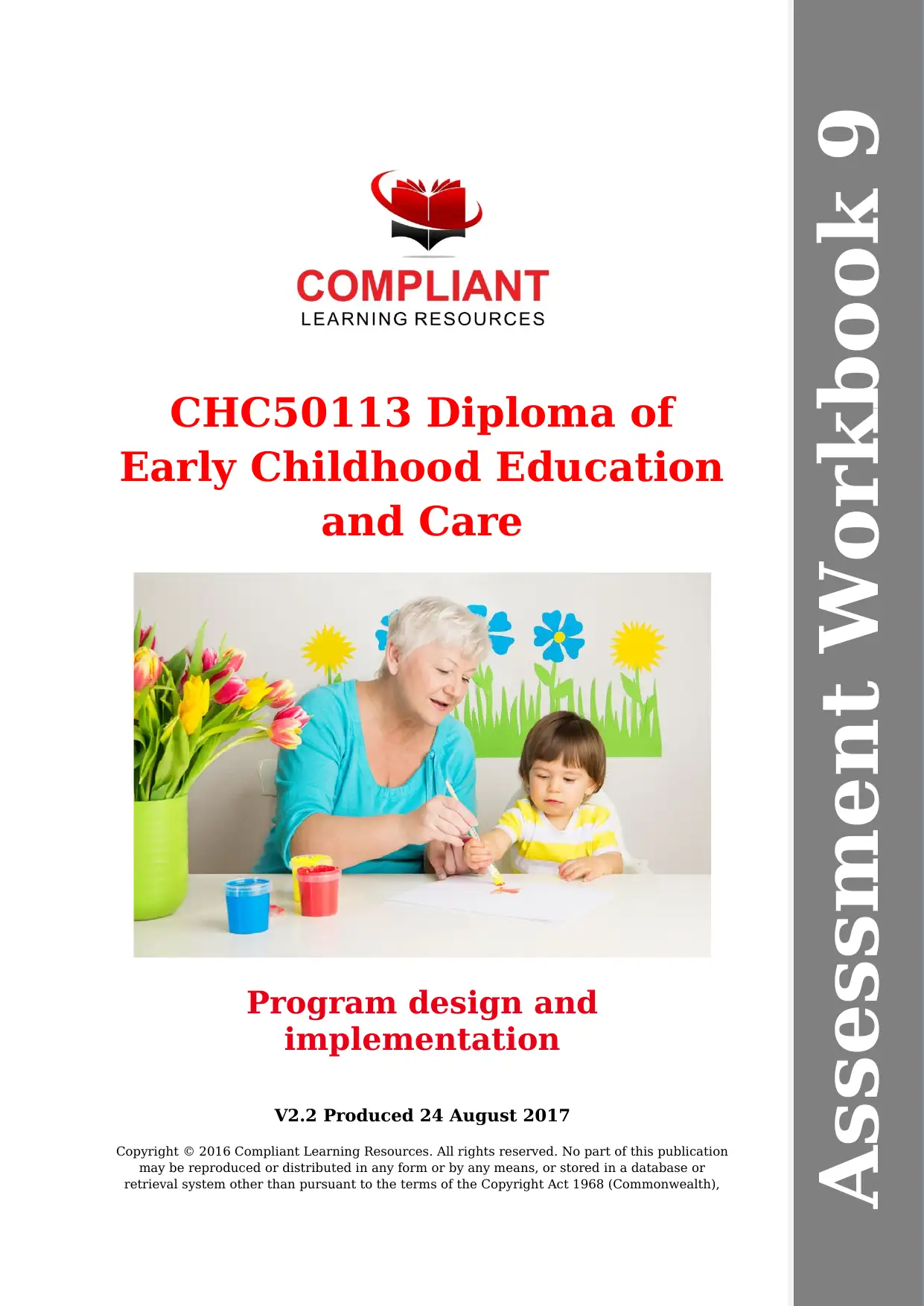
CHC50113 Diploma of
Early Childhood Education
and Care
Program design and
implementation
V2.2 Produced 24 August 2017
Copyright © 2016 Compliant Learning Resources. All rights reserved. No part of this publication
may be reproduced or distributed in any form or by any means, or stored in a database or
retrieval system other than pursuant to the terms of the Copyright Act 1968 (Commonwealth),
Assessment Workbook 9
Early Childhood Education
and Care
Program design and
implementation
V2.2 Produced 24 August 2017
Copyright © 2016 Compliant Learning Resources. All rights reserved. No part of this publication
may be reproduced or distributed in any form or by any means, or stored in a database or
retrieval system other than pursuant to the terms of the Copyright Act 1968 (Commonwealth),
Assessment Workbook 9
Secure Best Marks with AI Grader
Need help grading? Try our AI Grader for instant feedback on your assignments.

without the prior written permission of
Compliant Learning Resources
Assessor Guide 9 Version No. 2.2 Produced 24 August 2017
© Compliant Learning Resources Page 2
Compliant Learning Resources
Assessor Guide 9 Version No. 2.2 Produced 24 August 2017
© Compliant Learning Resources Page 2
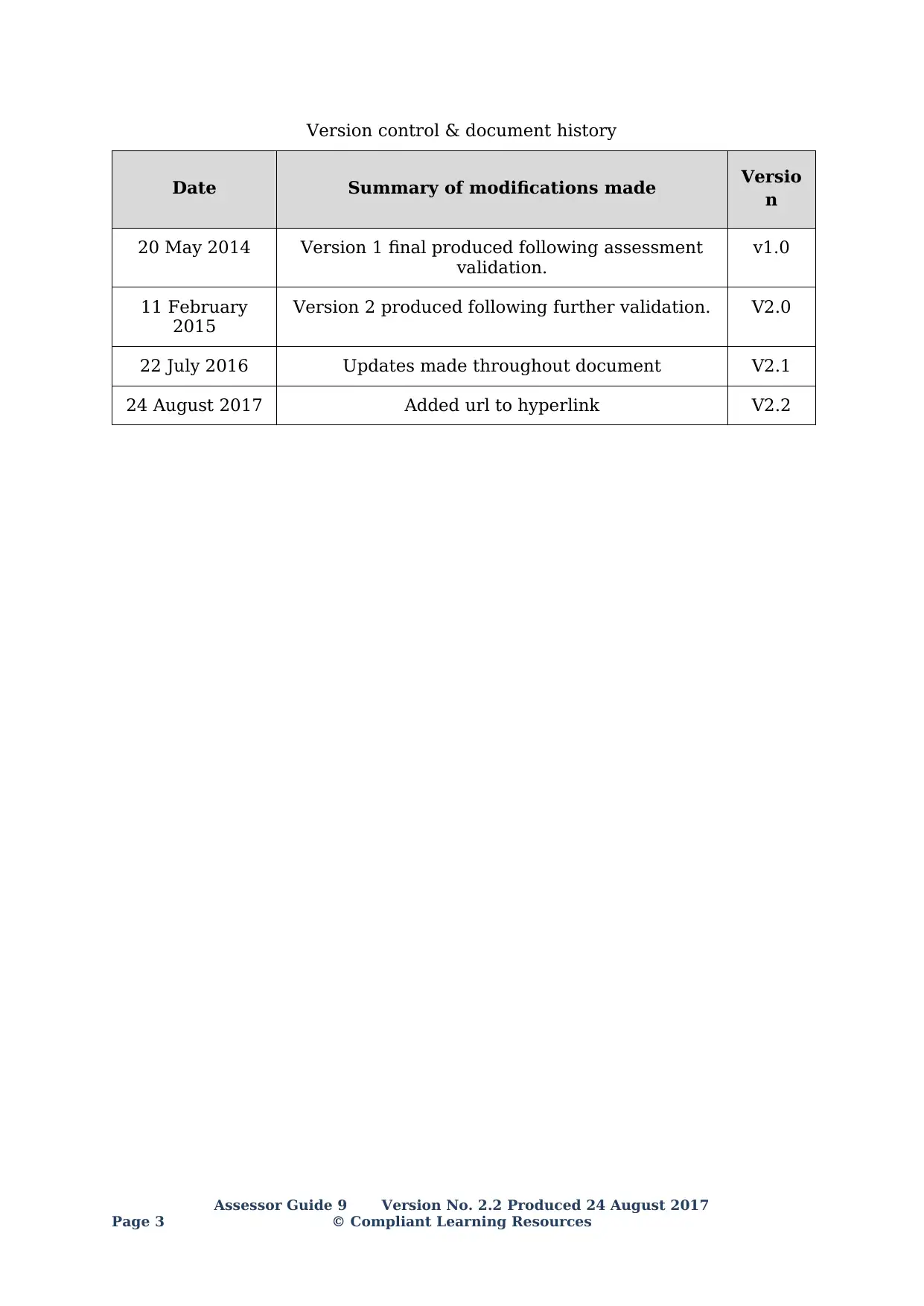
Version control & document history
Date Summary of modifications made Versio
n
20 May 2014 Version 1 final produced following assessment
validation.
v1.0
11 February
2015
Version 2 produced following further validation. V2.0
22 July 2016 Updates made throughout document V2.1
24 August 2017 Added url to hyperlink V2.2
Assessor Guide 9 Version No. 2.2 Produced 24 August 2017
Page 3 © Compliant Learning Resources
Date Summary of modifications made Versio
n
20 May 2014 Version 1 final produced following assessment
validation.
v1.0
11 February
2015
Version 2 produced following further validation. V2.0
22 July 2016 Updates made throughout document V2.1
24 August 2017 Added url to hyperlink V2.2
Assessor Guide 9 Version No. 2.2 Produced 24 August 2017
Page 3 © Compliant Learning Resources
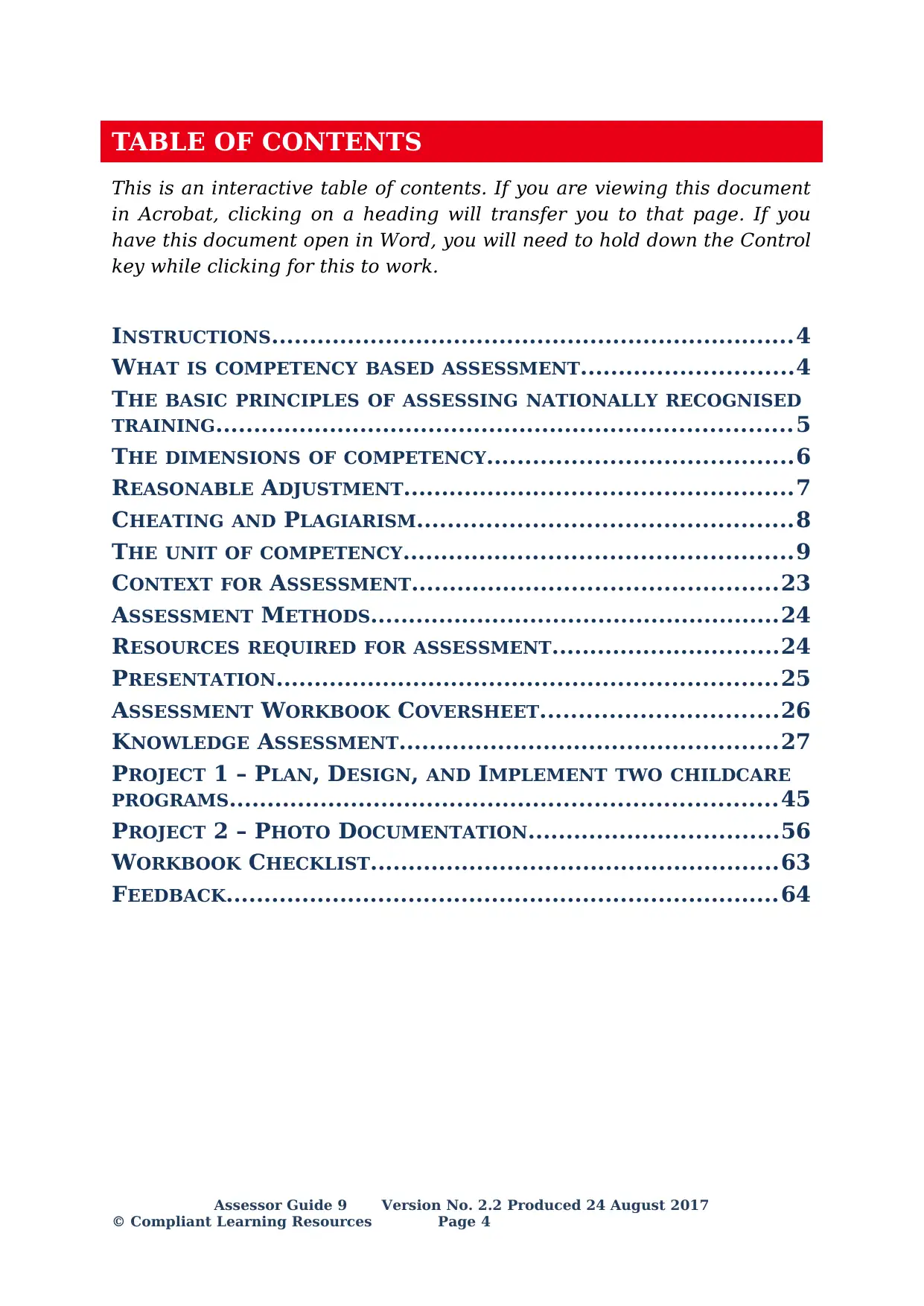
TABLE OF CONTENTS
This is an interactive table of contents. If you are viewing this document
in Acrobat, clicking on a heading will transfer you to that page. If you
have this document open in Word, you will need to hold down the Control
key while clicking for this to work.
INSTRUCTIONS.....................................................................4
WHAT IS COMPETENCY BASED ASSESSMENT............................4
THE BASIC PRINCIPLES OF ASSESSING NATIONALLY RECOGNISED
TRAINING............................................................................5
THE DIMENSIONS OF COMPETENCY........................................6
REASONABLE ADJUSTMENT...................................................7
CHEATING AND PLAGIARISM.................................................8
THE UNIT OF COMPETENCY...................................................9
CONTEXT FOR ASSESSMENT................................................23
ASSESSMENT METHODS......................................................24
RESOURCES REQUIRED FOR ASSESSMENT..............................24
PRESENTATION..................................................................25
ASSESSMENT WORKBOOK COVERSHEET...............................26
KNOWLEDGE ASSESSMENT..................................................27
PROJECT 1 – PLAN, DESIGN, AND IMPLEMENT TWO CHILDCARE
PROGRAMS........................................................................45
PROJECT 2 – PHOTO DOCUMENTATION.................................56
WORKBOOK CHECKLIST......................................................63
FEEDBACK.........................................................................64
Assessor Guide 9 Version No. 2.2 Produced 24 August 2017
© Compliant Learning Resources Page 4
This is an interactive table of contents. If you are viewing this document
in Acrobat, clicking on a heading will transfer you to that page. If you
have this document open in Word, you will need to hold down the Control
key while clicking for this to work.
INSTRUCTIONS.....................................................................4
WHAT IS COMPETENCY BASED ASSESSMENT............................4
THE BASIC PRINCIPLES OF ASSESSING NATIONALLY RECOGNISED
TRAINING............................................................................5
THE DIMENSIONS OF COMPETENCY........................................6
REASONABLE ADJUSTMENT...................................................7
CHEATING AND PLAGIARISM.................................................8
THE UNIT OF COMPETENCY...................................................9
CONTEXT FOR ASSESSMENT................................................23
ASSESSMENT METHODS......................................................24
RESOURCES REQUIRED FOR ASSESSMENT..............................24
PRESENTATION..................................................................25
ASSESSMENT WORKBOOK COVERSHEET...............................26
KNOWLEDGE ASSESSMENT..................................................27
PROJECT 1 – PLAN, DESIGN, AND IMPLEMENT TWO CHILDCARE
PROGRAMS........................................................................45
PROJECT 2 – PHOTO DOCUMENTATION.................................56
WORKBOOK CHECKLIST......................................................63
FEEDBACK.........................................................................64
Assessor Guide 9 Version No. 2.2 Produced 24 August 2017
© Compliant Learning Resources Page 4
Secure Best Marks with AI Grader
Need help grading? Try our AI Grader for instant feedback on your assignments.
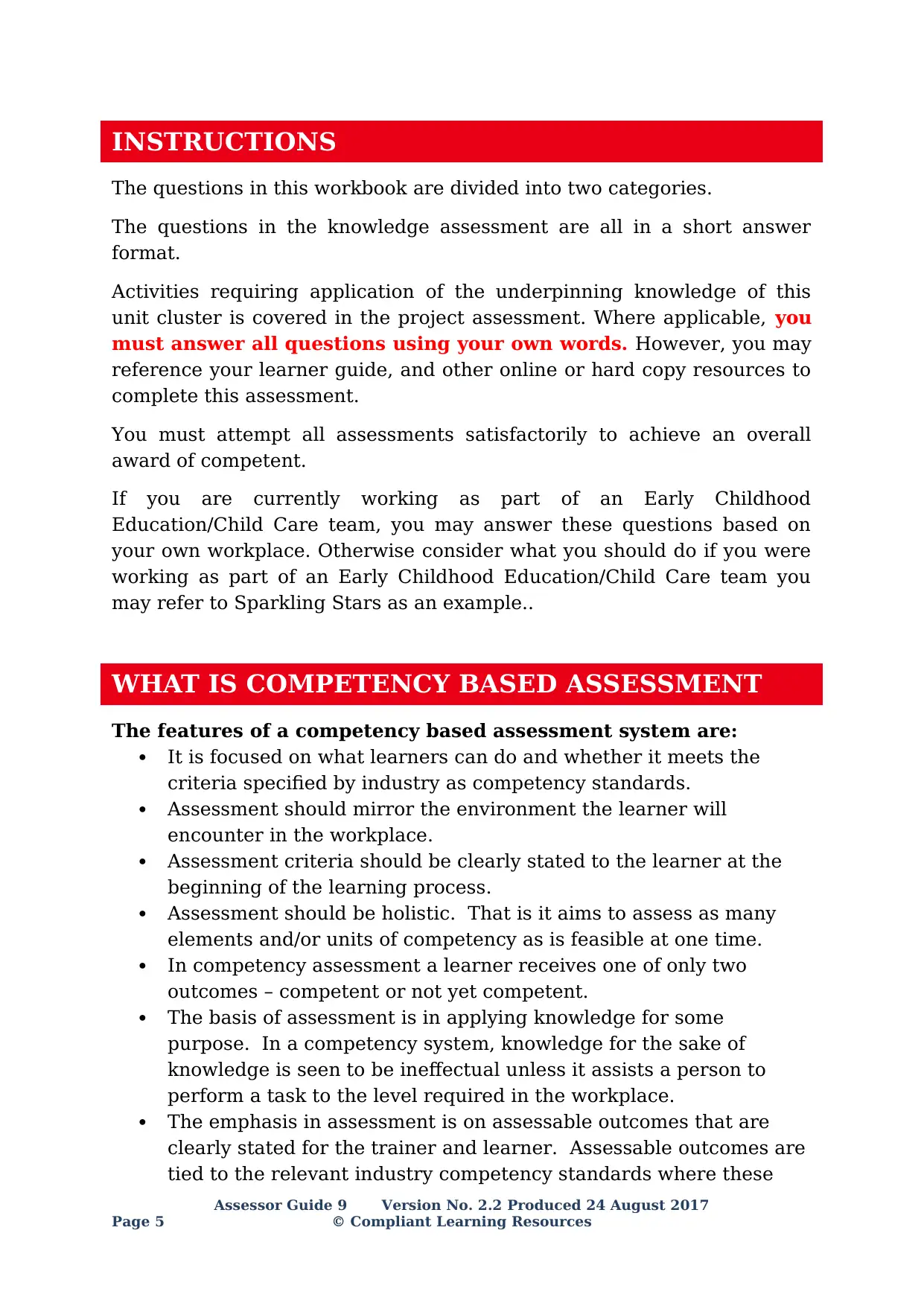
INSTRUCTIONS
The questions in this workbook are divided into two categories.
The questions in the knowledge assessment are all in a short answer
format.
Activities requiring application of the underpinning knowledge of this
unit cluster is covered in the project assessment. Where applicable, you
must answer all questions using your own words. However, you may
reference your learner guide, and other online or hard copy resources to
complete this assessment.
You must attempt all assessments satisfactorily to achieve an overall
award of competent.
If you are currently working as part of an Early Childhood
Education/Child Care team, you may answer these questions based on
your own workplace. Otherwise consider what you should do if you were
working as part of an Early Childhood Education/Child Care team you
may refer to Sparkling Stars as an example..
WHAT IS COMPETENCY BASED ASSESSMENT
The features of a competency based assessment system are:
It is focused on what learners can do and whether it meets the
criteria specified by industry as competency standards.
Assessment should mirror the environment the learner will
encounter in the workplace.
Assessment criteria should be clearly stated to the learner at the
beginning of the learning process.
Assessment should be holistic. That is it aims to assess as many
elements and/or units of competency as is feasible at one time.
In competency assessment a learner receives one of only two
outcomes – competent or not yet competent.
The basis of assessment is in applying knowledge for some
purpose. In a competency system, knowledge for the sake of
knowledge is seen to be ineffectual unless it assists a person to
perform a task to the level required in the workplace.
The emphasis in assessment is on assessable outcomes that are
clearly stated for the trainer and learner. Assessable outcomes are
tied to the relevant industry competency standards where these
Assessor Guide 9 Version No. 2.2 Produced 24 August 2017
Page 5 © Compliant Learning Resources
The questions in this workbook are divided into two categories.
The questions in the knowledge assessment are all in a short answer
format.
Activities requiring application of the underpinning knowledge of this
unit cluster is covered in the project assessment. Where applicable, you
must answer all questions using your own words. However, you may
reference your learner guide, and other online or hard copy resources to
complete this assessment.
You must attempt all assessments satisfactorily to achieve an overall
award of competent.
If you are currently working as part of an Early Childhood
Education/Child Care team, you may answer these questions based on
your own workplace. Otherwise consider what you should do if you were
working as part of an Early Childhood Education/Child Care team you
may refer to Sparkling Stars as an example..
WHAT IS COMPETENCY BASED ASSESSMENT
The features of a competency based assessment system are:
It is focused on what learners can do and whether it meets the
criteria specified by industry as competency standards.
Assessment should mirror the environment the learner will
encounter in the workplace.
Assessment criteria should be clearly stated to the learner at the
beginning of the learning process.
Assessment should be holistic. That is it aims to assess as many
elements and/or units of competency as is feasible at one time.
In competency assessment a learner receives one of only two
outcomes – competent or not yet competent.
The basis of assessment is in applying knowledge for some
purpose. In a competency system, knowledge for the sake of
knowledge is seen to be ineffectual unless it assists a person to
perform a task to the level required in the workplace.
The emphasis in assessment is on assessable outcomes that are
clearly stated for the trainer and learner. Assessable outcomes are
tied to the relevant industry competency standards where these
Assessor Guide 9 Version No. 2.2 Produced 24 August 2017
Page 5 © Compliant Learning Resources
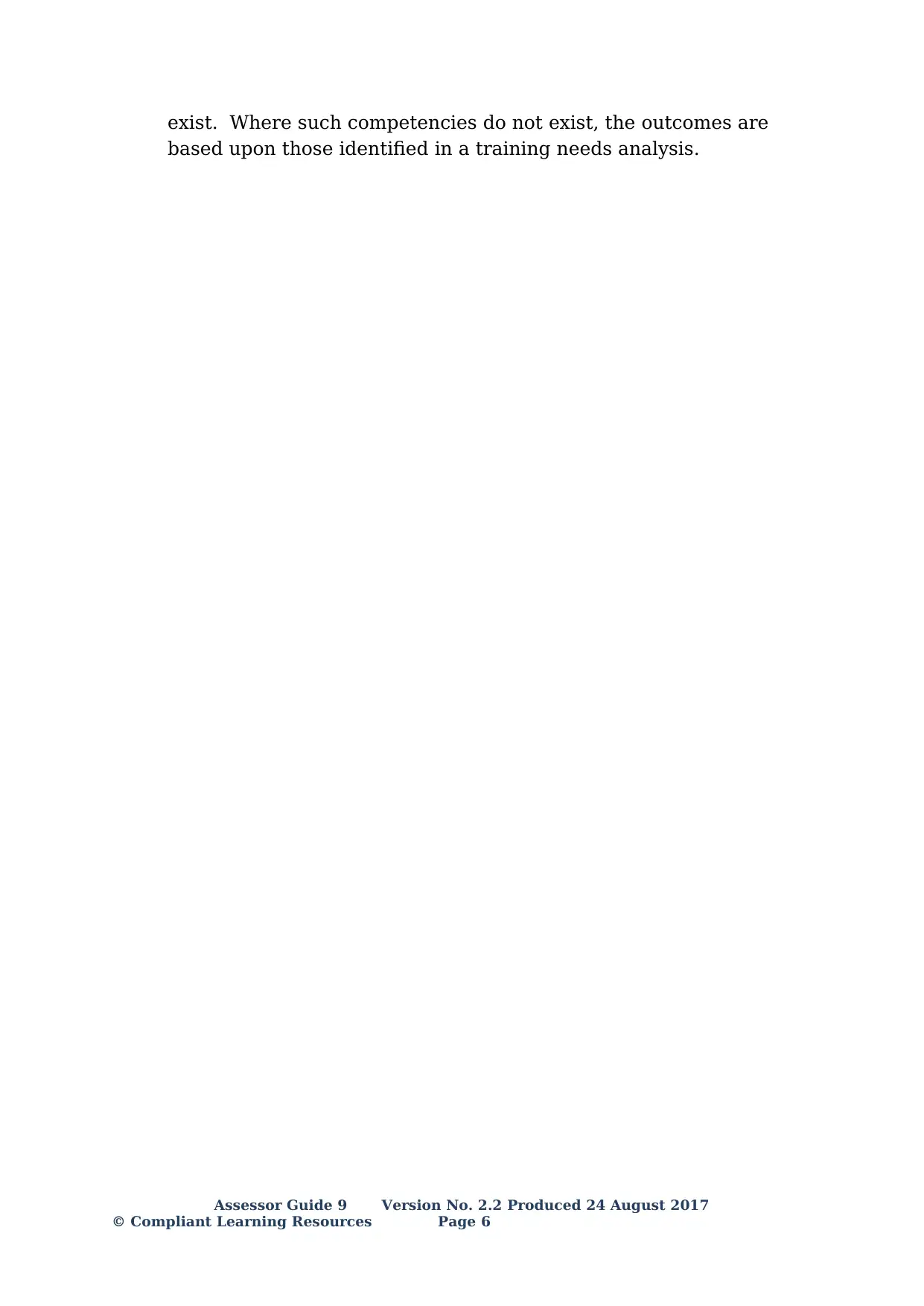
exist. Where such competencies do not exist, the outcomes are
based upon those identified in a training needs analysis.
Assessor Guide 9 Version No. 2.2 Produced 24 August 2017
© Compliant Learning Resources Page 6
based upon those identified in a training needs analysis.
Assessor Guide 9 Version No. 2.2 Produced 24 August 2017
© Compliant Learning Resources Page 6
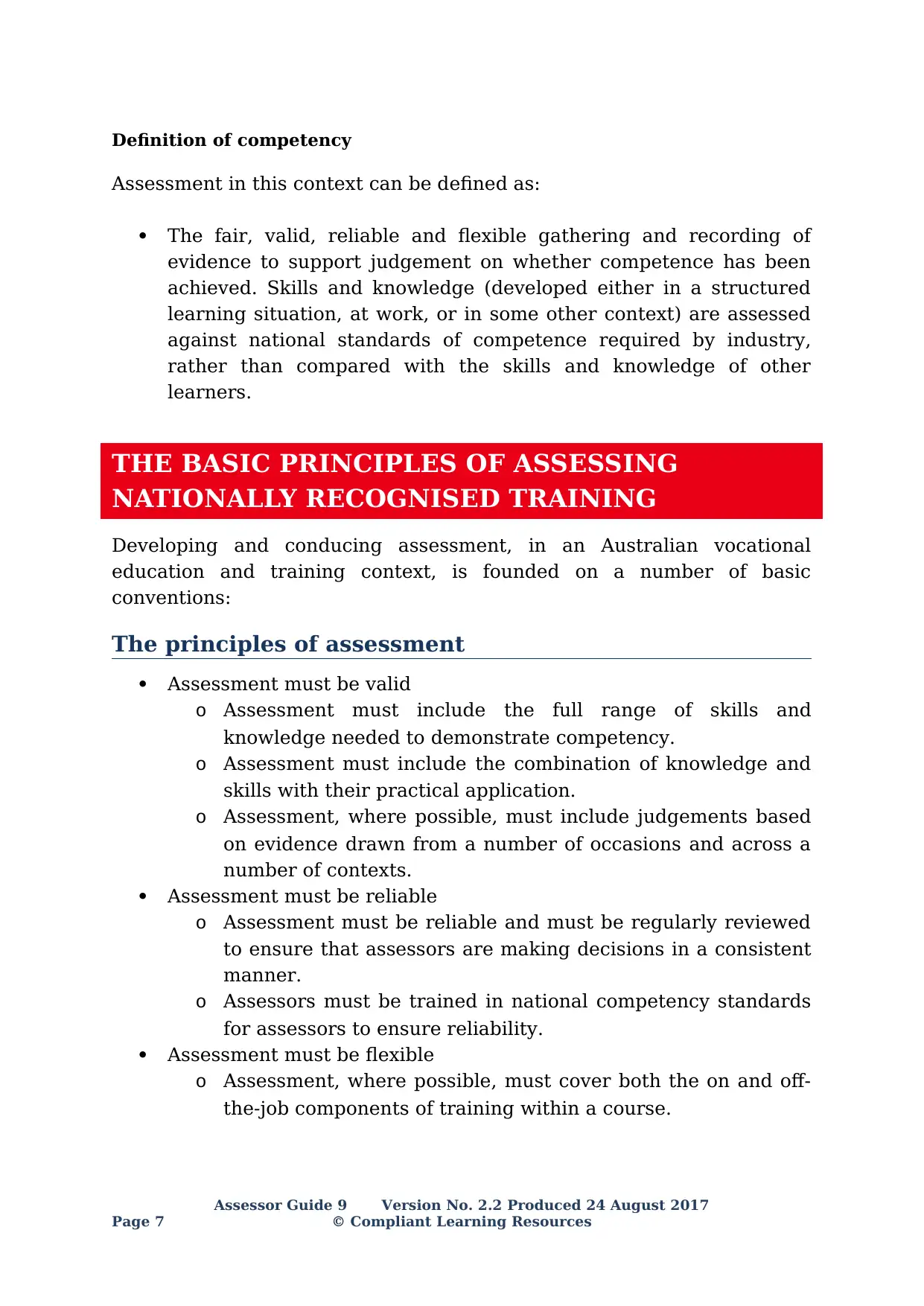
Definition of competency
Assessment in this context can be defined as:
The fair, valid, reliable and flexible gathering and recording of
evidence to support judgement on whether competence has been
achieved. Skills and knowledge (developed either in a structured
learning situation, at work, or in some other context) are assessed
against national standards of competence required by industry,
rather than compared with the skills and knowledge of other
learners.
THE BASIC PRINCIPLES OF ASSESSING
NATIONALLY RECOGNISED TRAINING
Developing and conducing assessment, in an Australian vocational
education and training context, is founded on a number of basic
conventions:
The principles of assessment
Assessment must be valid
o Assessment must include the full range of skills and
knowledge needed to demonstrate competency.
o Assessment must include the combination of knowledge and
skills with their practical application.
o Assessment, where possible, must include judgements based
on evidence drawn from a number of occasions and across a
number of contexts.
Assessment must be reliable
o Assessment must be reliable and must be regularly reviewed
to ensure that assessors are making decisions in a consistent
manner.
o Assessors must be trained in national competency standards
for assessors to ensure reliability.
Assessment must be flexible
o Assessment, where possible, must cover both the on and off-
the-job components of training within a course.
Assessor Guide 9 Version No. 2.2 Produced 24 August 2017
Page 7 © Compliant Learning Resources
Assessment in this context can be defined as:
The fair, valid, reliable and flexible gathering and recording of
evidence to support judgement on whether competence has been
achieved. Skills and knowledge (developed either in a structured
learning situation, at work, or in some other context) are assessed
against national standards of competence required by industry,
rather than compared with the skills and knowledge of other
learners.
THE BASIC PRINCIPLES OF ASSESSING
NATIONALLY RECOGNISED TRAINING
Developing and conducing assessment, in an Australian vocational
education and training context, is founded on a number of basic
conventions:
The principles of assessment
Assessment must be valid
o Assessment must include the full range of skills and
knowledge needed to demonstrate competency.
o Assessment must include the combination of knowledge and
skills with their practical application.
o Assessment, where possible, must include judgements based
on evidence drawn from a number of occasions and across a
number of contexts.
Assessment must be reliable
o Assessment must be reliable and must be regularly reviewed
to ensure that assessors are making decisions in a consistent
manner.
o Assessors must be trained in national competency standards
for assessors to ensure reliability.
Assessment must be flexible
o Assessment, where possible, must cover both the on and off-
the-job components of training within a course.
Assessor Guide 9 Version No. 2.2 Produced 24 August 2017
Page 7 © Compliant Learning Resources
Paraphrase This Document
Need a fresh take? Get an instant paraphrase of this document with our AI Paraphraser

o Assessment must provide for the recognition of knowledge,
skills and attitudes regardless of how they have been
acquired.
o Assessment must be made accessible to learners though a
variety of delivery modes, so they can proceed through
modularised training packages to gain competencies.
Assessor Guide 9 Version No. 2.2 Produced 24 August 2017
© Compliant Learning Resources Page 8
skills and attitudes regardless of how they have been
acquired.
o Assessment must be made accessible to learners though a
variety of delivery modes, so they can proceed through
modularised training packages to gain competencies.
Assessor Guide 9 Version No. 2.2 Produced 24 August 2017
© Compliant Learning Resources Page 8
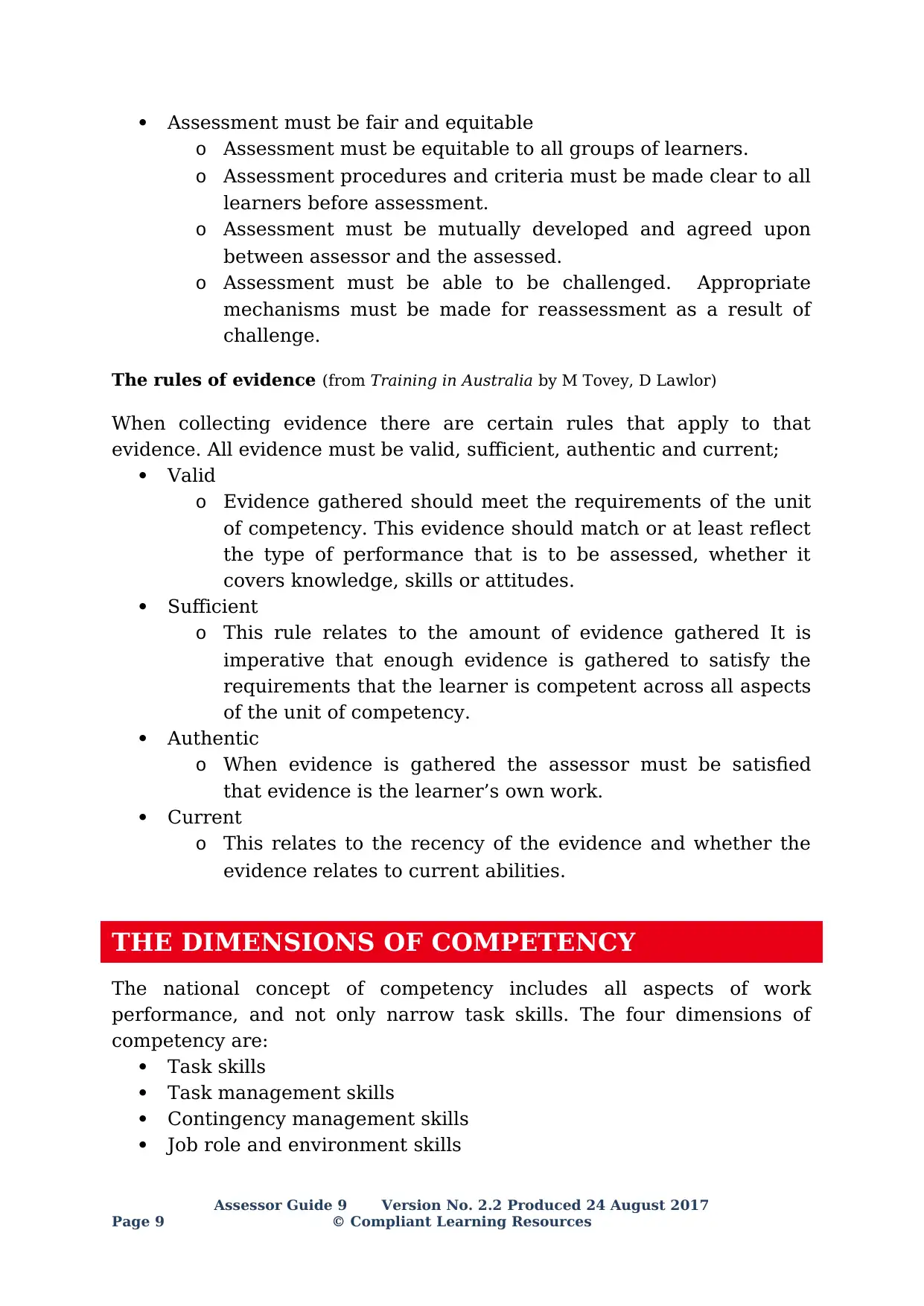
Assessment must be fair and equitable
o Assessment must be equitable to all groups of learners.
o Assessment procedures and criteria must be made clear to all
learners before assessment.
o Assessment must be mutually developed and agreed upon
between assessor and the assessed.
o Assessment must be able to be challenged. Appropriate
mechanisms must be made for reassessment as a result of
challenge.
The rules of evidence (from Training in Australia by M Tovey, D Lawlor)
When collecting evidence there are certain rules that apply to that
evidence. All evidence must be valid, sufficient, authentic and current;
Valid
o Evidence gathered should meet the requirements of the unit
of competency. This evidence should match or at least reflect
the type of performance that is to be assessed, whether it
covers knowledge, skills or attitudes.
Sufficient
o This rule relates to the amount of evidence gathered It is
imperative that enough evidence is gathered to satisfy the
requirements that the learner is competent across all aspects
of the unit of competency.
Authentic
o When evidence is gathered the assessor must be satisfied
that evidence is the learner’s own work.
Current
o This relates to the recency of the evidence and whether the
evidence relates to current abilities.
THE DIMENSIONS OF COMPETENCY
The national concept of competency includes all aspects of work
performance, and not only narrow task skills. The four dimensions of
competency are:
Task skills
Task management skills
Contingency management skills
Job role and environment skills
Assessor Guide 9 Version No. 2.2 Produced 24 August 2017
Page 9 © Compliant Learning Resources
o Assessment must be equitable to all groups of learners.
o Assessment procedures and criteria must be made clear to all
learners before assessment.
o Assessment must be mutually developed and agreed upon
between assessor and the assessed.
o Assessment must be able to be challenged. Appropriate
mechanisms must be made for reassessment as a result of
challenge.
The rules of evidence (from Training in Australia by M Tovey, D Lawlor)
When collecting evidence there are certain rules that apply to that
evidence. All evidence must be valid, sufficient, authentic and current;
Valid
o Evidence gathered should meet the requirements of the unit
of competency. This evidence should match or at least reflect
the type of performance that is to be assessed, whether it
covers knowledge, skills or attitudes.
Sufficient
o This rule relates to the amount of evidence gathered It is
imperative that enough evidence is gathered to satisfy the
requirements that the learner is competent across all aspects
of the unit of competency.
Authentic
o When evidence is gathered the assessor must be satisfied
that evidence is the learner’s own work.
Current
o This relates to the recency of the evidence and whether the
evidence relates to current abilities.
THE DIMENSIONS OF COMPETENCY
The national concept of competency includes all aspects of work
performance, and not only narrow task skills. The four dimensions of
competency are:
Task skills
Task management skills
Contingency management skills
Job role and environment skills
Assessor Guide 9 Version No. 2.2 Produced 24 August 2017
Page 9 © Compliant Learning Resources
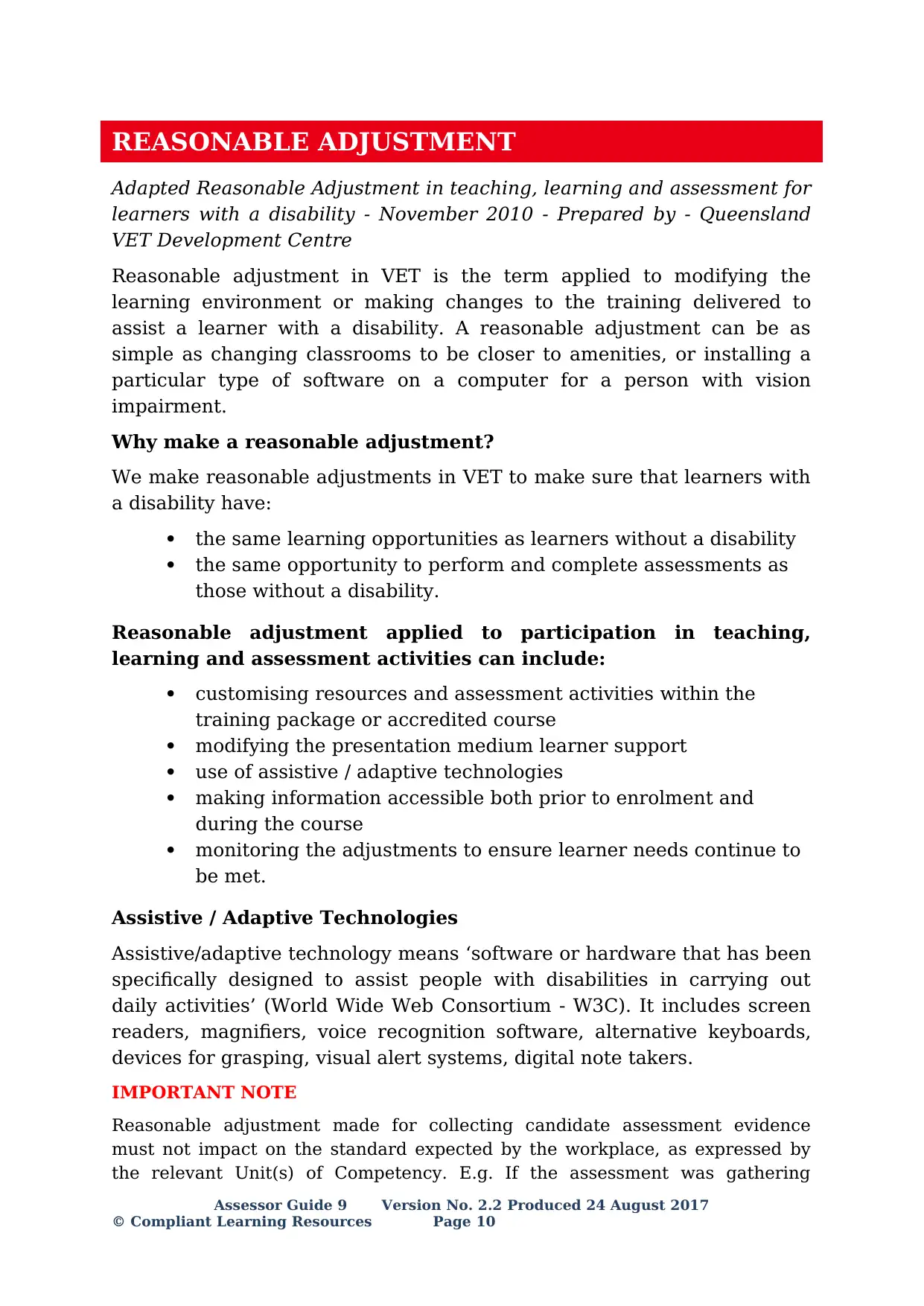
REASONABLE ADJUSTMENT
Adapted Reasonable Adjustment in teaching, learning and assessment for
learners with a disability - November 2010 - Prepared by - Queensland
VET Development Centre
Reasonable adjustment in VET is the term applied to modifying the
learning environment or making changes to the training delivered to
assist a learner with a disability. A reasonable adjustment can be as
simple as changing classrooms to be closer to amenities, or installing a
particular type of software on a computer for a person with vision
impairment.
Why make a reasonable adjustment?
We make reasonable adjustments in VET to make sure that learners with
a disability have:
the same learning opportunities as learners without a disability
the same opportunity to perform and complete assessments as
those without a disability.
Reasonable adjustment applied to participation in teaching,
learning and assessment activities can include:
customising resources and assessment activities within the
training package or accredited course
modifying the presentation medium learner support
use of assistive / adaptive technologies
making information accessible both prior to enrolment and
during the course
monitoring the adjustments to ensure learner needs continue to
be met.
Assistive / Adaptive Technologies
Assistive/adaptive technology means ‘software or hardware that has been
specifically designed to assist people with disabilities in carrying out
daily activities’ (World Wide Web Consortium - W3C). It includes screen
readers, magnifiers, voice recognition software, alternative keyboards,
devices for grasping, visual alert systems, digital note takers.
IMPORTANT NOTE
Reasonable adjustment made for collecting candidate assessment evidence
must not impact on the standard expected by the workplace, as expressed by
the relevant Unit(s) of Competency. E.g. If the assessment was gathering
Assessor Guide 9 Version No. 2.2 Produced 24 August 2017
© Compliant Learning Resources Page 10
Adapted Reasonable Adjustment in teaching, learning and assessment for
learners with a disability - November 2010 - Prepared by - Queensland
VET Development Centre
Reasonable adjustment in VET is the term applied to modifying the
learning environment or making changes to the training delivered to
assist a learner with a disability. A reasonable adjustment can be as
simple as changing classrooms to be closer to amenities, or installing a
particular type of software on a computer for a person with vision
impairment.
Why make a reasonable adjustment?
We make reasonable adjustments in VET to make sure that learners with
a disability have:
the same learning opportunities as learners without a disability
the same opportunity to perform and complete assessments as
those without a disability.
Reasonable adjustment applied to participation in teaching,
learning and assessment activities can include:
customising resources and assessment activities within the
training package or accredited course
modifying the presentation medium learner support
use of assistive / adaptive technologies
making information accessible both prior to enrolment and
during the course
monitoring the adjustments to ensure learner needs continue to
be met.
Assistive / Adaptive Technologies
Assistive/adaptive technology means ‘software or hardware that has been
specifically designed to assist people with disabilities in carrying out
daily activities’ (World Wide Web Consortium - W3C). It includes screen
readers, magnifiers, voice recognition software, alternative keyboards,
devices for grasping, visual alert systems, digital note takers.
IMPORTANT NOTE
Reasonable adjustment made for collecting candidate assessment evidence
must not impact on the standard expected by the workplace, as expressed by
the relevant Unit(s) of Competency. E.g. If the assessment was gathering
Assessor Guide 9 Version No. 2.2 Produced 24 August 2017
© Compliant Learning Resources Page 10
Secure Best Marks with AI Grader
Need help grading? Try our AI Grader for instant feedback on your assignments.
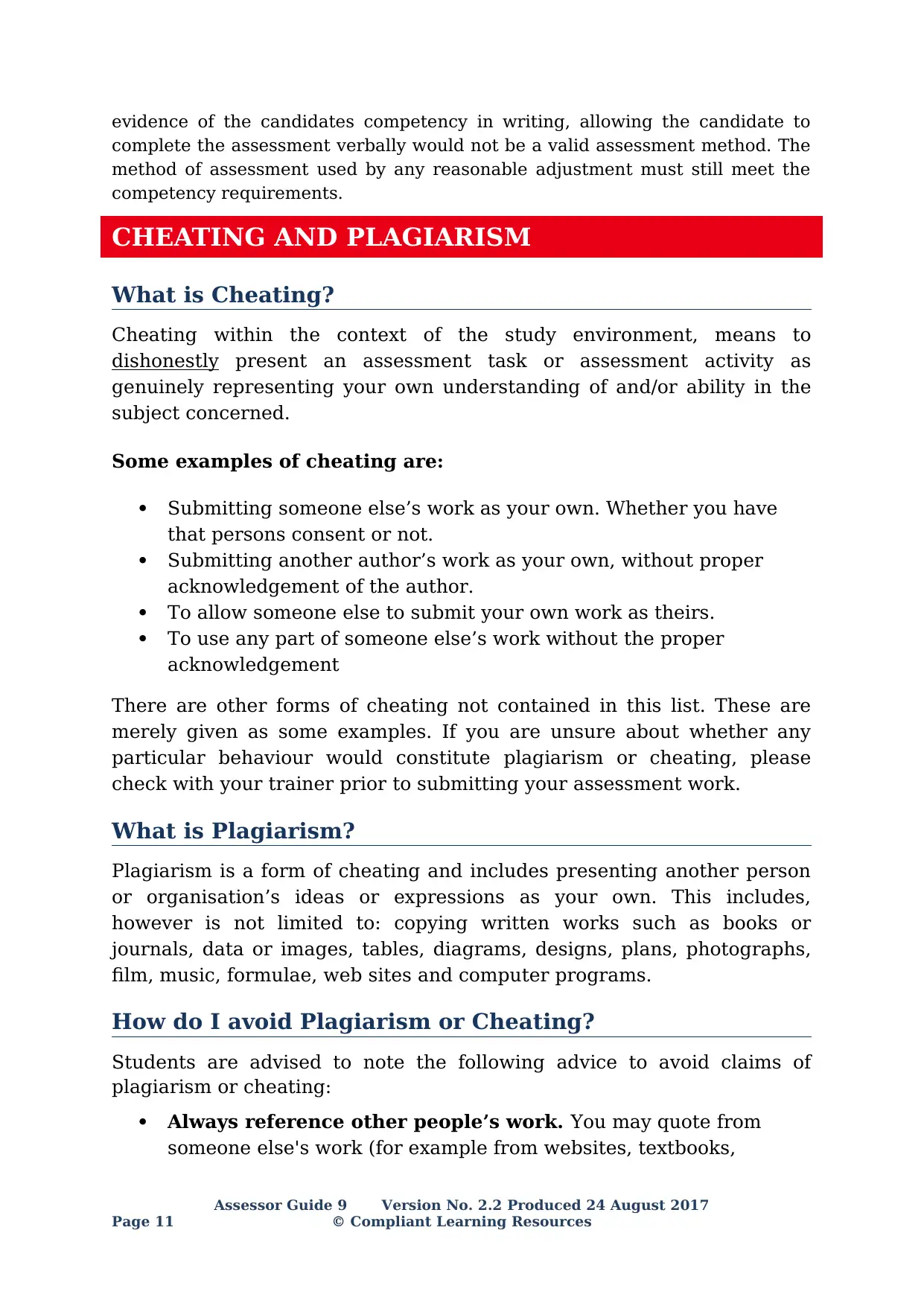
evidence of the candidates competency in writing, allowing the candidate to
complete the assessment verbally would not be a valid assessment method. The
method of assessment used by any reasonable adjustment must still meet the
competency requirements.
CHEATING AND PLAGIARISM
What is Cheating?
Cheating within the context of the study environment, means to
dishonestly present an assessment task or assessment activity as
genuinely representing your own understanding of and/or ability in the
subject concerned.
Some examples of cheating are:
Submitting someone else’s work as your own. Whether you have
that persons consent or not.
Submitting another author’s work as your own, without proper
acknowledgement of the author.
To allow someone else to submit your own work as theirs.
To use any part of someone else’s work without the proper
acknowledgement
There are other forms of cheating not contained in this list. These are
merely given as some examples. If you are unsure about whether any
particular behaviour would constitute plagiarism or cheating, please
check with your trainer prior to submitting your assessment work.
What is Plagiarism?
Plagiarism is a form of cheating and includes presenting another person
or organisation’s ideas or expressions as your own. This includes,
however is not limited to: copying written works such as books or
journals, data or images, tables, diagrams, designs, plans, photographs,
film, music, formulae, web sites and computer programs.
How do I avoid Plagiarism or Cheating?
Students are advised to note the following advice to avoid claims of
plagiarism or cheating:
Always reference other people’s work. You may quote from
someone else's work (for example from websites, textbooks,
Assessor Guide 9 Version No. 2.2 Produced 24 August 2017
Page 11 © Compliant Learning Resources
complete the assessment verbally would not be a valid assessment method. The
method of assessment used by any reasonable adjustment must still meet the
competency requirements.
CHEATING AND PLAGIARISM
What is Cheating?
Cheating within the context of the study environment, means to
dishonestly present an assessment task or assessment activity as
genuinely representing your own understanding of and/or ability in the
subject concerned.
Some examples of cheating are:
Submitting someone else’s work as your own. Whether you have
that persons consent or not.
Submitting another author’s work as your own, without proper
acknowledgement of the author.
To allow someone else to submit your own work as theirs.
To use any part of someone else’s work without the proper
acknowledgement
There are other forms of cheating not contained in this list. These are
merely given as some examples. If you are unsure about whether any
particular behaviour would constitute plagiarism or cheating, please
check with your trainer prior to submitting your assessment work.
What is Plagiarism?
Plagiarism is a form of cheating and includes presenting another person
or organisation’s ideas or expressions as your own. This includes,
however is not limited to: copying written works such as books or
journals, data or images, tables, diagrams, designs, plans, photographs,
film, music, formulae, web sites and computer programs.
How do I avoid Plagiarism or Cheating?
Students are advised to note the following advice to avoid claims of
plagiarism or cheating:
Always reference other people’s work. You may quote from
someone else's work (for example from websites, textbooks,
Assessor Guide 9 Version No. 2.2 Produced 24 August 2017
Page 11 © Compliant Learning Resources
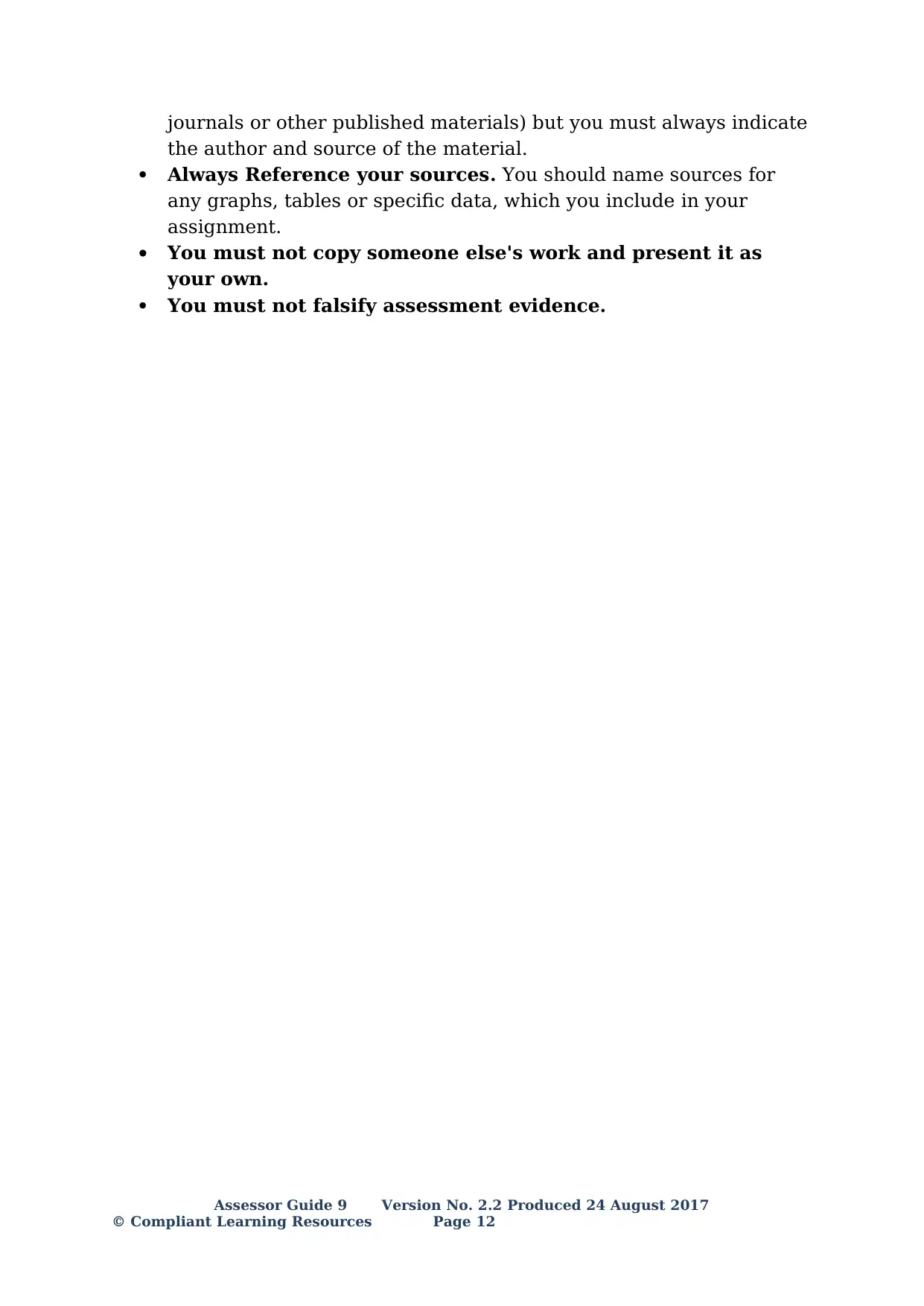
journals or other published materials) but you must always indicate
the author and source of the material.
Always Reference your sources. You should name sources for
any graphs, tables or specific data, which you include in your
assignment.
You must not copy someone else's work and present it as
your own.
You must not falsify assessment evidence.
Assessor Guide 9 Version No. 2.2 Produced 24 August 2017
© Compliant Learning Resources Page 12
the author and source of the material.
Always Reference your sources. You should name sources for
any graphs, tables or specific data, which you include in your
assignment.
You must not copy someone else's work and present it as
your own.
You must not falsify assessment evidence.
Assessor Guide 9 Version No. 2.2 Produced 24 August 2017
© Compliant Learning Resources Page 12
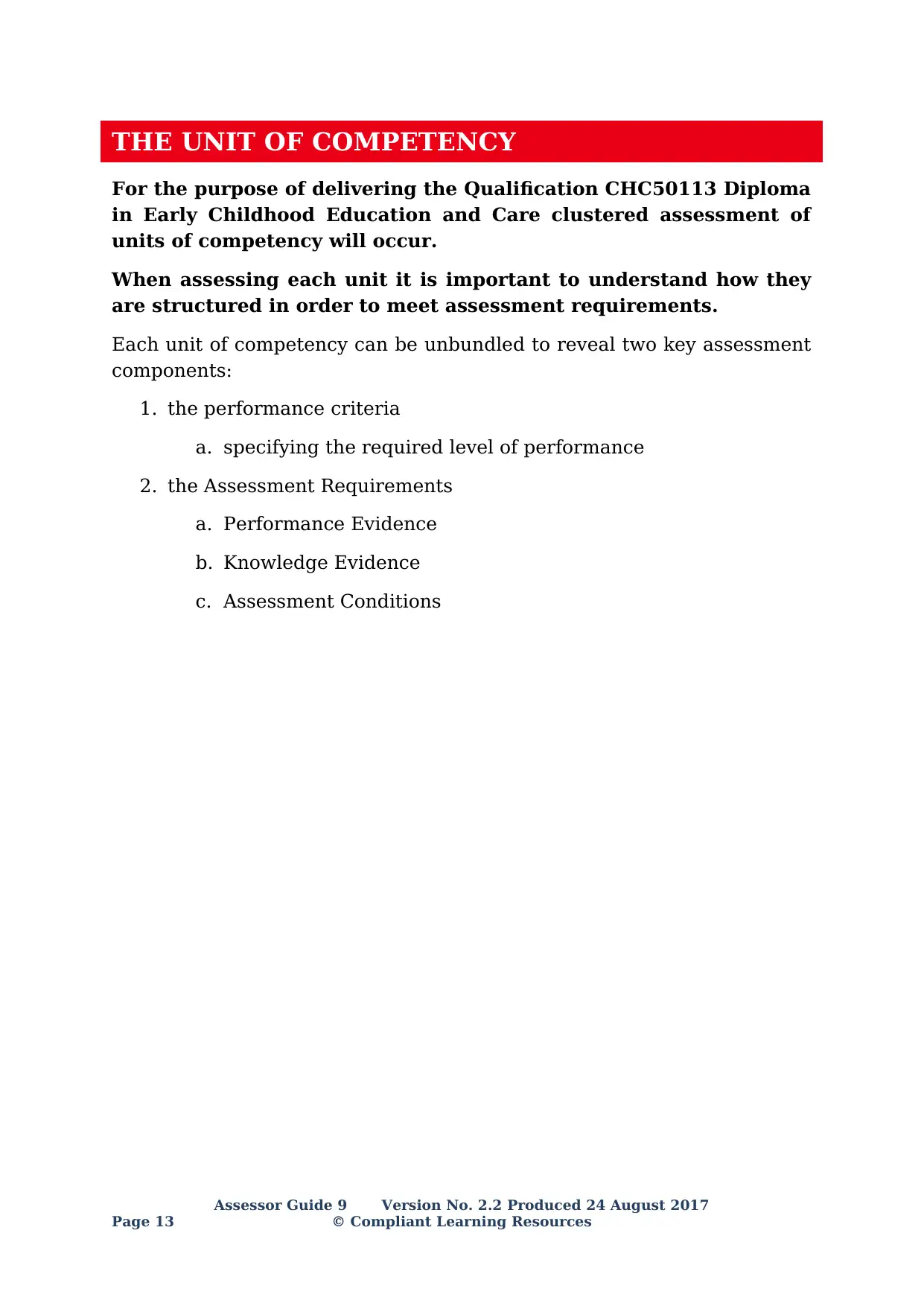
THE UNIT OF COMPETENCY
For the purpose of delivering the Qualification CHC50113 Diploma
in Early Childhood Education and Care clustered assessment of
units of competency will occur.
When assessing each unit it is important to understand how they
are structured in order to meet assessment requirements.
Each unit of competency can be unbundled to reveal two key assessment
components:
1. the performance criteria
a. specifying the required level of performance
2. the Assessment Requirements
a. Performance Evidence
b. Knowledge Evidence
c. Assessment Conditions
Assessor Guide 9 Version No. 2.2 Produced 24 August 2017
Page 13 © Compliant Learning Resources
For the purpose of delivering the Qualification CHC50113 Diploma
in Early Childhood Education and Care clustered assessment of
units of competency will occur.
When assessing each unit it is important to understand how they
are structured in order to meet assessment requirements.
Each unit of competency can be unbundled to reveal two key assessment
components:
1. the performance criteria
a. specifying the required level of performance
2. the Assessment Requirements
a. Performance Evidence
b. Knowledge Evidence
c. Assessment Conditions
Assessor Guide 9 Version No. 2.2 Produced 24 August 2017
Page 13 © Compliant Learning Resources
Paraphrase This Document
Need a fresh take? Get an instant paraphrase of this document with our AI Paraphraser
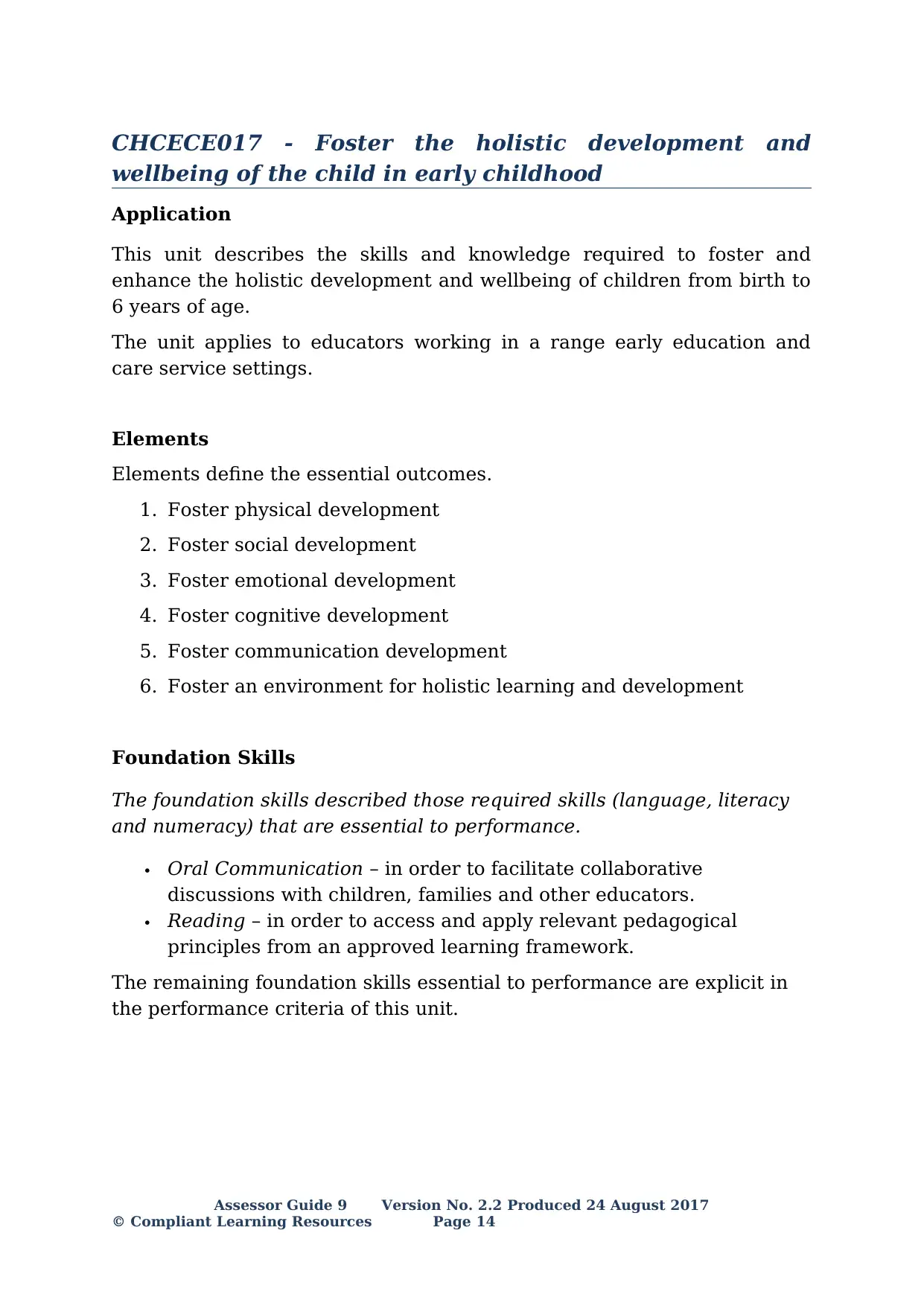
CHCECE017 - Foster the holistic development and
wellbeing of the child in early childhood
Application
This unit describes the skills and knowledge required to foster and
enhance the holistic development and wellbeing of children from birth to
6 years of age.
The unit applies to educators working in a range early education and
care service settings.
Elements
Elements define the essential outcomes.
1. Foster physical development
2. Foster social development
3. Foster emotional development
4. Foster cognitive development
5. Foster communication development
6. Foster an environment for holistic learning and development
Foundation Skills
The foundation skills described those required skills (language, literacy
and numeracy) that are essential to performance.
Oral Communication – in order to facilitate collaborative
discussions with children, families and other educators.
Reading – in order to access and apply relevant pedagogical
principles from an approved learning framework.
The remaining foundation skills essential to performance are explicit in
the performance criteria of this unit.
Assessor Guide 9 Version No. 2.2 Produced 24 August 2017
© Compliant Learning Resources Page 14
wellbeing of the child in early childhood
Application
This unit describes the skills and knowledge required to foster and
enhance the holistic development and wellbeing of children from birth to
6 years of age.
The unit applies to educators working in a range early education and
care service settings.
Elements
Elements define the essential outcomes.
1. Foster physical development
2. Foster social development
3. Foster emotional development
4. Foster cognitive development
5. Foster communication development
6. Foster an environment for holistic learning and development
Foundation Skills
The foundation skills described those required skills (language, literacy
and numeracy) that are essential to performance.
Oral Communication – in order to facilitate collaborative
discussions with children, families and other educators.
Reading – in order to access and apply relevant pedagogical
principles from an approved learning framework.
The remaining foundation skills essential to performance are explicit in
the performance criteria of this unit.
Assessor Guide 9 Version No. 2.2 Produced 24 August 2017
© Compliant Learning Resources Page 14
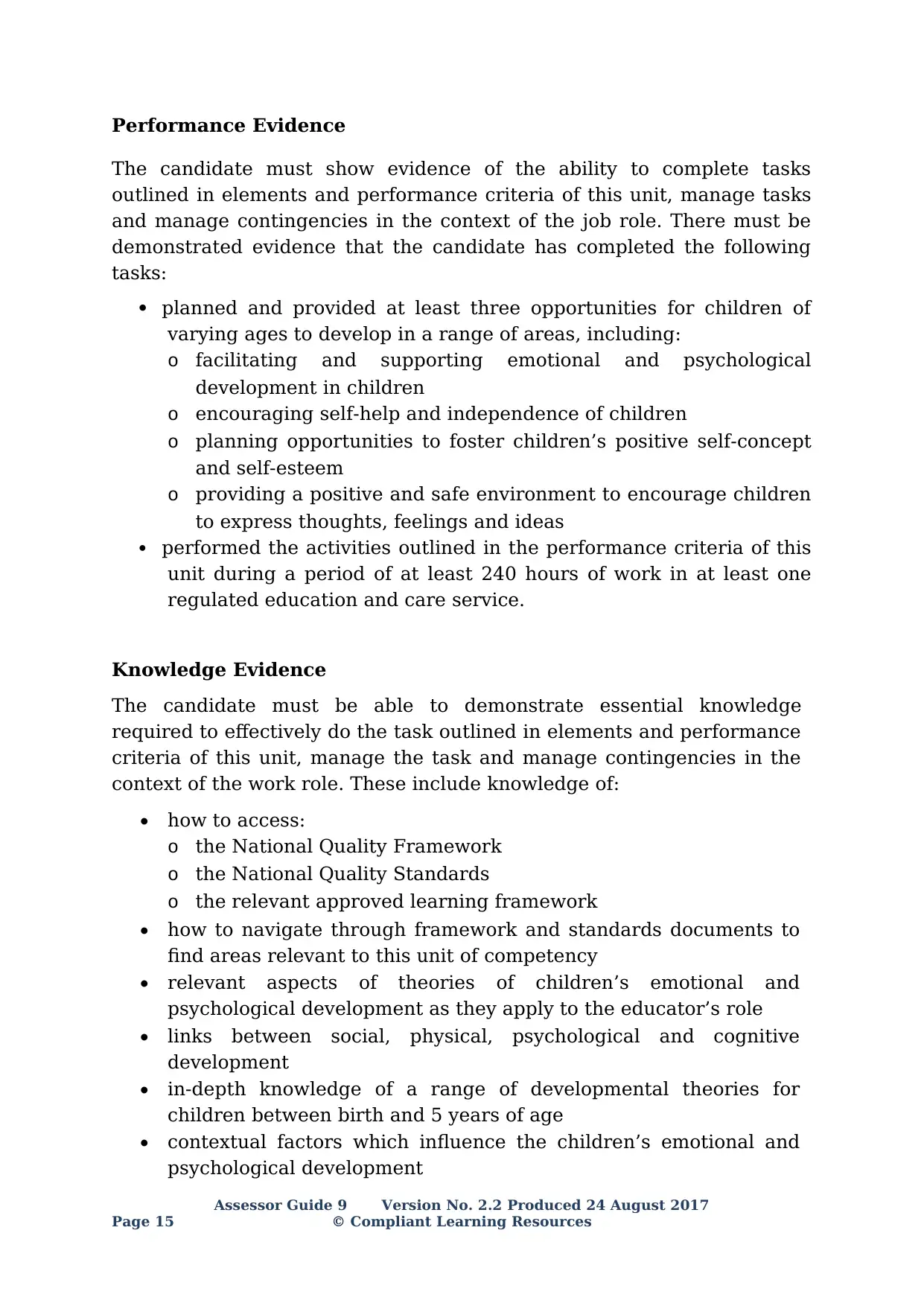
Performance Evidence
The candidate must show evidence of the ability to complete tasks
outlined in elements and performance criteria of this unit, manage tasks
and manage contingencies in the context of the job role. There must be
demonstrated evidence that the candidate has completed the following
tasks:
planned and provided at least three opportunities for children of
varying ages to develop in a range of areas, including:
o facilitating and supporting emotional and psychological
development in children
o encouraging self-help and independence of children
o planning opportunities to foster children’s positive self-concept
and self-esteem
o providing a positive and safe environment to encourage children
to express thoughts, feelings and ideas
performed the activities outlined in the performance criteria of this
unit during a period of at least 240 hours of work in at least one
regulated education and care service.
Knowledge Evidence
The candidate must be able to demonstrate essential knowledge
required to effectively do the task outlined in elements and performance
criteria of this unit, manage the task and manage contingencies in the
context of the work role. These include knowledge of:
• how to access:
o the National Quality Framework
o the National Quality Standards
o the relevant approved learning framework
• how to navigate through framework and standards documents to
find areas relevant to this unit of competency
• relevant aspects of theories of children’s emotional and
psychological development as they apply to the educator’s role
• links between social, physical, psychological and cognitive
development
• in-depth knowledge of a range of developmental theories for
children between birth and 5 years of age
• contextual factors which influence the children’s emotional and
psychological development
Assessor Guide 9 Version No. 2.2 Produced 24 August 2017
Page 15 © Compliant Learning Resources
The candidate must show evidence of the ability to complete tasks
outlined in elements and performance criteria of this unit, manage tasks
and manage contingencies in the context of the job role. There must be
demonstrated evidence that the candidate has completed the following
tasks:
planned and provided at least three opportunities for children of
varying ages to develop in a range of areas, including:
o facilitating and supporting emotional and psychological
development in children
o encouraging self-help and independence of children
o planning opportunities to foster children’s positive self-concept
and self-esteem
o providing a positive and safe environment to encourage children
to express thoughts, feelings and ideas
performed the activities outlined in the performance criteria of this
unit during a period of at least 240 hours of work in at least one
regulated education and care service.
Knowledge Evidence
The candidate must be able to demonstrate essential knowledge
required to effectively do the task outlined in elements and performance
criteria of this unit, manage the task and manage contingencies in the
context of the work role. These include knowledge of:
• how to access:
o the National Quality Framework
o the National Quality Standards
o the relevant approved learning framework
• how to navigate through framework and standards documents to
find areas relevant to this unit of competency
• relevant aspects of theories of children’s emotional and
psychological development as they apply to the educator’s role
• links between social, physical, psychological and cognitive
development
• in-depth knowledge of a range of developmental theories for
children between birth and 5 years of age
• contextual factors which influence the children’s emotional and
psychological development
Assessor Guide 9 Version No. 2.2 Produced 24 August 2017
Page 15 © Compliant Learning Resources
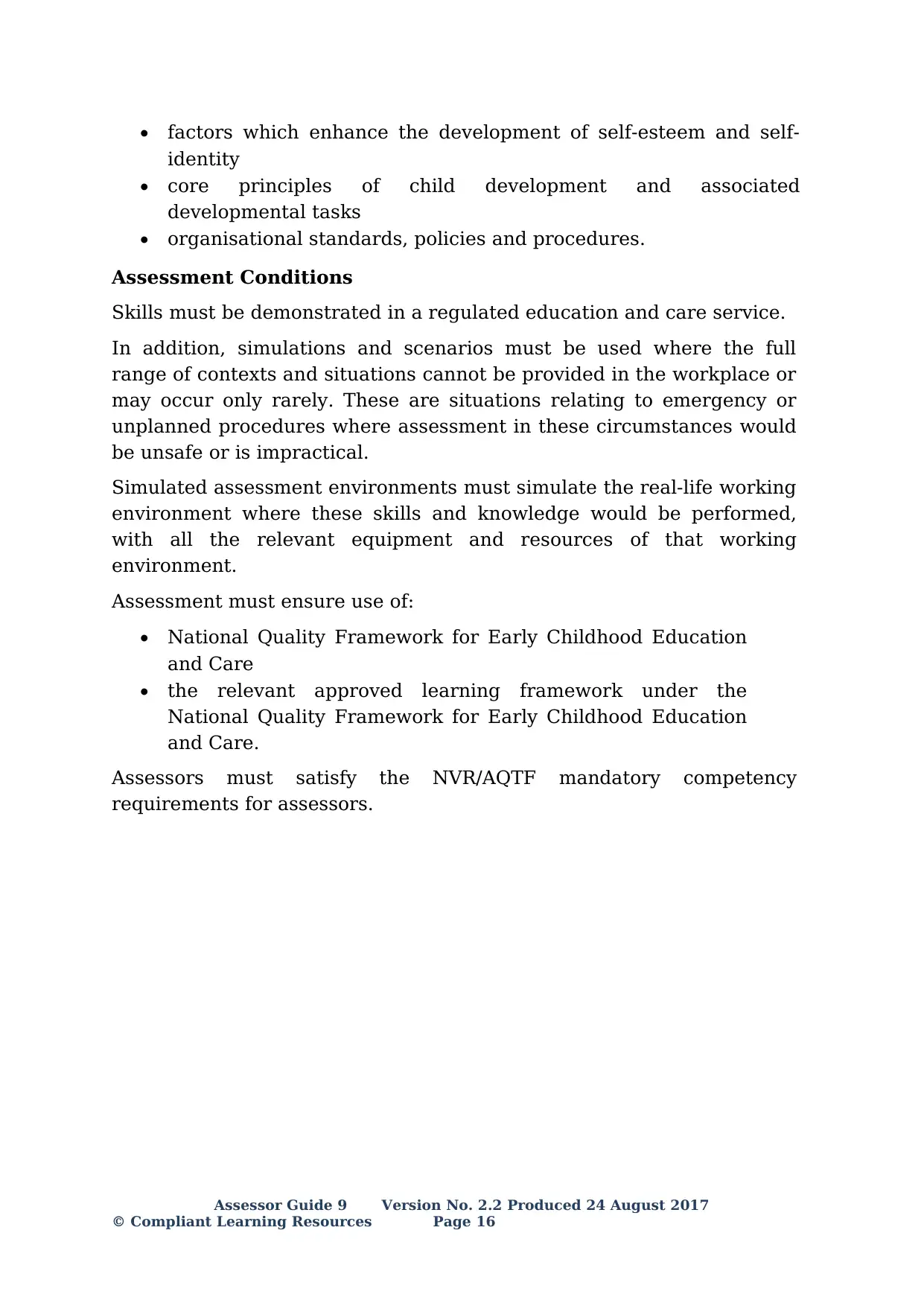
• factors which enhance the development of self-esteem and self-
identity
• core principles of child development and associated
developmental tasks
• organisational standards, policies and procedures.
Assessment Conditions
Skills must be demonstrated in a regulated education and care service.
In addition, simulations and scenarios must be used where the full
range of contexts and situations cannot be provided in the workplace or
may occur only rarely. These are situations relating to emergency or
unplanned procedures where assessment in these circumstances would
be unsafe or is impractical.
Simulated assessment environments must simulate the real-life working
environment where these skills and knowledge would be performed,
with all the relevant equipment and resources of that working
environment.
Assessment must ensure use of:
• National Quality Framework for Early Childhood Education
and Care
• the relevant approved learning framework under the
National Quality Framework for Early Childhood Education
and Care.
Assessors must satisfy the NVR/AQTF mandatory competency
requirements for assessors.
Assessor Guide 9 Version No. 2.2 Produced 24 August 2017
© Compliant Learning Resources Page 16
identity
• core principles of child development and associated
developmental tasks
• organisational standards, policies and procedures.
Assessment Conditions
Skills must be demonstrated in a regulated education and care service.
In addition, simulations and scenarios must be used where the full
range of contexts and situations cannot be provided in the workplace or
may occur only rarely. These are situations relating to emergency or
unplanned procedures where assessment in these circumstances would
be unsafe or is impractical.
Simulated assessment environments must simulate the real-life working
environment where these skills and knowledge would be performed,
with all the relevant equipment and resources of that working
environment.
Assessment must ensure use of:
• National Quality Framework for Early Childhood Education
and Care
• the relevant approved learning framework under the
National Quality Framework for Early Childhood Education
and Care.
Assessors must satisfy the NVR/AQTF mandatory competency
requirements for assessors.
Assessor Guide 9 Version No. 2.2 Produced 24 August 2017
© Compliant Learning Resources Page 16
Secure Best Marks with AI Grader
Need help grading? Try our AI Grader for instant feedback on your assignments.
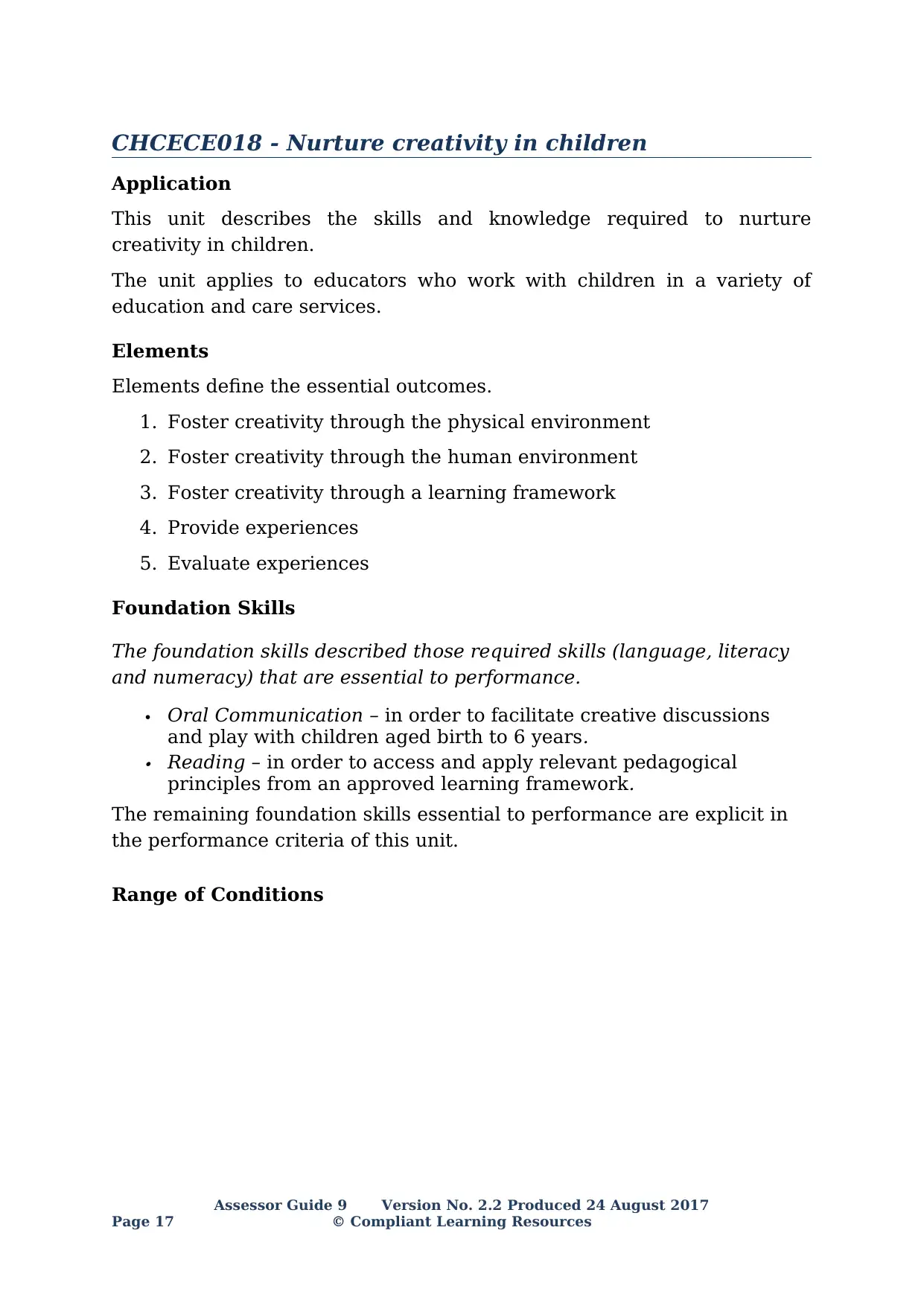
CHCECE018 - Nurture creativity in children
Application
This unit describes the skills and knowledge required to nurture
creativity in children.
The unit applies to educators who work with children in a variety of
education and care services.
Elements
Elements define the essential outcomes.
1. Foster creativity through the physical environment
2. Foster creativity through the human environment
3. Foster creativity through a learning framework
4. Provide experiences
5. Evaluate experiences
Foundation Skills
The foundation skills described those required skills (language, literacy
and numeracy) that are essential to performance.
Oral Communication – in order to facilitate creative discussions
and play with children aged birth to 6 years.
Reading – in order to access and apply relevant pedagogical
principles from an approved learning framework.
The remaining foundation skills essential to performance are explicit in
the performance criteria of this unit.
Range of Conditions
Assessor Guide 9 Version No. 2.2 Produced 24 August 2017
Page 17 © Compliant Learning Resources
Application
This unit describes the skills and knowledge required to nurture
creativity in children.
The unit applies to educators who work with children in a variety of
education and care services.
Elements
Elements define the essential outcomes.
1. Foster creativity through the physical environment
2. Foster creativity through the human environment
3. Foster creativity through a learning framework
4. Provide experiences
5. Evaluate experiences
Foundation Skills
The foundation skills described those required skills (language, literacy
and numeracy) that are essential to performance.
Oral Communication – in order to facilitate creative discussions
and play with children aged birth to 6 years.
Reading – in order to access and apply relevant pedagogical
principles from an approved learning framework.
The remaining foundation skills essential to performance are explicit in
the performance criteria of this unit.
Range of Conditions
Assessor Guide 9 Version No. 2.2 Produced 24 August 2017
Page 17 © Compliant Learning Resources

Specifies different work environments and conditions that may affect
performance. Essential operating conditions that may be present
(depending on the work situation, needs of the candidate, accessibility
of the item, and local industry and regional contexts) are included.
The range of experiences used to nurture creatively must include:
music
movement
construction
visual art
dramatic play
Assessor Guide 9 Version No. 2.2 Produced 24 August 2017
© Compliant Learning Resources Page 18
performance. Essential operating conditions that may be present
(depending on the work situation, needs of the candidate, accessibility
of the item, and local industry and regional contexts) are included.
The range of experiences used to nurture creatively must include:
music
movement
construction
visual art
dramatic play
Assessor Guide 9 Version No. 2.2 Produced 24 August 2017
© Compliant Learning Resources Page 18
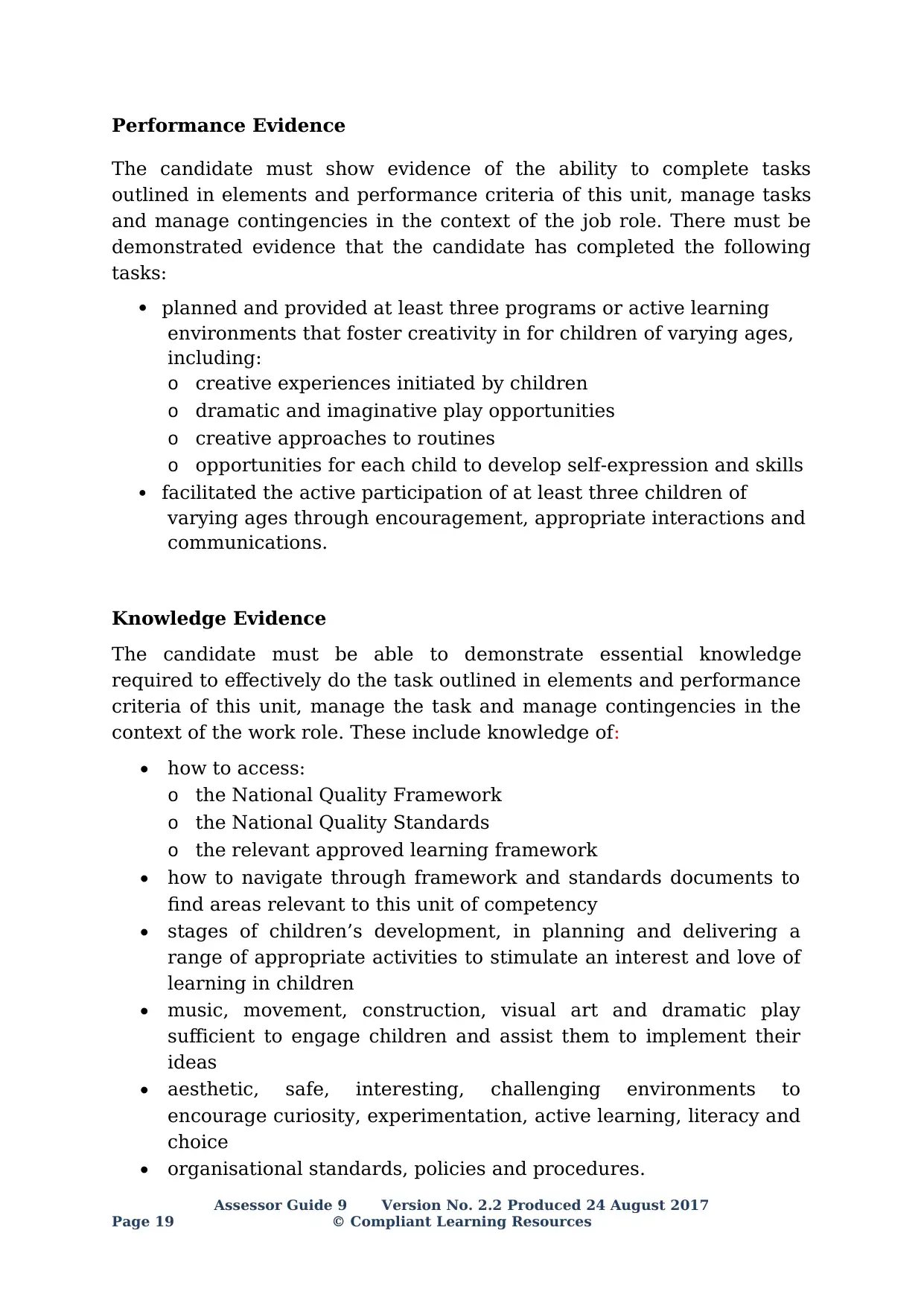
Performance Evidence
The candidate must show evidence of the ability to complete tasks
outlined in elements and performance criteria of this unit, manage tasks
and manage contingencies in the context of the job role. There must be
demonstrated evidence that the candidate has completed the following
tasks:
planned and provided at least three programs or active learning
environments that foster creativity in for children of varying ages,
including:
o creative experiences initiated by children
o dramatic and imaginative play opportunities
o creative approaches to routines
o opportunities for each child to develop self-expression and skills
facilitated the active participation of at least three children of
varying ages through encouragement, appropriate interactions and
communications.
Knowledge Evidence
The candidate must be able to demonstrate essential knowledge
required to effectively do the task outlined in elements and performance
criteria of this unit, manage the task and manage contingencies in the
context of the work role. These include knowledge of:
• how to access:
o the National Quality Framework
o the National Quality Standards
o the relevant approved learning framework
• how to navigate through framework and standards documents to
find areas relevant to this unit of competency
• stages of children’s development, in planning and delivering a
range of appropriate activities to stimulate an interest and love of
learning in children
• music, movement, construction, visual art and dramatic play
sufficient to engage children and assist them to implement their
ideas
• aesthetic, safe, interesting, challenging environments to
encourage curiosity, experimentation, active learning, literacy and
choice
• organisational standards, policies and procedures.
Assessor Guide 9 Version No. 2.2 Produced 24 August 2017
Page 19 © Compliant Learning Resources
The candidate must show evidence of the ability to complete tasks
outlined in elements and performance criteria of this unit, manage tasks
and manage contingencies in the context of the job role. There must be
demonstrated evidence that the candidate has completed the following
tasks:
planned and provided at least three programs or active learning
environments that foster creativity in for children of varying ages,
including:
o creative experiences initiated by children
o dramatic and imaginative play opportunities
o creative approaches to routines
o opportunities for each child to develop self-expression and skills
facilitated the active participation of at least three children of
varying ages through encouragement, appropriate interactions and
communications.
Knowledge Evidence
The candidate must be able to demonstrate essential knowledge
required to effectively do the task outlined in elements and performance
criteria of this unit, manage the task and manage contingencies in the
context of the work role. These include knowledge of:
• how to access:
o the National Quality Framework
o the National Quality Standards
o the relevant approved learning framework
• how to navigate through framework and standards documents to
find areas relevant to this unit of competency
• stages of children’s development, in planning and delivering a
range of appropriate activities to stimulate an interest and love of
learning in children
• music, movement, construction, visual art and dramatic play
sufficient to engage children and assist them to implement their
ideas
• aesthetic, safe, interesting, challenging environments to
encourage curiosity, experimentation, active learning, literacy and
choice
• organisational standards, policies and procedures.
Assessor Guide 9 Version No. 2.2 Produced 24 August 2017
Page 19 © Compliant Learning Resources
Paraphrase This Document
Need a fresh take? Get an instant paraphrase of this document with our AI Paraphraser

Assessor Guide 9 Version No. 2.2 Produced 24 August 2017
© Compliant Learning Resources Page 20
© Compliant Learning Resources Page 20
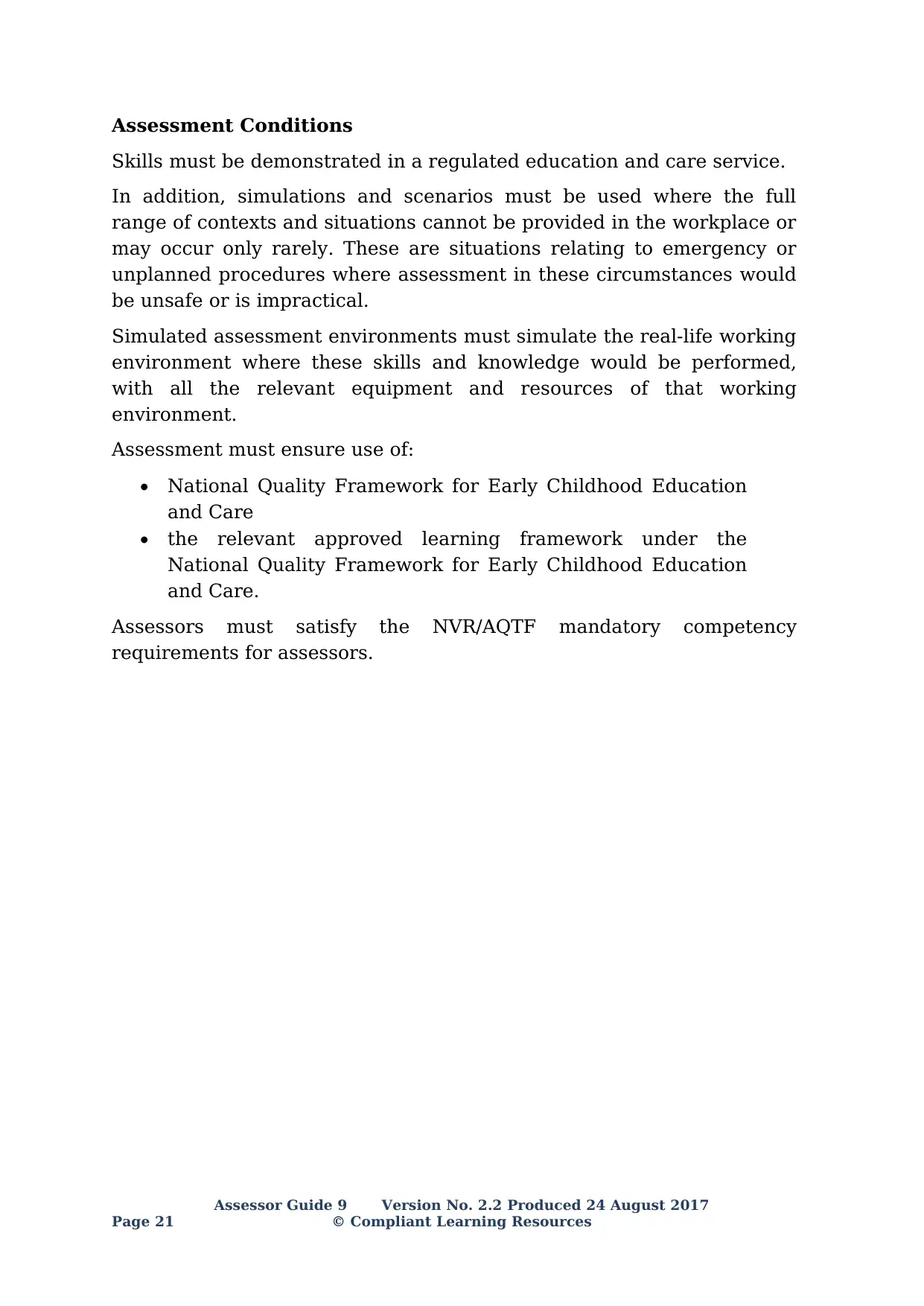
Assessment Conditions
Skills must be demonstrated in a regulated education and care service.
In addition, simulations and scenarios must be used where the full
range of contexts and situations cannot be provided in the workplace or
may occur only rarely. These are situations relating to emergency or
unplanned procedures where assessment in these circumstances would
be unsafe or is impractical.
Simulated assessment environments must simulate the real-life working
environment where these skills and knowledge would be performed,
with all the relevant equipment and resources of that working
environment.
Assessment must ensure use of:
• National Quality Framework for Early Childhood Education
and Care
• the relevant approved learning framework under the
National Quality Framework for Early Childhood Education
and Care.
Assessors must satisfy the NVR/AQTF mandatory competency
requirements for assessors.
Assessor Guide 9 Version No. 2.2 Produced 24 August 2017
Page 21 © Compliant Learning Resources
Skills must be demonstrated in a regulated education and care service.
In addition, simulations and scenarios must be used where the full
range of contexts and situations cannot be provided in the workplace or
may occur only rarely. These are situations relating to emergency or
unplanned procedures where assessment in these circumstances would
be unsafe or is impractical.
Simulated assessment environments must simulate the real-life working
environment where these skills and knowledge would be performed,
with all the relevant equipment and resources of that working
environment.
Assessment must ensure use of:
• National Quality Framework for Early Childhood Education
and Care
• the relevant approved learning framework under the
National Quality Framework for Early Childhood Education
and Care.
Assessors must satisfy the NVR/AQTF mandatory competency
requirements for assessors.
Assessor Guide 9 Version No. 2.2 Produced 24 August 2017
Page 21 © Compliant Learning Resources
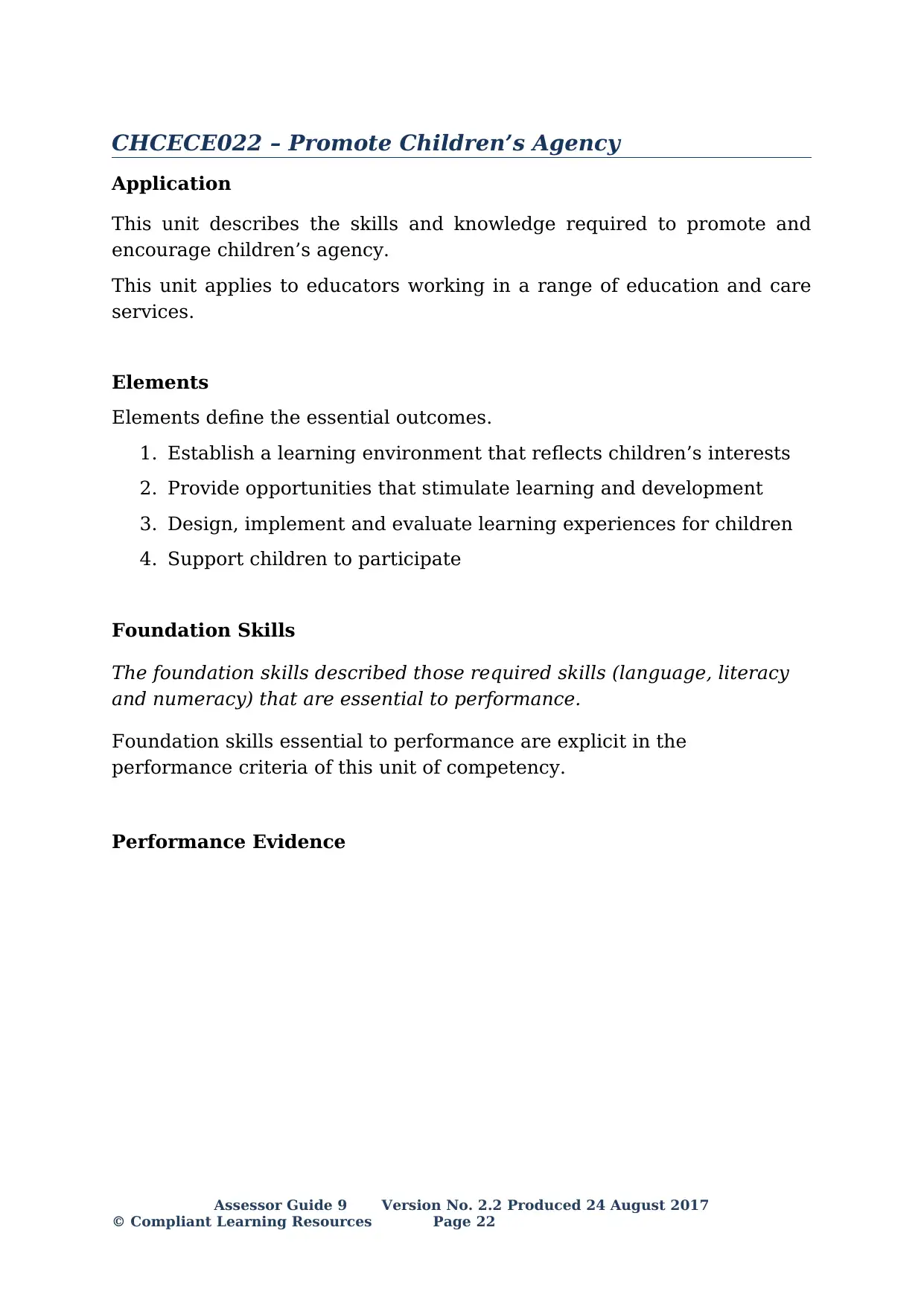
CHCECE022 – Promote Children’s Agency
Application
This unit describes the skills and knowledge required to promote and
encourage children’s agency.
This unit applies to educators working in a range of education and care
services.
Elements
Elements define the essential outcomes.
1. Establish a learning environment that reflects children’s interests
2. Provide opportunities that stimulate learning and development
3. Design, implement and evaluate learning experiences for children
4. Support children to participate
Foundation Skills
The foundation skills described those required skills (language, literacy
and numeracy) that are essential to performance.
Foundation skills essential to performance are explicit in the
performance criteria of this unit of competency.
Performance Evidence
Assessor Guide 9 Version No. 2.2 Produced 24 August 2017
© Compliant Learning Resources Page 22
Application
This unit describes the skills and knowledge required to promote and
encourage children’s agency.
This unit applies to educators working in a range of education and care
services.
Elements
Elements define the essential outcomes.
1. Establish a learning environment that reflects children’s interests
2. Provide opportunities that stimulate learning and development
3. Design, implement and evaluate learning experiences for children
4. Support children to participate
Foundation Skills
The foundation skills described those required skills (language, literacy
and numeracy) that are essential to performance.
Foundation skills essential to performance are explicit in the
performance criteria of this unit of competency.
Performance Evidence
Assessor Guide 9 Version No. 2.2 Produced 24 August 2017
© Compliant Learning Resources Page 22
Secure Best Marks with AI Grader
Need help grading? Try our AI Grader for instant feedback on your assignments.
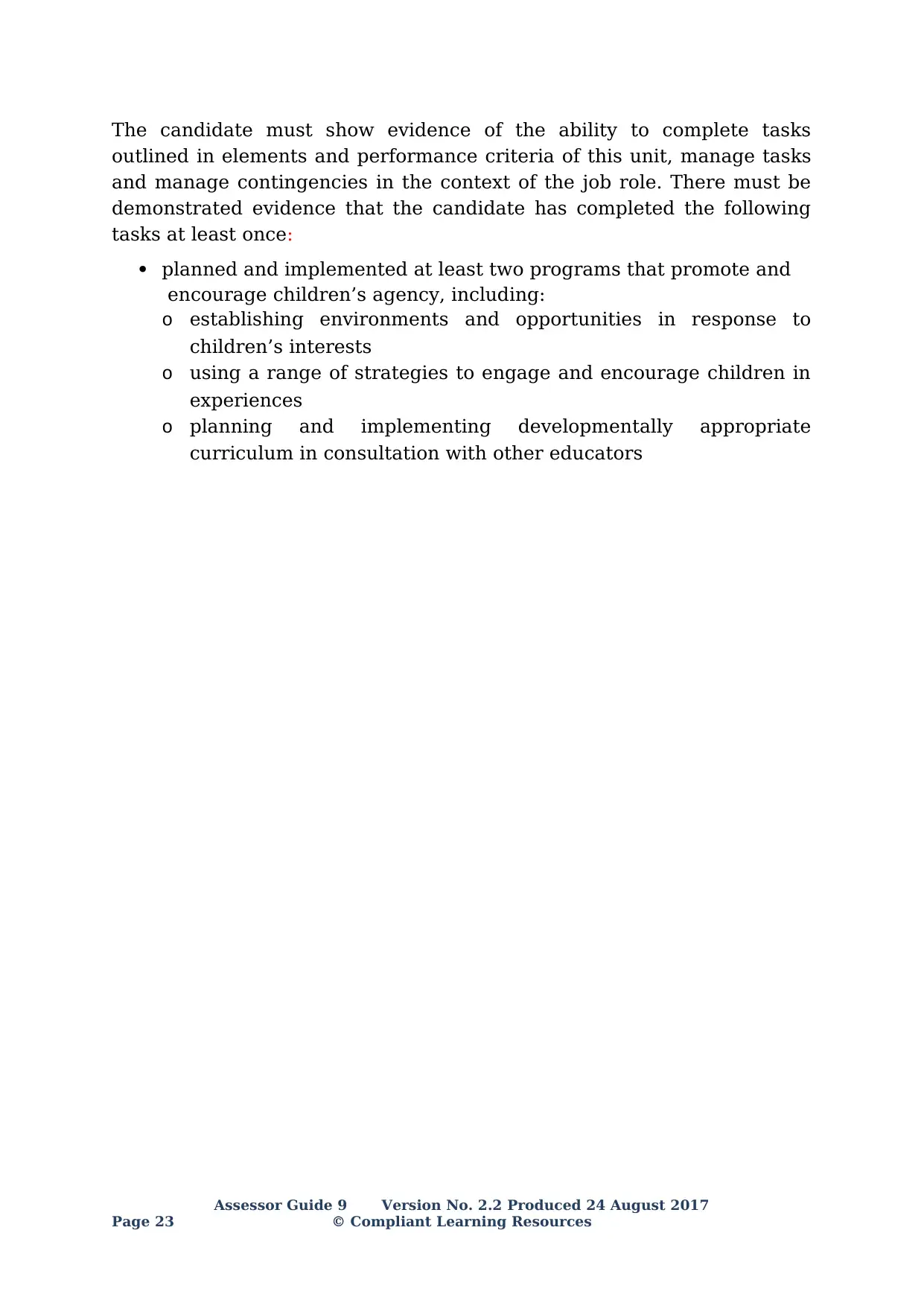
The candidate must show evidence of the ability to complete tasks
outlined in elements and performance criteria of this unit, manage tasks
and manage contingencies in the context of the job role. There must be
demonstrated evidence that the candidate has completed the following
tasks at least once:
planned and implemented at least two programs that promote and
encourage children’s agency, including:
o establishing environments and opportunities in response to
children’s interests
o using a range of strategies to engage and encourage children in
experiences
o planning and implementing developmentally appropriate
curriculum in consultation with other educators
Assessor Guide 9 Version No. 2.2 Produced 24 August 2017
Page 23 © Compliant Learning Resources
outlined in elements and performance criteria of this unit, manage tasks
and manage contingencies in the context of the job role. There must be
demonstrated evidence that the candidate has completed the following
tasks at least once:
planned and implemented at least two programs that promote and
encourage children’s agency, including:
o establishing environments and opportunities in response to
children’s interests
o using a range of strategies to engage and encourage children in
experiences
o planning and implementing developmentally appropriate
curriculum in consultation with other educators
Assessor Guide 9 Version No. 2.2 Produced 24 August 2017
Page 23 © Compliant Learning Resources

Knowledge Evidence
The candidate must be able to demonstrate essential knowledge
required to effectively do the task outlined in elements and performance
criteria of this unit, manage the task and manage contingencies in the
context of the work role. These include knowledge of:
• how to access:
o the National Quality Framework
o the National Quality Standards
o the relevant approved learning framework
• how to navigate through framework and standards documents to
find areas relevant to this unit of competency
• relevant theories about childhood learning
• organisation standards, policies and procedures
• strategies for intentional teaching
• techniques to encourage and support children to participate.
Assessment Conditions
Skills must be demonstrated in a regulated education and care service.
In addition, simulations and scenarios must be used where the full
range of contexts and situations cannot be provided in the workplace or
may occur only rarely. These are situations relating to emergency or
unplanned procedures where assessment in these circumstances would
be unsafe or is impractical.
Simulated assessment environments must simulate the real-life working
environment where these skills and knowledge would be performed,
with all the relevant equipment and resources of that working
environment.
Assessment must ensure use of:
• National Quality Framework for Early Childhood Education
and Care
• the relevant approved learning framework under the
National Quality Framework for Early Childhood Education
and Care.
Assessors must satisfy the NVR/AQTF mandatory competency
requirements for assessors.
Assessor Guide 9 Version No. 2.2 Produced 24 August 2017
© Compliant Learning Resources Page 24
The candidate must be able to demonstrate essential knowledge
required to effectively do the task outlined in elements and performance
criteria of this unit, manage the task and manage contingencies in the
context of the work role. These include knowledge of:
• how to access:
o the National Quality Framework
o the National Quality Standards
o the relevant approved learning framework
• how to navigate through framework and standards documents to
find areas relevant to this unit of competency
• relevant theories about childhood learning
• organisation standards, policies and procedures
• strategies for intentional teaching
• techniques to encourage and support children to participate.
Assessment Conditions
Skills must be demonstrated in a regulated education and care service.
In addition, simulations and scenarios must be used where the full
range of contexts and situations cannot be provided in the workplace or
may occur only rarely. These are situations relating to emergency or
unplanned procedures where assessment in these circumstances would
be unsafe or is impractical.
Simulated assessment environments must simulate the real-life working
environment where these skills and knowledge would be performed,
with all the relevant equipment and resources of that working
environment.
Assessment must ensure use of:
• National Quality Framework for Early Childhood Education
and Care
• the relevant approved learning framework under the
National Quality Framework for Early Childhood Education
and Care.
Assessors must satisfy the NVR/AQTF mandatory competency
requirements for assessors.
Assessor Guide 9 Version No. 2.2 Produced 24 August 2017
© Compliant Learning Resources Page 24

Assessor Guide 9 Version No. 2.2 Produced 24 August 2017
Page 25 © Compliant Learning Resources
Page 25 © Compliant Learning Resources
Paraphrase This Document
Need a fresh take? Get an instant paraphrase of this document with our AI Paraphraser
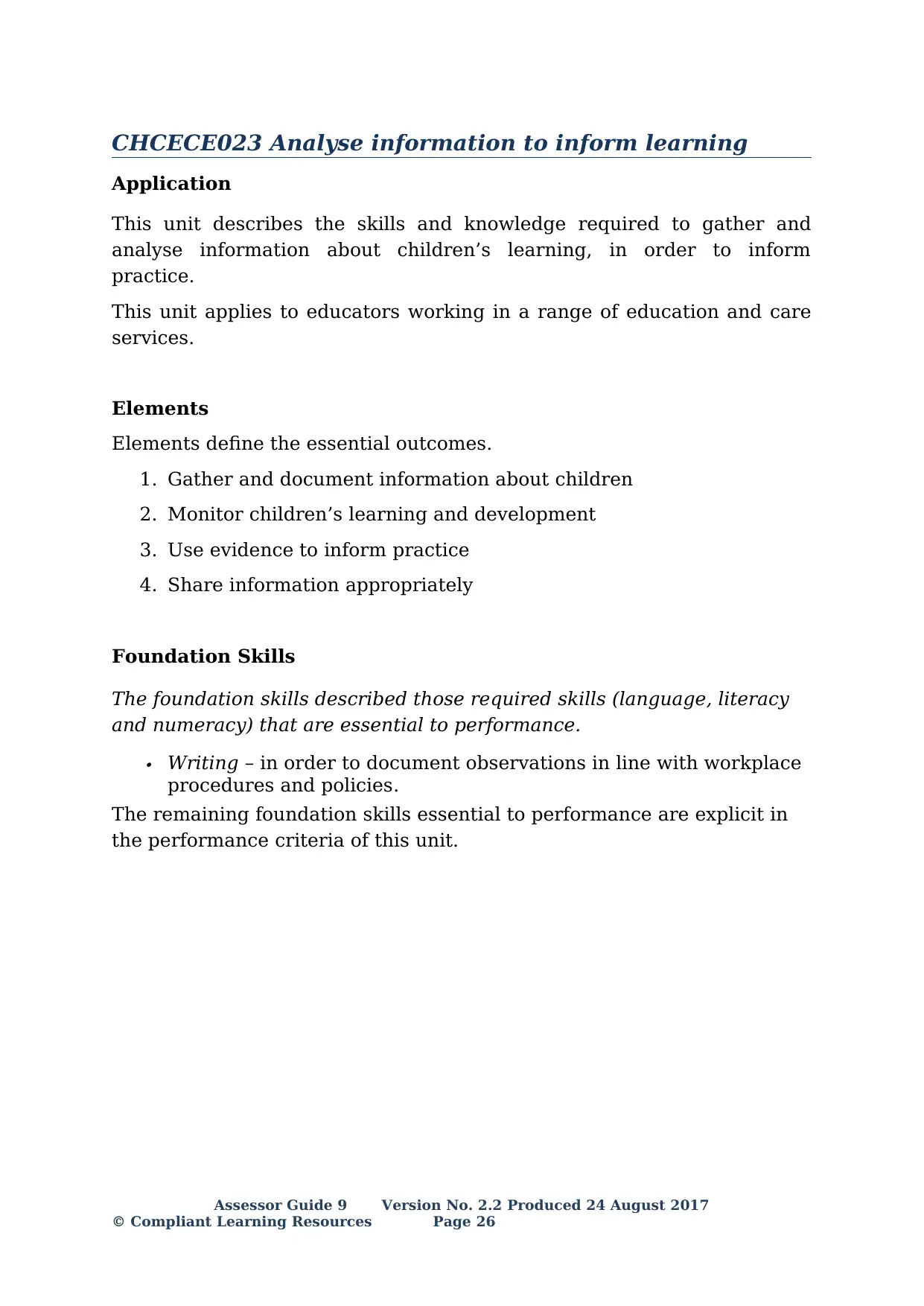
CHCECE023 Analyse information to inform learning
Application
This unit describes the skills and knowledge required to gather and
analyse information about children’s learning, in order to inform
practice.
This unit applies to educators working in a range of education and care
services.
Elements
Elements define the essential outcomes.
1. Gather and document information about children
2. Monitor children’s learning and development
3. Use evidence to inform practice
4. Share information appropriately
Foundation Skills
The foundation skills described those required skills (language, literacy
and numeracy) that are essential to performance. Writing – in order to document observations in line with workplace
procedures and policies.
The remaining foundation skills essential to performance are explicit in
the performance criteria of this unit.
Assessor Guide 9 Version No. 2.2 Produced 24 August 2017
© Compliant Learning Resources Page 26
Application
This unit describes the skills and knowledge required to gather and
analyse information about children’s learning, in order to inform
practice.
This unit applies to educators working in a range of education and care
services.
Elements
Elements define the essential outcomes.
1. Gather and document information about children
2. Monitor children’s learning and development
3. Use evidence to inform practice
4. Share information appropriately
Foundation Skills
The foundation skills described those required skills (language, literacy
and numeracy) that are essential to performance. Writing – in order to document observations in line with workplace
procedures and policies.
The remaining foundation skills essential to performance are explicit in
the performance criteria of this unit.
Assessor Guide 9 Version No. 2.2 Produced 24 August 2017
© Compliant Learning Resources Page 26
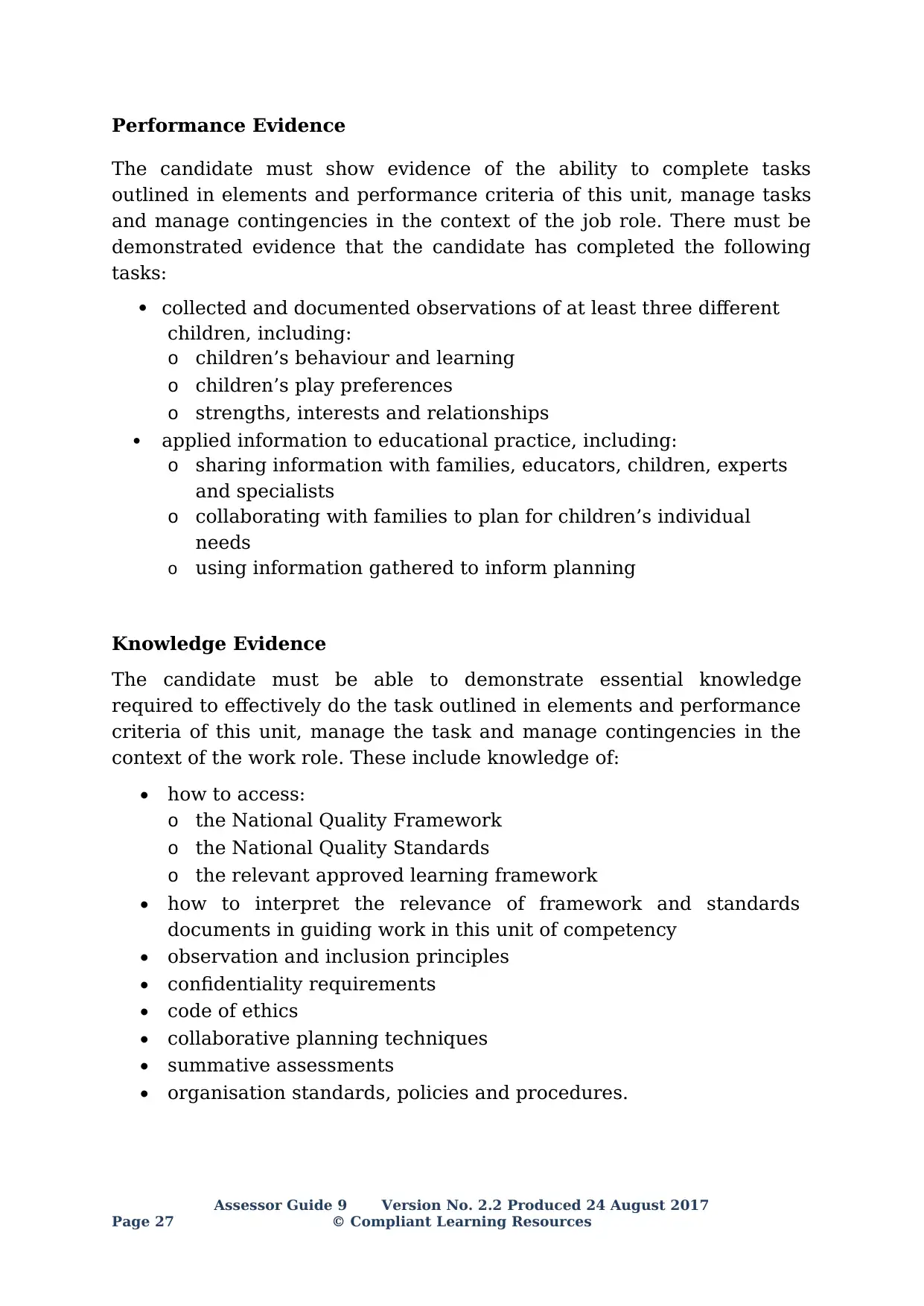
Performance Evidence
The candidate must show evidence of the ability to complete tasks
outlined in elements and performance criteria of this unit, manage tasks
and manage contingencies in the context of the job role. There must be
demonstrated evidence that the candidate has completed the following
tasks:
collected and documented observations of at least three different
children, including:
o children’s behaviour and learning
o children’s play preferences
o strengths, interests and relationships
applied information to educational practice, including:
o sharing information with families, educators, children, experts
and specialists
o collaborating with families to plan for children’s individual
needs
o using information gathered to inform planning
Knowledge Evidence
The candidate must be able to demonstrate essential knowledge
required to effectively do the task outlined in elements and performance
criteria of this unit, manage the task and manage contingencies in the
context of the work role. These include knowledge of:
• how to access:
o the National Quality Framework
o the National Quality Standards
o the relevant approved learning framework
• how to interpret the relevance of framework and standards
documents in guiding work in this unit of competency
• observation and inclusion principles
• confidentiality requirements
• code of ethics
• collaborative planning techniques
• summative assessments
• organisation standards, policies and procedures.
Assessor Guide 9 Version No. 2.2 Produced 24 August 2017
Page 27 © Compliant Learning Resources
The candidate must show evidence of the ability to complete tasks
outlined in elements and performance criteria of this unit, manage tasks
and manage contingencies in the context of the job role. There must be
demonstrated evidence that the candidate has completed the following
tasks:
collected and documented observations of at least three different
children, including:
o children’s behaviour and learning
o children’s play preferences
o strengths, interests and relationships
applied information to educational practice, including:
o sharing information with families, educators, children, experts
and specialists
o collaborating with families to plan for children’s individual
needs
o using information gathered to inform planning
Knowledge Evidence
The candidate must be able to demonstrate essential knowledge
required to effectively do the task outlined in elements and performance
criteria of this unit, manage the task and manage contingencies in the
context of the work role. These include knowledge of:
• how to access:
o the National Quality Framework
o the National Quality Standards
o the relevant approved learning framework
• how to interpret the relevance of framework and standards
documents in guiding work in this unit of competency
• observation and inclusion principles
• confidentiality requirements
• code of ethics
• collaborative planning techniques
• summative assessments
• organisation standards, policies and procedures.
Assessor Guide 9 Version No. 2.2 Produced 24 August 2017
Page 27 © Compliant Learning Resources
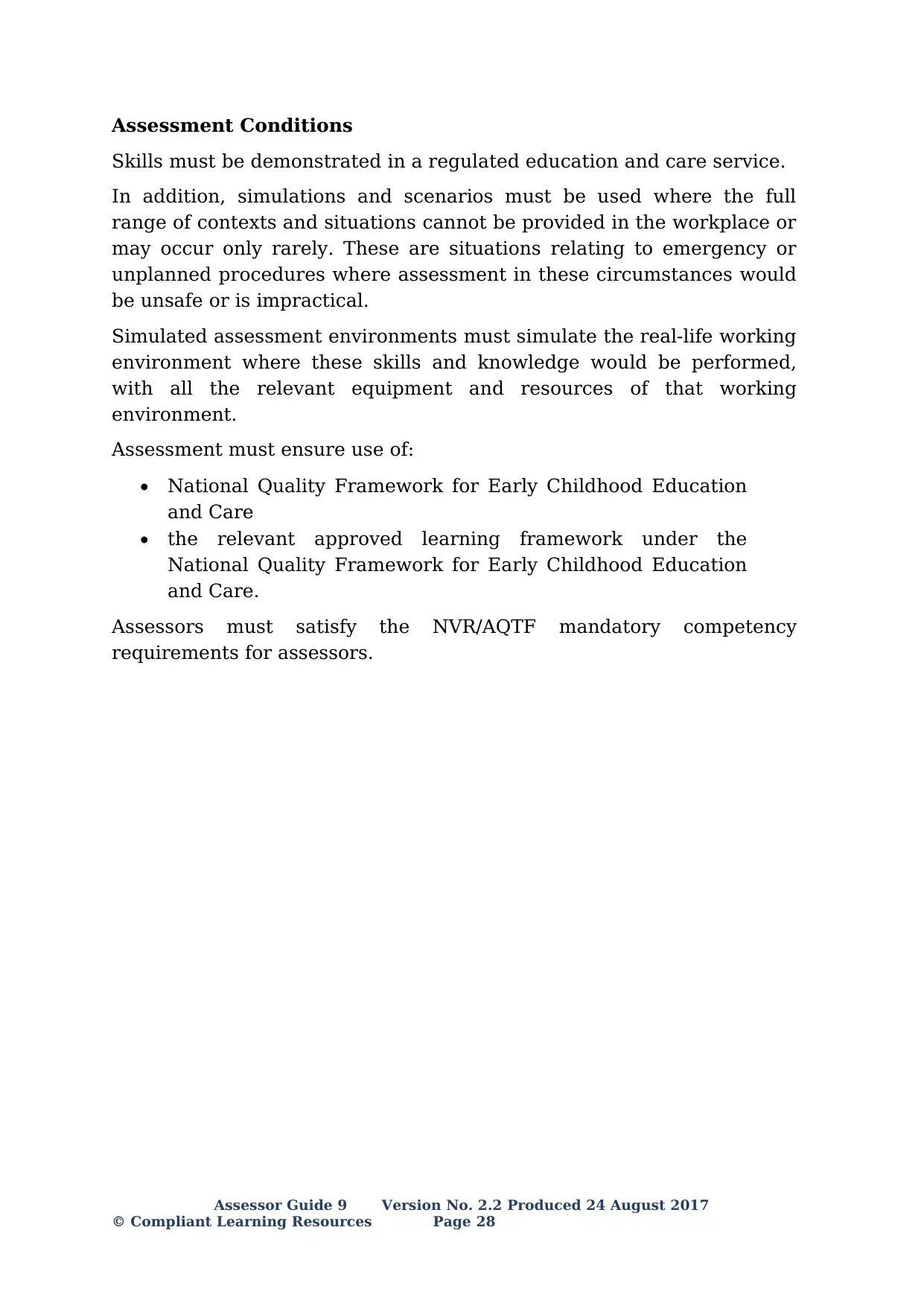
Assessment Conditions
Skills must be demonstrated in a regulated education and care service.
In addition, simulations and scenarios must be used where the full
range of contexts and situations cannot be provided in the workplace or
may occur only rarely. These are situations relating to emergency or
unplanned procedures where assessment in these circumstances would
be unsafe or is impractical.
Simulated assessment environments must simulate the real-life working
environment where these skills and knowledge would be performed,
with all the relevant equipment and resources of that working
environment.
Assessment must ensure use of:
• National Quality Framework for Early Childhood Education
and Care
• the relevant approved learning framework under the
National Quality Framework for Early Childhood Education
and Care.
Assessors must satisfy the NVR/AQTF mandatory competency
requirements for assessors.
Assessor Guide 9 Version No. 2.2 Produced 24 August 2017
© Compliant Learning Resources Page 28
Skills must be demonstrated in a regulated education and care service.
In addition, simulations and scenarios must be used where the full
range of contexts and situations cannot be provided in the workplace or
may occur only rarely. These are situations relating to emergency or
unplanned procedures where assessment in these circumstances would
be unsafe or is impractical.
Simulated assessment environments must simulate the real-life working
environment where these skills and knowledge would be performed,
with all the relevant equipment and resources of that working
environment.
Assessment must ensure use of:
• National Quality Framework for Early Childhood Education
and Care
• the relevant approved learning framework under the
National Quality Framework for Early Childhood Education
and Care.
Assessors must satisfy the NVR/AQTF mandatory competency
requirements for assessors.
Assessor Guide 9 Version No. 2.2 Produced 24 August 2017
© Compliant Learning Resources Page 28
Secure Best Marks with AI Grader
Need help grading? Try our AI Grader for instant feedback on your assignments.
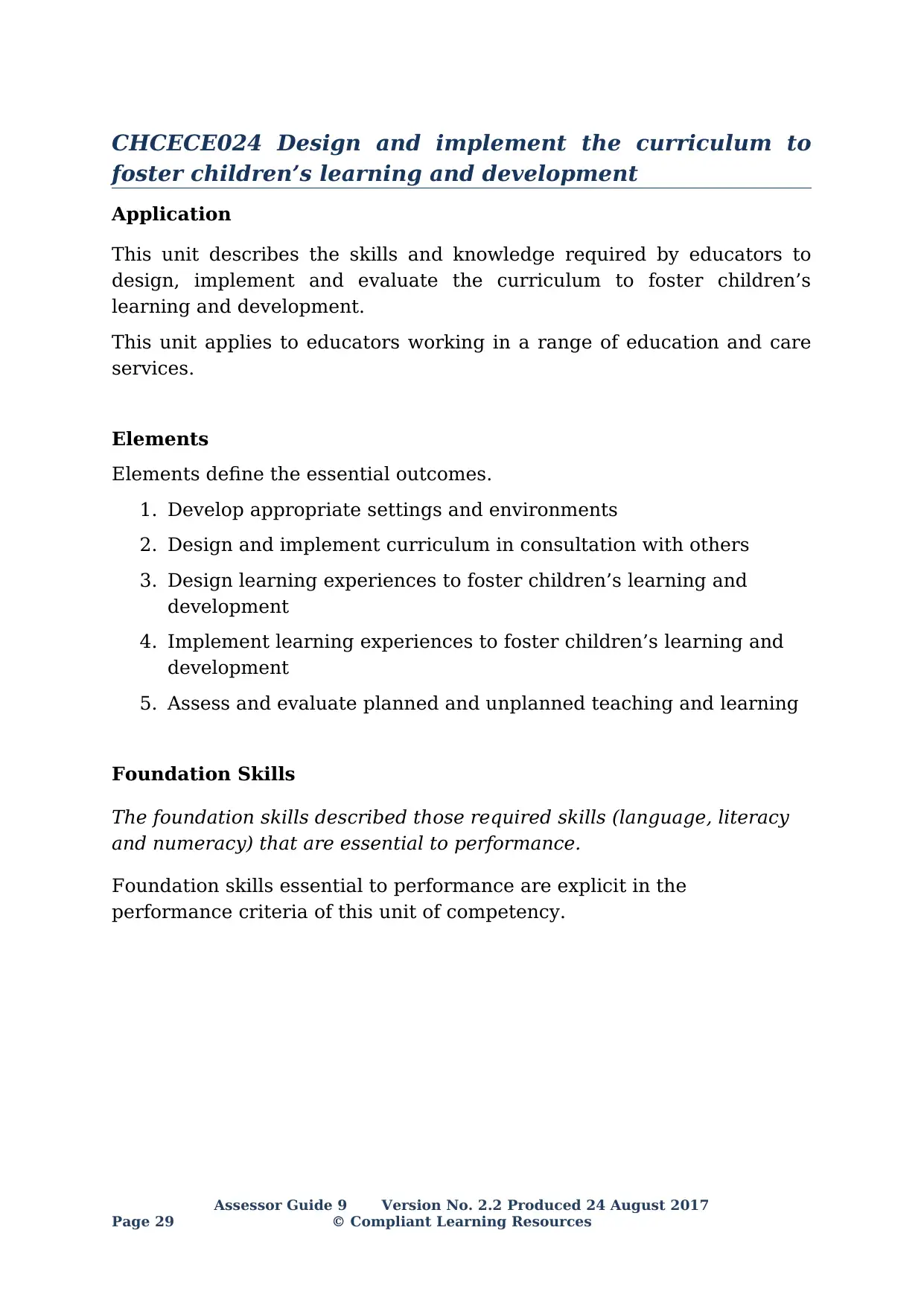
CHCECE024 Design and implement the curriculum to
foster children’s learning and development
Application
This unit describes the skills and knowledge required by educators to
design, implement and evaluate the curriculum to foster children’s
learning and development.
This unit applies to educators working in a range of education and care
services.
Elements
Elements define the essential outcomes.
1. Develop appropriate settings and environments
2. Design and implement curriculum in consultation with others
3. Design learning experiences to foster children’s learning and
development
4. Implement learning experiences to foster children’s learning and
development
5. Assess and evaluate planned and unplanned teaching and learning
Foundation Skills
The foundation skills described those required skills (language, literacy
and numeracy) that are essential to performance.
Foundation skills essential to performance are explicit in the
performance criteria of this unit of competency.
Assessor Guide 9 Version No. 2.2 Produced 24 August 2017
Page 29 © Compliant Learning Resources
foster children’s learning and development
Application
This unit describes the skills and knowledge required by educators to
design, implement and evaluate the curriculum to foster children’s
learning and development.
This unit applies to educators working in a range of education and care
services.
Elements
Elements define the essential outcomes.
1. Develop appropriate settings and environments
2. Design and implement curriculum in consultation with others
3. Design learning experiences to foster children’s learning and
development
4. Implement learning experiences to foster children’s learning and
development
5. Assess and evaluate planned and unplanned teaching and learning
Foundation Skills
The foundation skills described those required skills (language, literacy
and numeracy) that are essential to performance.
Foundation skills essential to performance are explicit in the
performance criteria of this unit of competency.
Assessor Guide 9 Version No. 2.2 Produced 24 August 2017
Page 29 © Compliant Learning Resources

Performance Evidence
The candidate must show evidence of the ability to complete tasks
outlined in elements and performance criteria of this unit, manage tasks
and manage contingencies in the context of the job role. There must be
demonstrated evidence that the candidate has completed the following
tasks:
designed and implemented curriculum on at least one occasion,
including:
o evaluating and modifying environments to enhance
opportunities for children’s learning from other educators,
children and their families
o gathering information to use as a basis for design to address
identified needs
o designing learning experiences to foster children’s development
o assessing and evaluating curriculum and learning experiences in
accordance with guidelines
performed the activities outlined in the performance criteria of this
unit during a period of at least 240 hours of work in at least one
regulated education and care service.
Knowledge Evidence
The candidate must be able to demonstrate essential knowledge
required to effectively do the task outlined in elements and performance
criteria of this unit, manage the task and manage contingencies in the
context of the work role. These include knowledge of:
• how to access:
o the National Quality Framework
o the National Quality Standards
o the relevant approved learning framework
• how to navigate through framework and standards documents to
find areas relevant to this unit of competency
• how to design programs and environments that foster children’s
development
• evaluation strategies
• organisation standards, policies and procedures.
Assessor Guide 9 Version No. 2.2 Produced 24 August 2017
© Compliant Learning Resources Page 30
The candidate must show evidence of the ability to complete tasks
outlined in elements and performance criteria of this unit, manage tasks
and manage contingencies in the context of the job role. There must be
demonstrated evidence that the candidate has completed the following
tasks:
designed and implemented curriculum on at least one occasion,
including:
o evaluating and modifying environments to enhance
opportunities for children’s learning from other educators,
children and their families
o gathering information to use as a basis for design to address
identified needs
o designing learning experiences to foster children’s development
o assessing and evaluating curriculum and learning experiences in
accordance with guidelines
performed the activities outlined in the performance criteria of this
unit during a period of at least 240 hours of work in at least one
regulated education and care service.
Knowledge Evidence
The candidate must be able to demonstrate essential knowledge
required to effectively do the task outlined in elements and performance
criteria of this unit, manage the task and manage contingencies in the
context of the work role. These include knowledge of:
• how to access:
o the National Quality Framework
o the National Quality Standards
o the relevant approved learning framework
• how to navigate through framework and standards documents to
find areas relevant to this unit of competency
• how to design programs and environments that foster children’s
development
• evaluation strategies
• organisation standards, policies and procedures.
Assessor Guide 9 Version No. 2.2 Produced 24 August 2017
© Compliant Learning Resources Page 30

Assessor Guide 9 Version No. 2.2 Produced 24 August 2017
Page 31 © Compliant Learning Resources
Page 31 © Compliant Learning Resources
Paraphrase This Document
Need a fresh take? Get an instant paraphrase of this document with our AI Paraphraser
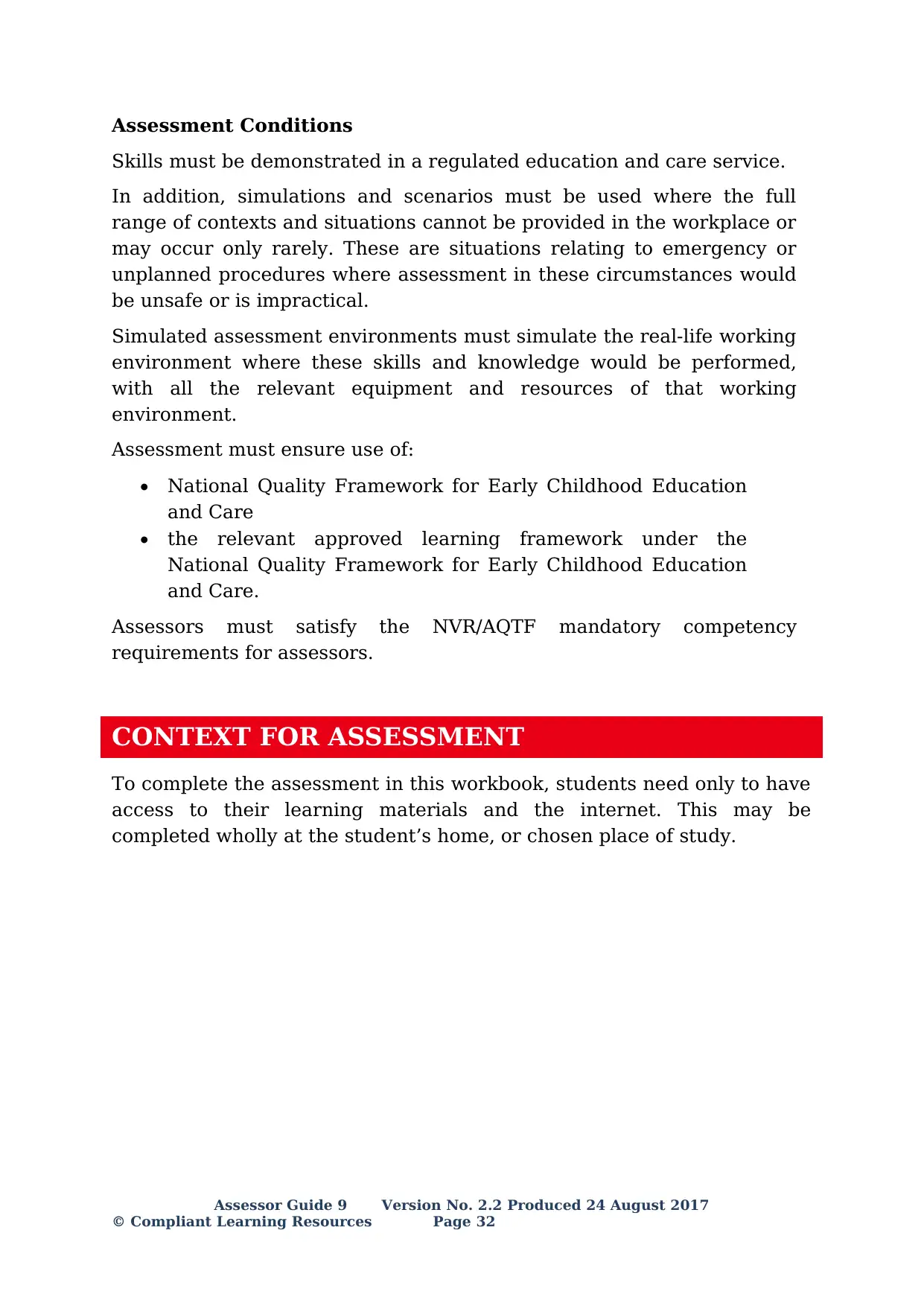
Assessment Conditions
Skills must be demonstrated in a regulated education and care service.
In addition, simulations and scenarios must be used where the full
range of contexts and situations cannot be provided in the workplace or
may occur only rarely. These are situations relating to emergency or
unplanned procedures where assessment in these circumstances would
be unsafe or is impractical.
Simulated assessment environments must simulate the real-life working
environment where these skills and knowledge would be performed,
with all the relevant equipment and resources of that working
environment.
Assessment must ensure use of:
• National Quality Framework for Early Childhood Education
and Care
• the relevant approved learning framework under the
National Quality Framework for Early Childhood Education
and Care.
Assessors must satisfy the NVR/AQTF mandatory competency
requirements for assessors.
CONTEXT FOR ASSESSMENT
To complete the assessment in this workbook, students need only to have
access to their learning materials and the internet. This may be
completed wholly at the student’s home, or chosen place of study.
Assessor Guide 9 Version No. 2.2 Produced 24 August 2017
© Compliant Learning Resources Page 32
Skills must be demonstrated in a regulated education and care service.
In addition, simulations and scenarios must be used where the full
range of contexts and situations cannot be provided in the workplace or
may occur only rarely. These are situations relating to emergency or
unplanned procedures where assessment in these circumstances would
be unsafe or is impractical.
Simulated assessment environments must simulate the real-life working
environment where these skills and knowledge would be performed,
with all the relevant equipment and resources of that working
environment.
Assessment must ensure use of:
• National Quality Framework for Early Childhood Education
and Care
• the relevant approved learning framework under the
National Quality Framework for Early Childhood Education
and Care.
Assessors must satisfy the NVR/AQTF mandatory competency
requirements for assessors.
CONTEXT FOR ASSESSMENT
To complete the assessment in this workbook, students need only to have
access to their learning materials and the internet. This may be
completed wholly at the student’s home, or chosen place of study.
Assessor Guide 9 Version No. 2.2 Produced 24 August 2017
© Compliant Learning Resources Page 32

ASSESSMENT METHODS
Assessment for these units will be assessed through completion of
Workbook Nine (9) and Workbook Eleven (11).
Workbook Nine will focus on two assessment methods:
1. Written Questions – based on the required knowledge component
as described in the Instructions for Assessment
2. Projects – provide tasks designed to be completed in a practical
setting, to assist completion of relevant tasks addressing
underpinning skills and/or knowledge requirements.
Further Assessments:
3. Workbook Eleven (11) Skills Journal
participant must attend Vocational Placement and maintain a log of
tasks completed and signed off by supervisor in the workplace.
RESOURCES REQUIRED FOR ASSESSMENT
To complete the assessments in this workbook, the candidates will need
access to:
Computer with internet access, MS Word, Adobe Acrobat Reader
Assessor Guide 9 Version No. 2.2 Produced 24 August 2017
Page 33 © Compliant Learning Resources
Assessment for these units will be assessed through completion of
Workbook Nine (9) and Workbook Eleven (11).
Workbook Nine will focus on two assessment methods:
1. Written Questions – based on the required knowledge component
as described in the Instructions for Assessment
2. Projects – provide tasks designed to be completed in a practical
setting, to assist completion of relevant tasks addressing
underpinning skills and/or knowledge requirements.
Further Assessments:
3. Workbook Eleven (11) Skills Journal
participant must attend Vocational Placement and maintain a log of
tasks completed and signed off by supervisor in the workplace.
RESOURCES REQUIRED FOR ASSESSMENT
To complete the assessments in this workbook, the candidates will need
access to:
Computer with internet access, MS Word, Adobe Acrobat Reader
Assessor Guide 9 Version No. 2.2 Produced 24 August 2017
Page 33 © Compliant Learning Resources
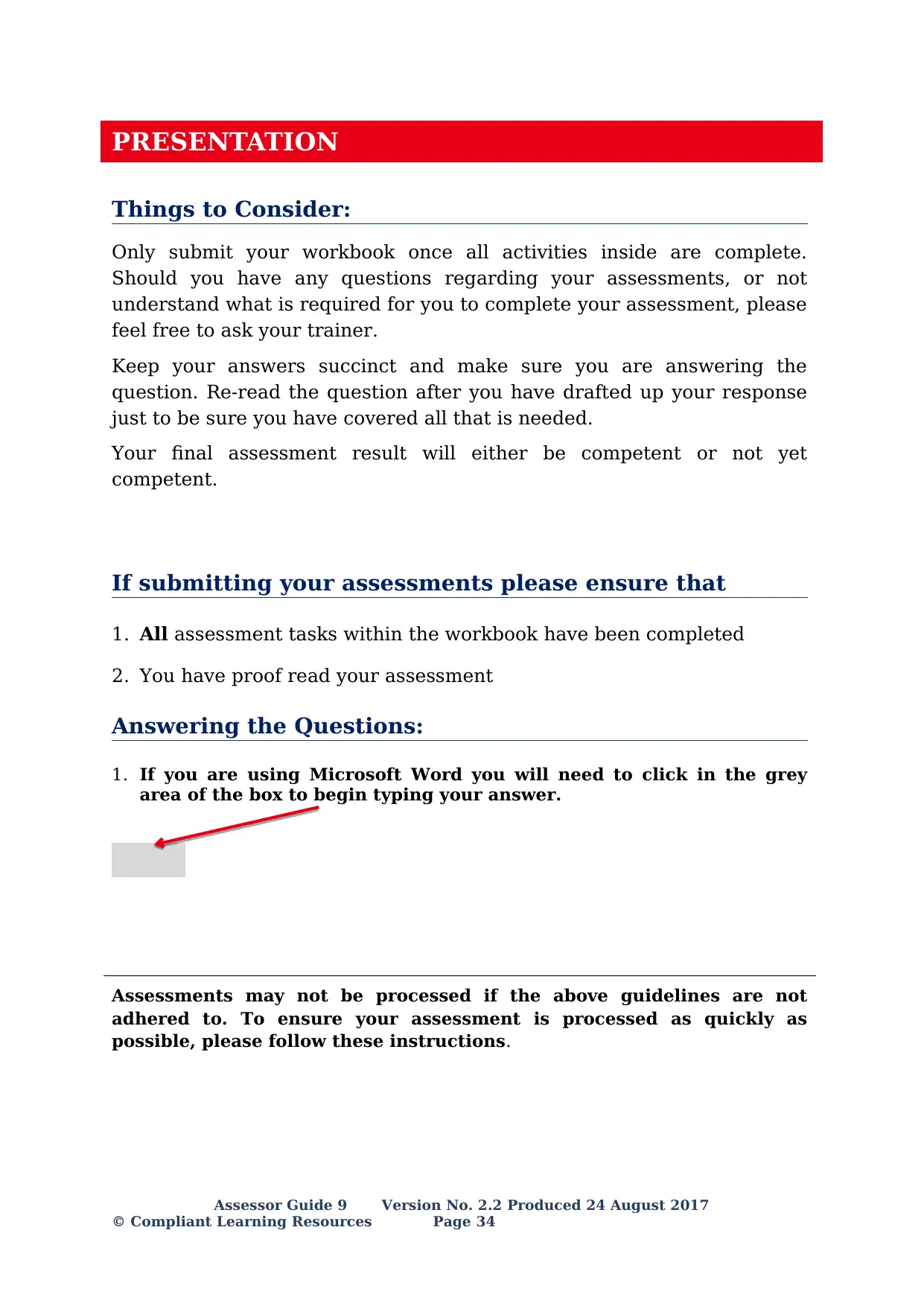
PRESENTATION
Things to Consider:
Only submit your workbook once all activities inside are complete.
Should you have any questions regarding your assessments, or not
understand what is required for you to complete your assessment, please
feel free to ask your trainer.
Keep your answers succinct and make sure you are answering the
question. Re-read the question after you have drafted up your response
just to be sure you have covered all that is needed.
Your final assessment result will either be competent or not yet
competent.
If submitting your assessments please ensure that
1. All assessment tasks within the workbook have been completed
2. You have proof read your assessment
Answering the Questions:
1. If you are using Microsoft Word you will need to click in the grey
area of the box to begin typing your answer.
Assessments may not be processed if the above guidelines are not
adhered to. To ensure your assessment is processed as quickly as
possible, please follow these instructions.
Assessor Guide 9 Version No. 2.2 Produced 24 August 2017
© Compliant Learning Resources Page 34
Things to Consider:
Only submit your workbook once all activities inside are complete.
Should you have any questions regarding your assessments, or not
understand what is required for you to complete your assessment, please
feel free to ask your trainer.
Keep your answers succinct and make sure you are answering the
question. Re-read the question after you have drafted up your response
just to be sure you have covered all that is needed.
Your final assessment result will either be competent or not yet
competent.
If submitting your assessments please ensure that
1. All assessment tasks within the workbook have been completed
2. You have proof read your assessment
Answering the Questions:
1. If you are using Microsoft Word you will need to click in the grey
area of the box to begin typing your answer.
Assessments may not be processed if the above guidelines are not
adhered to. To ensure your assessment is processed as quickly as
possible, please follow these instructions.
Assessor Guide 9 Version No. 2.2 Produced 24 August 2017
© Compliant Learning Resources Page 34
Secure Best Marks with AI Grader
Need help grading? Try our AI Grader for instant feedback on your assignments.

ASSESSMENT WORKBOOK COVERSHEET
WORKBOOK: WORKBOOK 9
TITLE: Program Design and Implementation
FIRST AND SURNAME:
PHONE:
EMAIL:
Please read the Candidate Declaration below and if you
agree to the terms of the declaration sign and date in
the space provided.
By submitting this work, I declare that:
I have been advised of the assessment requirements, have been
made aware of my rights and responsibilities as an assessment
candidate, and choose to be assessed at this time.
I am aware that there is a limit to the number of submissions
that I can make for each assessment and I am submitting all
documents required to complete this Assessment Workbook.
I have organised and named the files I am submitting according
to the instructions provided and I am aware that my assessor
will not assess work that cannot be clearly identified and may
request the work be resubmitted according to the correct
process.
This work is my own and contains no material written by
another person except where due reference is made. I am aware
that a false declaration may lead to the withdrawal of a
qualification or statement of attainment.
I am aware that there is a policy of checking the validity of
qualifications that I submit as evidence as well as the
qualifications/evidence of parties who verify my performance or
observable skills. I give my consent to contact these parties for
verification purposes.
Name : Signature: Date:
Assessor Guide 9 Version No. 2.2 Produced 24 August 2017
Page 35 © Compliant Learning Resources
WORKBOOK: WORKBOOK 9
TITLE: Program Design and Implementation
FIRST AND SURNAME:
PHONE:
EMAIL:
Please read the Candidate Declaration below and if you
agree to the terms of the declaration sign and date in
the space provided.
By submitting this work, I declare that:
I have been advised of the assessment requirements, have been
made aware of my rights and responsibilities as an assessment
candidate, and choose to be assessed at this time.
I am aware that there is a limit to the number of submissions
that I can make for each assessment and I am submitting all
documents required to complete this Assessment Workbook.
I have organised and named the files I am submitting according
to the instructions provided and I am aware that my assessor
will not assess work that cannot be clearly identified and may
request the work be resubmitted according to the correct
process.
This work is my own and contains no material written by
another person except where due reference is made. I am aware
that a false declaration may lead to the withdrawal of a
qualification or statement of attainment.
I am aware that there is a policy of checking the validity of
qualifications that I submit as evidence as well as the
qualifications/evidence of parties who verify my performance or
observable skills. I give my consent to contact these parties for
verification purposes.
Name : Signature: Date:
Assessor Guide 9 Version No. 2.2 Produced 24 August 2017
Page 35 © Compliant Learning Resources
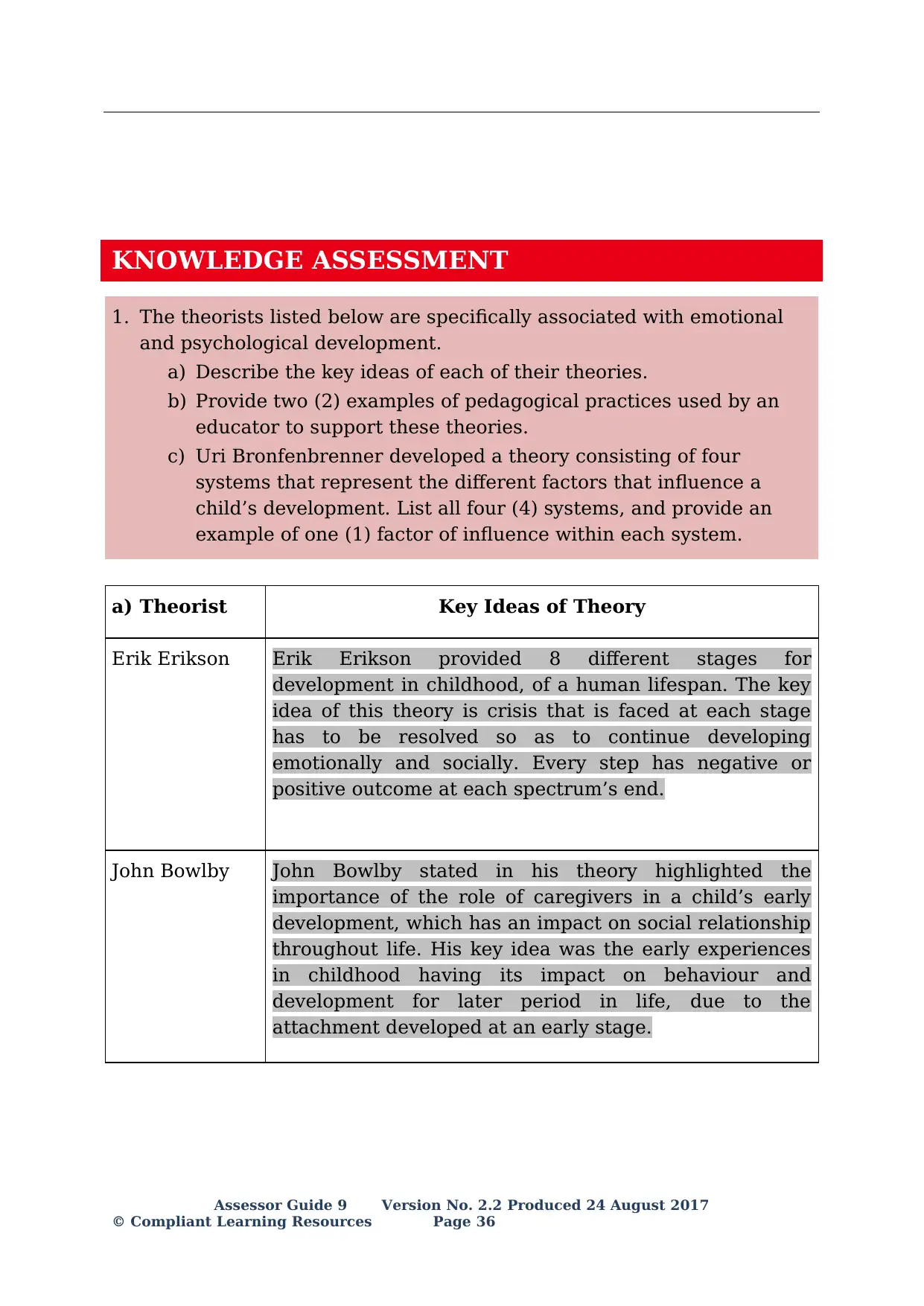
KNOWLEDGE ASSESSMENT
1. The theorists listed below are specifically associated with emotional
and psychological development.
a) Describe the key ideas of each of their theories.
b) Provide two (2) examples of pedagogical practices used by an
educator to support these theories.
c) Uri Bronfenbrenner developed a theory consisting of four
systems that represent the different factors that influence a
child’s development. List all four (4) systems, and provide an
example of one (1) factor of influence within each system.
a) Theorist Key Ideas of Theory
Erik Erikson Erik Erikson provided 8 different stages for
development in childhood, of a human lifespan. The key
idea of this theory is crisis that is faced at each stage
has to be resolved so as to continue developing
emotionally and socially. Every step has negative or
positive outcome at each spectrum’s end.
John Bowlby John Bowlby stated in his theory highlighted the
importance of the role of caregivers in a child’s early
development, which has an impact on social relationship
throughout life. His key idea was the early experiences
in childhood having its impact on behaviour and
development for later period in life, due to the
attachment developed at an early stage.
Assessor Guide 9 Version No. 2.2 Produced 24 August 2017
© Compliant Learning Resources Page 36
1. The theorists listed below are specifically associated with emotional
and psychological development.
a) Describe the key ideas of each of their theories.
b) Provide two (2) examples of pedagogical practices used by an
educator to support these theories.
c) Uri Bronfenbrenner developed a theory consisting of four
systems that represent the different factors that influence a
child’s development. List all four (4) systems, and provide an
example of one (1) factor of influence within each system.
a) Theorist Key Ideas of Theory
Erik Erikson Erik Erikson provided 8 different stages for
development in childhood, of a human lifespan. The key
idea of this theory is crisis that is faced at each stage
has to be resolved so as to continue developing
emotionally and socially. Every step has negative or
positive outcome at each spectrum’s end.
John Bowlby John Bowlby stated in his theory highlighted the
importance of the role of caregivers in a child’s early
development, which has an impact on social relationship
throughout life. His key idea was the early experiences
in childhood having its impact on behaviour and
development for later period in life, due to the
attachment developed at an early stage.
Assessor Guide 9 Version No. 2.2 Produced 24 August 2017
© Compliant Learning Resources Page 36

Mary
Ainsworth
Mary Ainsworth’s key ideas were focussed on Bowlby’s
work. Her ideas were based on developing a procedure
for testing the quality of attachments. The idea was
focussed on examining infant’s secure attachments.
b) Two examples of pedagogical practices:
i. Educators can use these theories for planning a rich environment
with play activities and routines for complete development.
ii. Educators can use these theories for planned experience in linking
them to learning goals.
c) Four systems that represent the different factors that influence a
child’s development and one example of one factor of each:
i. Micro system consists of a child’s immediate surrounding and
family members.
Example: Peers, parents and educators
ii. Mesosystem consists of the broader surrounding influencing a
child.
Example: Child’s family, child care centre, peers and neighbourhood
iii. Exosystem includes greater surroundings having indirect influence
on the child.
Example: Parent’s workplace, social groups, family friends and
community support services.
iv. Macrosystem includes the broader culture within which
individuals live.
Assessor Guide 9 Version No. 2.2 Produced 24 August 2017
Page 37 © Compliant Learning Resources
Ainsworth
Mary Ainsworth’s key ideas were focussed on Bowlby’s
work. Her ideas were based on developing a procedure
for testing the quality of attachments. The idea was
focussed on examining infant’s secure attachments.
b) Two examples of pedagogical practices:
i. Educators can use these theories for planning a rich environment
with play activities and routines for complete development.
ii. Educators can use these theories for planned experience in linking
them to learning goals.
c) Four systems that represent the different factors that influence a
child’s development and one example of one factor of each:
i. Micro system consists of a child’s immediate surrounding and
family members.
Example: Peers, parents and educators
ii. Mesosystem consists of the broader surrounding influencing a
child.
Example: Child’s family, child care centre, peers and neighbourhood
iii. Exosystem includes greater surroundings having indirect influence
on the child.
Example: Parent’s workplace, social groups, family friends and
community support services.
iv. Macrosystem includes the broader culture within which
individuals live.
Assessor Guide 9 Version No. 2.2 Produced 24 August 2017
Page 37 © Compliant Learning Resources
Paraphrase This Document
Need a fresh take? Get an instant paraphrase of this document with our AI Paraphraser

Example: Law, customs, values and circumstances of their country
and socioeconomic status, ethnicity and poverty.
Assessor Guide 9 Version No. 2.2 Produced 24 August 2017
© Compliant Learning Resources Page 38
and socioeconomic status, ethnicity and poverty.
Assessor Guide 9 Version No. 2.2 Produced 24 August 2017
© Compliant Learning Resources Page 38
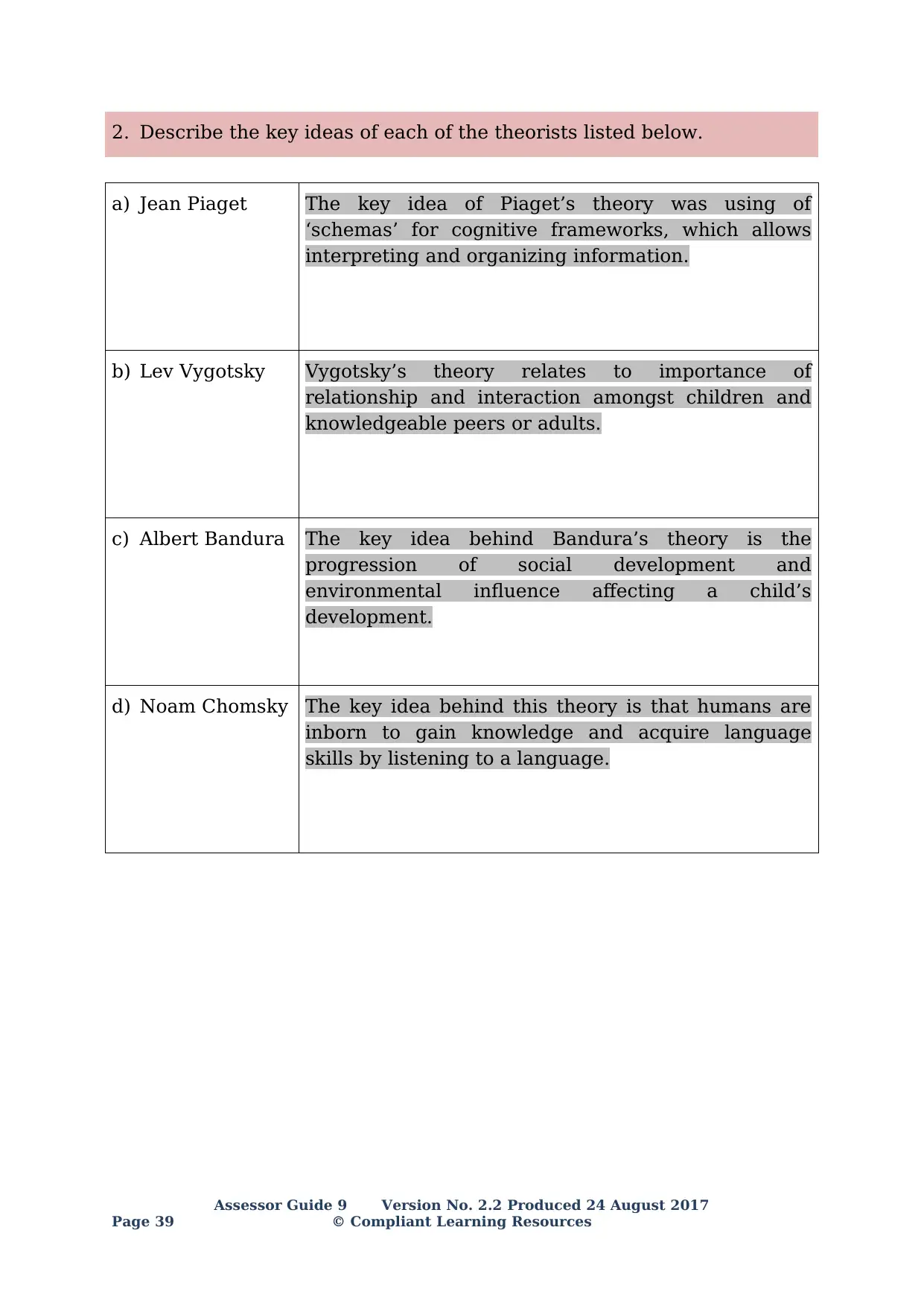
2. Describe the key ideas of each of the theorists listed below.
a) Jean Piaget The key idea of Piaget’s theory was using of
‘schemas’ for cognitive frameworks, which allows
interpreting and organizing information.
b) Lev Vygotsky Vygotsky’s theory relates to importance of
relationship and interaction amongst children and
knowledgeable peers or adults.
c) Albert Bandura The key idea behind Bandura’s theory is the
progression of social development and
environmental influence affecting a child’s
development.
d) Noam Chomsky The key idea behind this theory is that humans are
inborn to gain knowledge and acquire language
skills by listening to a language.
Assessor Guide 9 Version No. 2.2 Produced 24 August 2017
Page 39 © Compliant Learning Resources
a) Jean Piaget The key idea of Piaget’s theory was using of
‘schemas’ for cognitive frameworks, which allows
interpreting and organizing information.
b) Lev Vygotsky Vygotsky’s theory relates to importance of
relationship and interaction amongst children and
knowledgeable peers or adults.
c) Albert Bandura The key idea behind Bandura’s theory is the
progression of social development and
environmental influence affecting a child’s
development.
d) Noam Chomsky The key idea behind this theory is that humans are
inborn to gain knowledge and acquire language
skills by listening to a language.
Assessor Guide 9 Version No. 2.2 Produced 24 August 2017
Page 39 © Compliant Learning Resources
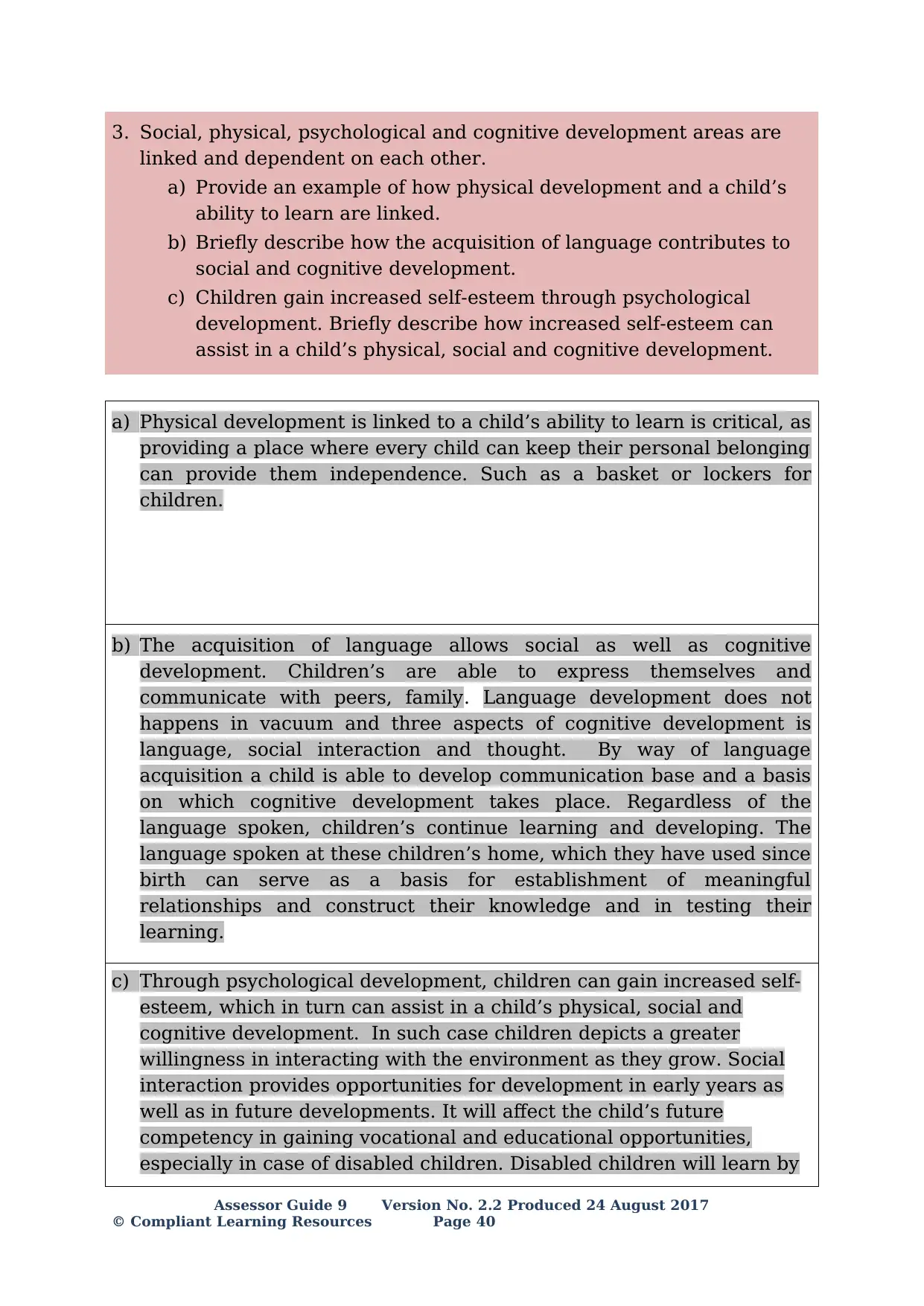
3. Social, physical, psychological and cognitive development areas are
linked and dependent on each other.
a) Provide an example of how physical development and a child’s
ability to learn are linked.
b) Briefly describe how the acquisition of language contributes to
social and cognitive development.
c) Children gain increased self-esteem through psychological
development. Briefly describe how increased self-esteem can
assist in a child’s physical, social and cognitive development.
a) Physical development is linked to a child’s ability to learn is critical, as
providing a place where every child can keep their personal belonging
can provide them independence. Such as a basket or lockers for
children.
b) The acquisition of language allows social as well as cognitive
development. Children’s are able to express themselves and
communicate with peers, family. Language development does not
happens in vacuum and three aspects of cognitive development is
language, social interaction and thought. By way of language
acquisition a child is able to develop communication base and a basis
on which cognitive development takes place. Regardless of the
language spoken, children’s continue learning and developing. The
language spoken at these children’s home, which they have used since
birth can serve as a basis for establishment of meaningful
relationships and construct their knowledge and in testing their
learning.
c) Through psychological development, children can gain increased self-
esteem, which in turn can assist in a child’s physical, social and
cognitive development. In such case children depicts a greater
willingness in interacting with the environment as they grow. Social
interaction provides opportunities for development in early years as
well as in future developments. It will affect the child’s future
competency in gaining vocational and educational opportunities,
especially in case of disabled children. Disabled children will learn by
Assessor Guide 9 Version No. 2.2 Produced 24 August 2017
© Compliant Learning Resources Page 40
linked and dependent on each other.
a) Provide an example of how physical development and a child’s
ability to learn are linked.
b) Briefly describe how the acquisition of language contributes to
social and cognitive development.
c) Children gain increased self-esteem through psychological
development. Briefly describe how increased self-esteem can
assist in a child’s physical, social and cognitive development.
a) Physical development is linked to a child’s ability to learn is critical, as
providing a place where every child can keep their personal belonging
can provide them independence. Such as a basket or lockers for
children.
b) The acquisition of language allows social as well as cognitive
development. Children’s are able to express themselves and
communicate with peers, family. Language development does not
happens in vacuum and three aspects of cognitive development is
language, social interaction and thought. By way of language
acquisition a child is able to develop communication base and a basis
on which cognitive development takes place. Regardless of the
language spoken, children’s continue learning and developing. The
language spoken at these children’s home, which they have used since
birth can serve as a basis for establishment of meaningful
relationships and construct their knowledge and in testing their
learning.
c) Through psychological development, children can gain increased self-
esteem, which in turn can assist in a child’s physical, social and
cognitive development. In such case children depicts a greater
willingness in interacting with the environment as they grow. Social
interaction provides opportunities for development in early years as
well as in future developments. It will affect the child’s future
competency in gaining vocational and educational opportunities,
especially in case of disabled children. Disabled children will learn by
Assessor Guide 9 Version No. 2.2 Produced 24 August 2017
© Compliant Learning Resources Page 40
Secure Best Marks with AI Grader
Need help grading? Try our AI Grader for instant feedback on your assignments.
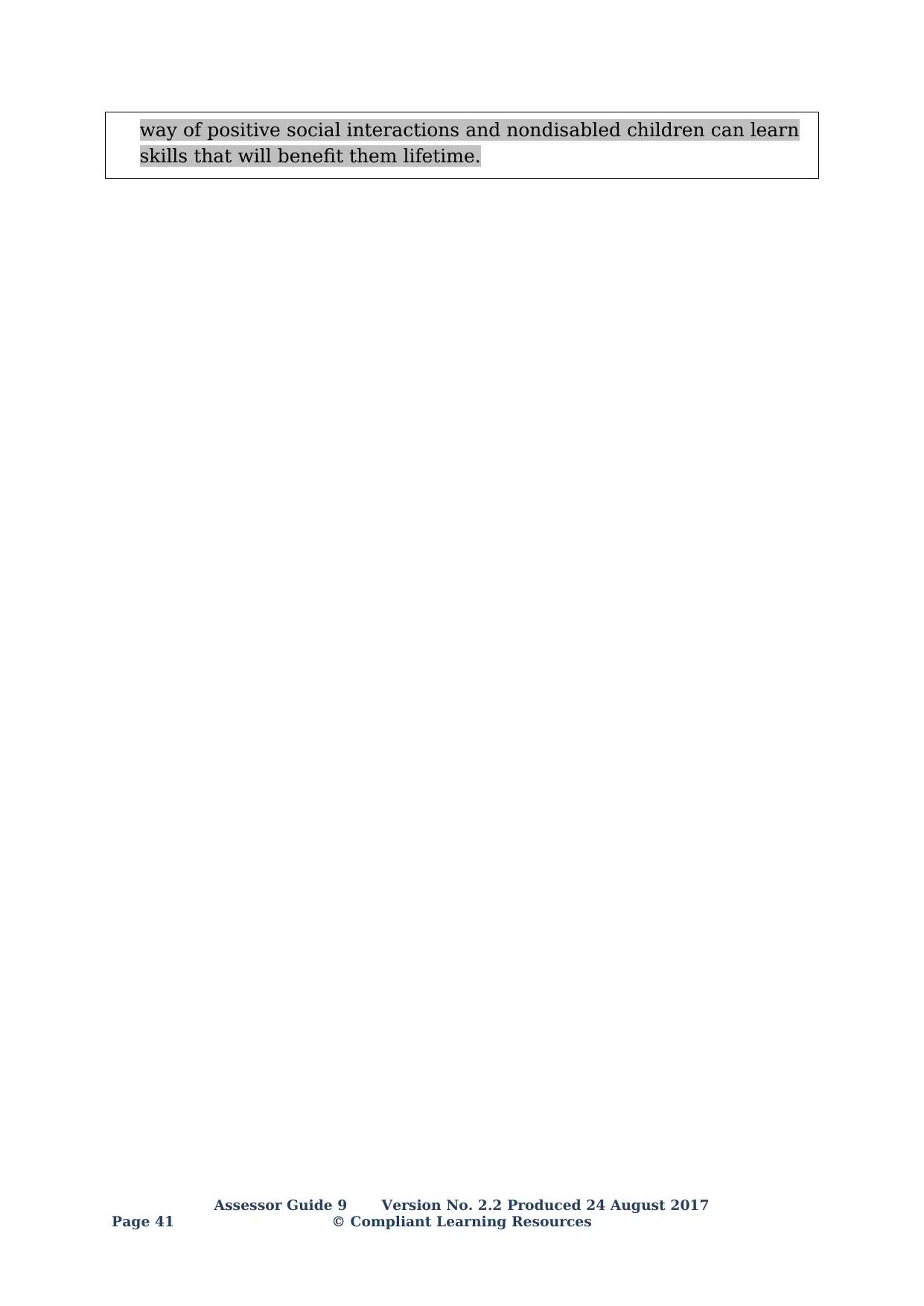
way of positive social interactions and nondisabled children can learn
skills that will benefit them lifetime.
Assessor Guide 9 Version No. 2.2 Produced 24 August 2017
Page 41 © Compliant Learning Resources
skills that will benefit them lifetime.
Assessor Guide 9 Version No. 2.2 Produced 24 August 2017
Page 41 © Compliant Learning Resources
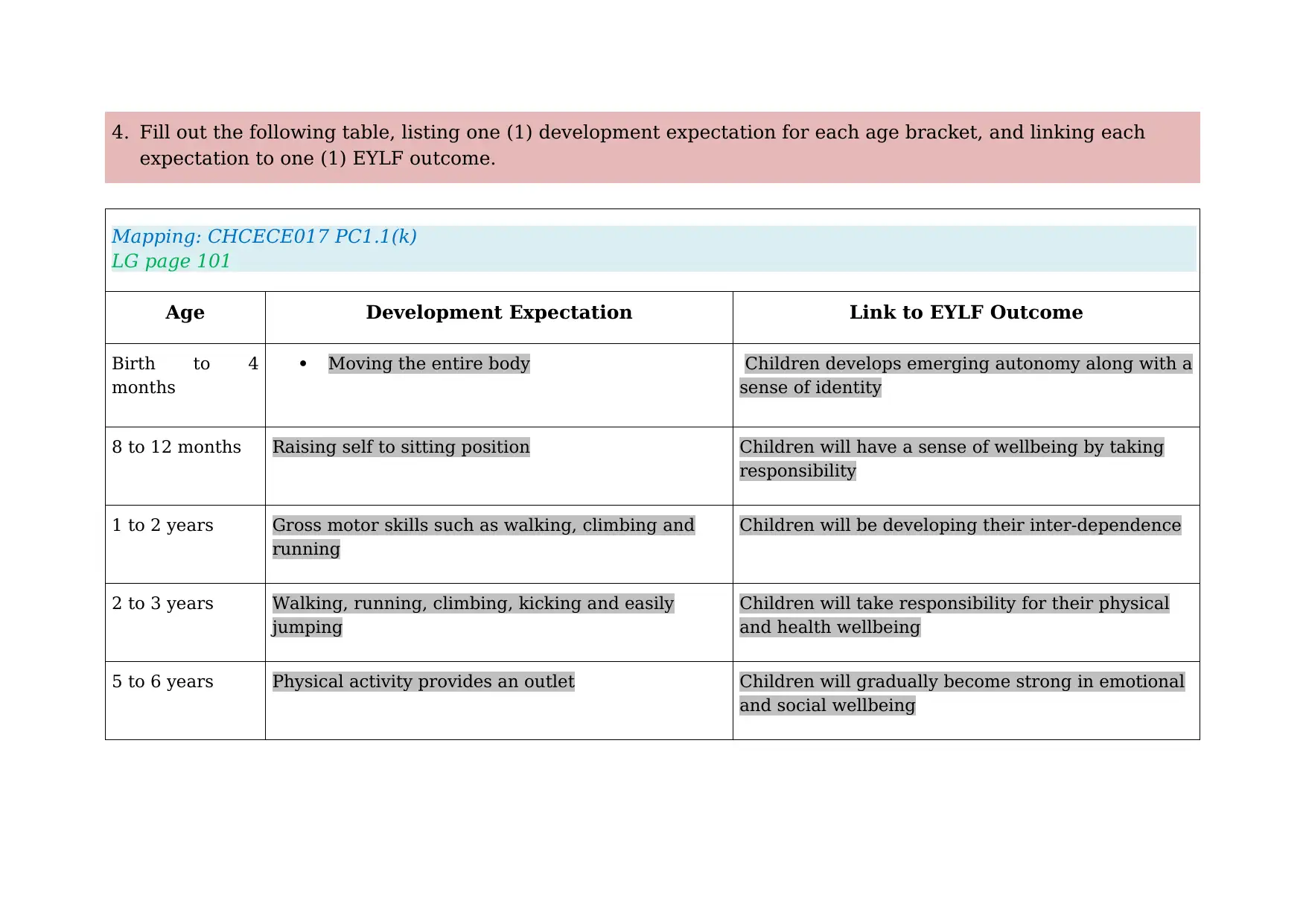
4. Fill out the following table, listing one (1) development expectation for each age bracket, and linking each
expectation to one (1) EYLF outcome.
Mapping: CHCECE017 PC1.1(k)
LG page 101
Age Development Expectation Link to EYLF Outcome
Birth to 4
months
Moving the entire body Children develops emerging autonomy along with a
sense of identity
8 to 12 months Raising self to sitting position Children will have a sense of wellbeing by taking
responsibility
1 to 2 years Gross motor skills such as walking, climbing and
running
Children will be developing their inter-dependence
2 to 3 years Walking, running, climbing, kicking and easily
jumping
Children will take responsibility for their physical
and health wellbeing
5 to 6 years Physical activity provides an outlet Children will gradually become strong in emotional
and social wellbeing
expectation to one (1) EYLF outcome.
Mapping: CHCECE017 PC1.1(k)
LG page 101
Age Development Expectation Link to EYLF Outcome
Birth to 4
months
Moving the entire body Children develops emerging autonomy along with a
sense of identity
8 to 12 months Raising self to sitting position Children will have a sense of wellbeing by taking
responsibility
1 to 2 years Gross motor skills such as walking, climbing and
running
Children will be developing their inter-dependence
2 to 3 years Walking, running, climbing, kicking and easily
jumping
Children will take responsibility for their physical
and health wellbeing
5 to 6 years Physical activity provides an outlet Children will gradually become strong in emotional
and social wellbeing
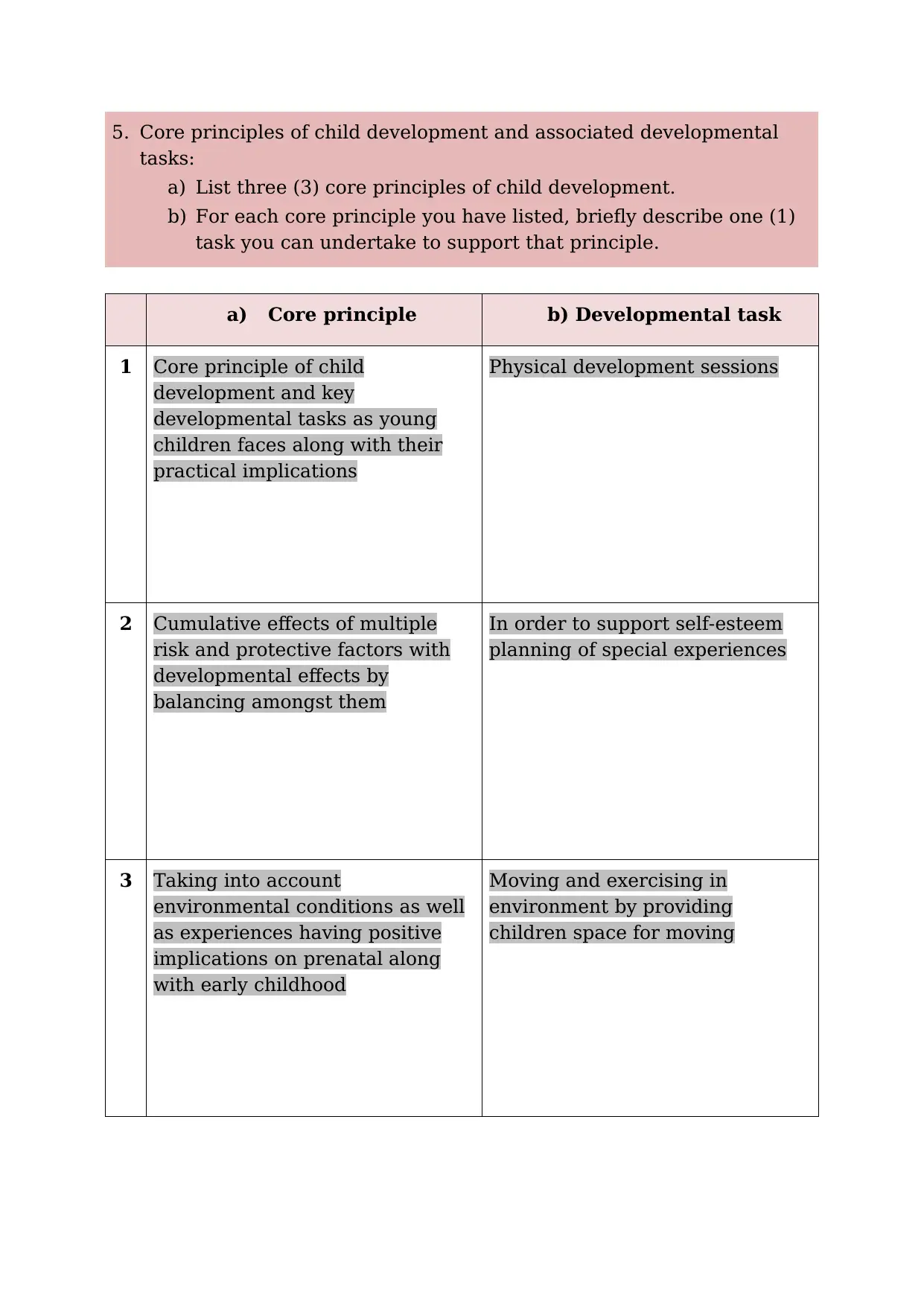
5. Core principles of child development and associated developmental
tasks:
a) List three (3) core principles of child development.
b) For each core principle you have listed, briefly describe one (1)
task you can undertake to support that principle.
a) Core principle b) Developmental task
1 Core principle of child
development and key
developmental tasks as young
children faces along with their
practical implications
Physical development sessions
2 Cumulative effects of multiple
risk and protective factors with
developmental effects by
balancing amongst them
In order to support self-esteem
planning of special experiences
3 Taking into account
environmental conditions as well
as experiences having positive
implications on prenatal along
with early childhood
Moving and exercising in
environment by providing
children space for moving
tasks:
a) List three (3) core principles of child development.
b) For each core principle you have listed, briefly describe one (1)
task you can undertake to support that principle.
a) Core principle b) Developmental task
1 Core principle of child
development and key
developmental tasks as young
children faces along with their
practical implications
Physical development sessions
2 Cumulative effects of multiple
risk and protective factors with
developmental effects by
balancing amongst them
In order to support self-esteem
planning of special experiences
3 Taking into account
environmental conditions as well
as experiences having positive
implications on prenatal along
with early childhood
Moving and exercising in
environment by providing
children space for moving
Paraphrase This Document
Need a fresh take? Get an instant paraphrase of this document with our AI Paraphraser
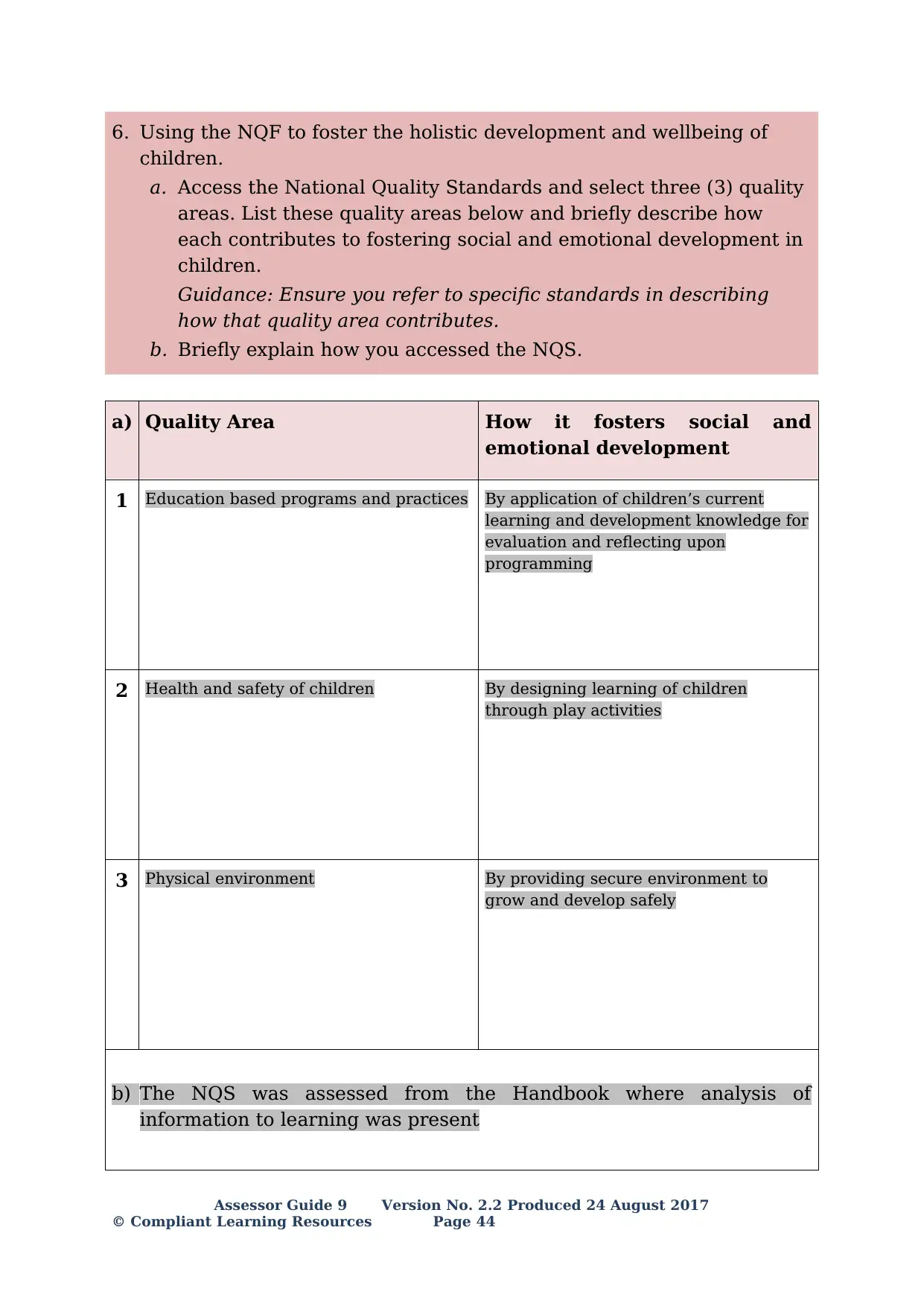
6. Using the NQF to foster the holistic development and wellbeing of
children.
a. Access the National Quality Standards and select three (3) quality
areas. List these quality areas below and briefly describe how
each contributes to fostering social and emotional development in
children.
Guidance: Ensure you refer to specific standards in describing
how that quality area contributes.
b. Briefly explain how you accessed the NQS.
a) Quality Area How it fosters social and
emotional development
1 Education based programs and practices By application of children’s current
learning and development knowledge for
evaluation and reflecting upon
programming
2 Health and safety of children By designing learning of children
through play activities
3 Physical environment By providing secure environment to
grow and develop safely
b) The NQS was assessed from the Handbook where analysis of
information to learning was present
Assessor Guide 9 Version No. 2.2 Produced 24 August 2017
© Compliant Learning Resources Page 44
children.
a. Access the National Quality Standards and select three (3) quality
areas. List these quality areas below and briefly describe how
each contributes to fostering social and emotional development in
children.
Guidance: Ensure you refer to specific standards in describing
how that quality area contributes.
b. Briefly explain how you accessed the NQS.
a) Quality Area How it fosters social and
emotional development
1 Education based programs and practices By application of children’s current
learning and development knowledge for
evaluation and reflecting upon
programming
2 Health and safety of children By designing learning of children
through play activities
3 Physical environment By providing secure environment to
grow and develop safely
b) The NQS was assessed from the Handbook where analysis of
information to learning was present
Assessor Guide 9 Version No. 2.2 Produced 24 August 2017
© Compliant Learning Resources Page 44
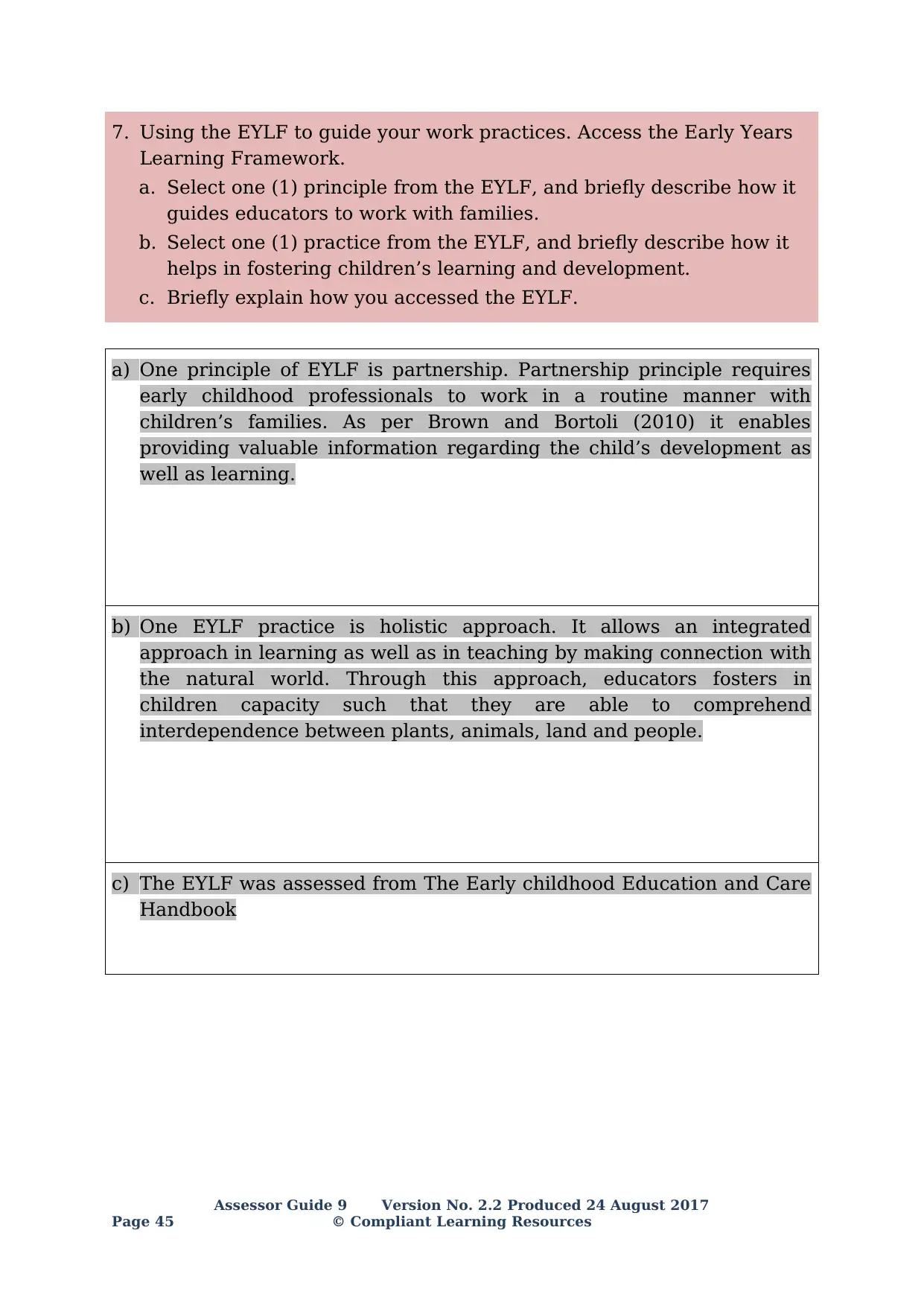
7. Using the EYLF to guide your work practices. Access the Early Years
Learning Framework.
a. Select one (1) principle from the EYLF, and briefly describe how it
guides educators to work with families.
b. Select one (1) practice from the EYLF, and briefly describe how it
helps in fostering children’s learning and development.
c. Briefly explain how you accessed the EYLF.
a) One principle of EYLF is partnership. Partnership principle requires
early childhood professionals to work in a routine manner with
children’s families. As per Brown and Bortoli (2010) it enables
providing valuable information regarding the child’s development as
well as learning.
b) One EYLF practice is holistic approach. It allows an integrated
approach in learning as well as in teaching by making connection with
the natural world. Through this approach, educators fosters in
children capacity such that they are able to comprehend
interdependence between plants, animals, land and people.
c) The EYLF was assessed from The Early childhood Education and Care
Handbook
Assessor Guide 9 Version No. 2.2 Produced 24 August 2017
Page 45 © Compliant Learning Resources
Learning Framework.
a. Select one (1) principle from the EYLF, and briefly describe how it
guides educators to work with families.
b. Select one (1) practice from the EYLF, and briefly describe how it
helps in fostering children’s learning and development.
c. Briefly explain how you accessed the EYLF.
a) One principle of EYLF is partnership. Partnership principle requires
early childhood professionals to work in a routine manner with
children’s families. As per Brown and Bortoli (2010) it enables
providing valuable information regarding the child’s development as
well as learning.
b) One EYLF practice is holistic approach. It allows an integrated
approach in learning as well as in teaching by making connection with
the natural world. Through this approach, educators fosters in
children capacity such that they are able to comprehend
interdependence between plants, animals, land and people.
c) The EYLF was assessed from The Early childhood Education and Care
Handbook
Assessor Guide 9 Version No. 2.2 Produced 24 August 2017
Page 45 © Compliant Learning Resources
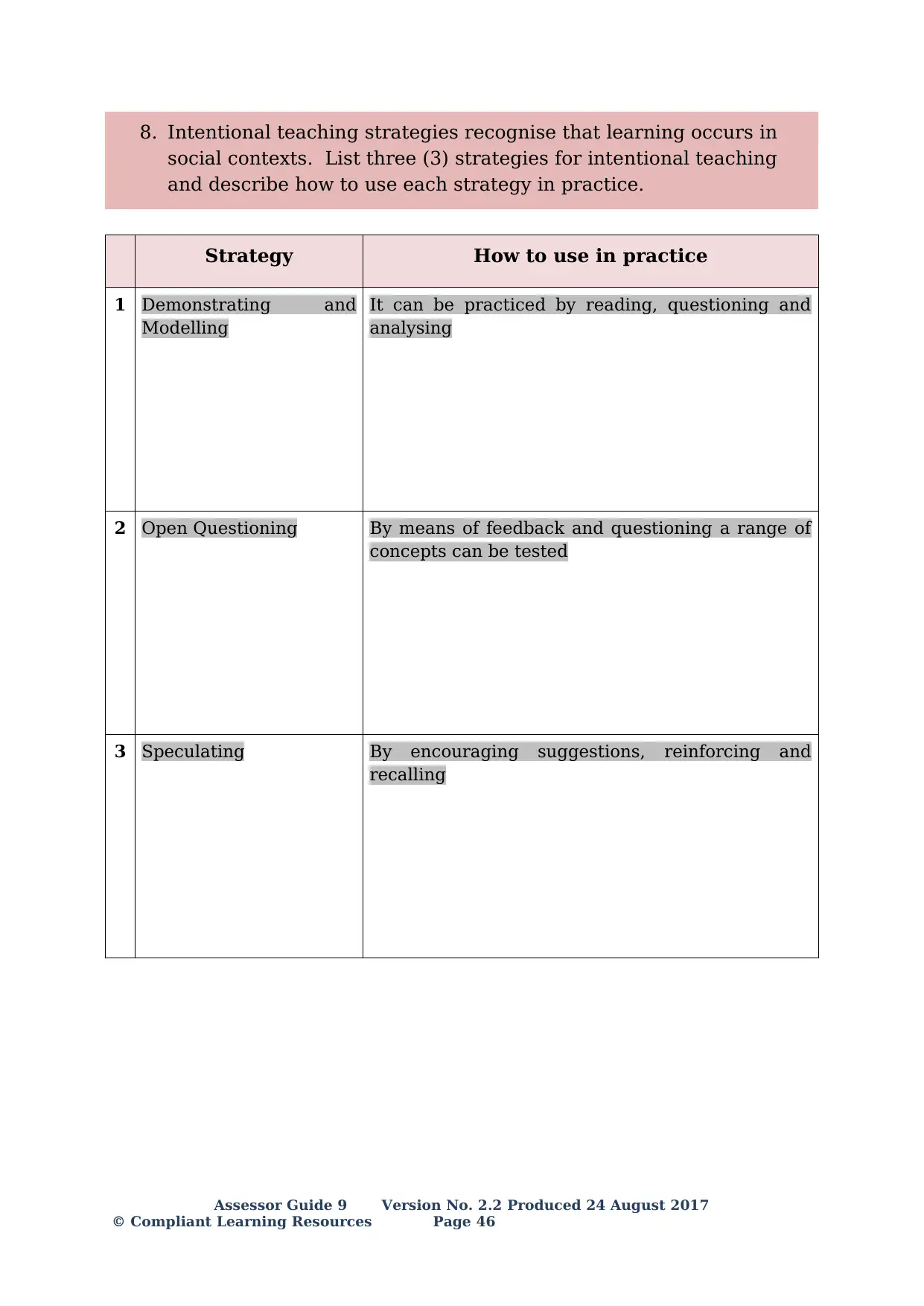
8. Intentional teaching strategies recognise that learning occurs in
social contexts. List three (3) strategies for intentional teaching
and describe how to use each strategy in practice.
Strategy How to use in practice
1 Demonstrating and
Modelling
It can be practiced by reading, questioning and
analysing
2 Open Questioning By means of feedback and questioning a range of
concepts can be tested
3 Speculating By encouraging suggestions, reinforcing and
recalling
Assessor Guide 9 Version No. 2.2 Produced 24 August 2017
© Compliant Learning Resources Page 46
social contexts. List three (3) strategies for intentional teaching
and describe how to use each strategy in practice.
Strategy How to use in practice
1 Demonstrating and
Modelling
It can be practiced by reading, questioning and
analysing
2 Open Questioning By means of feedback and questioning a range of
concepts can be tested
3 Speculating By encouraging suggestions, reinforcing and
recalling
Assessor Guide 9 Version No. 2.2 Produced 24 August 2017
© Compliant Learning Resources Page 46
Secure Best Marks with AI Grader
Need help grading? Try our AI Grader for instant feedback on your assignments.
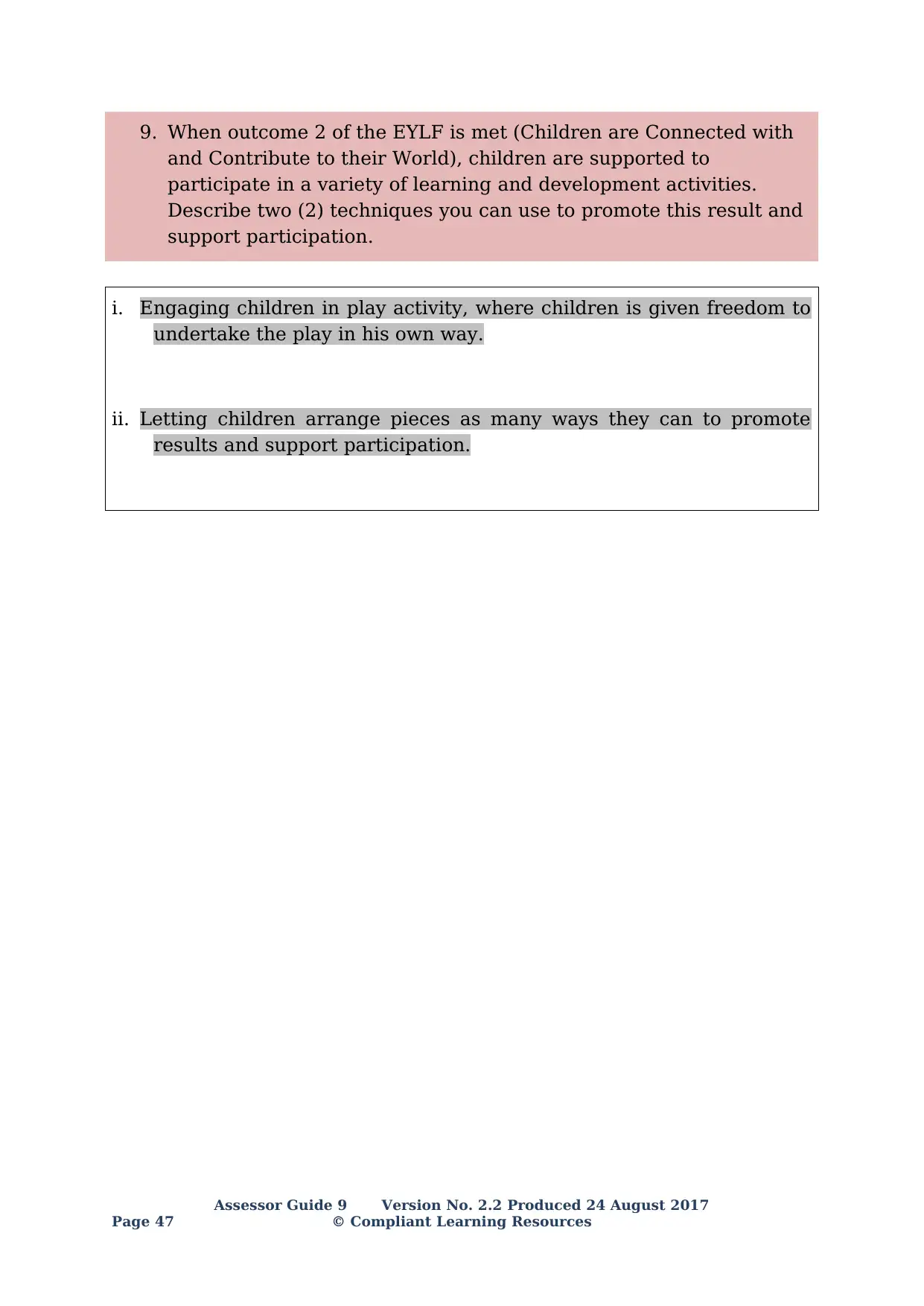
9. When outcome 2 of the EYLF is met (Children are Connected with
and Contribute to their World), children are supported to
participate in a variety of learning and development activities.
Describe two (2) techniques you can use to promote this result and
support participation.
i. Engaging children in play activity, where children is given freedom to
undertake the play in his own way.
ii. Letting children arrange pieces as many ways they can to promote
results and support participation.
Assessor Guide 9 Version No. 2.2 Produced 24 August 2017
Page 47 © Compliant Learning Resources
and Contribute to their World), children are supported to
participate in a variety of learning and development activities.
Describe two (2) techniques you can use to promote this result and
support participation.
i. Engaging children in play activity, where children is given freedom to
undertake the play in his own way.
ii. Letting children arrange pieces as many ways they can to promote
results and support participation.
Assessor Guide 9 Version No. 2.2 Produced 24 August 2017
Page 47 © Compliant Learning Resources
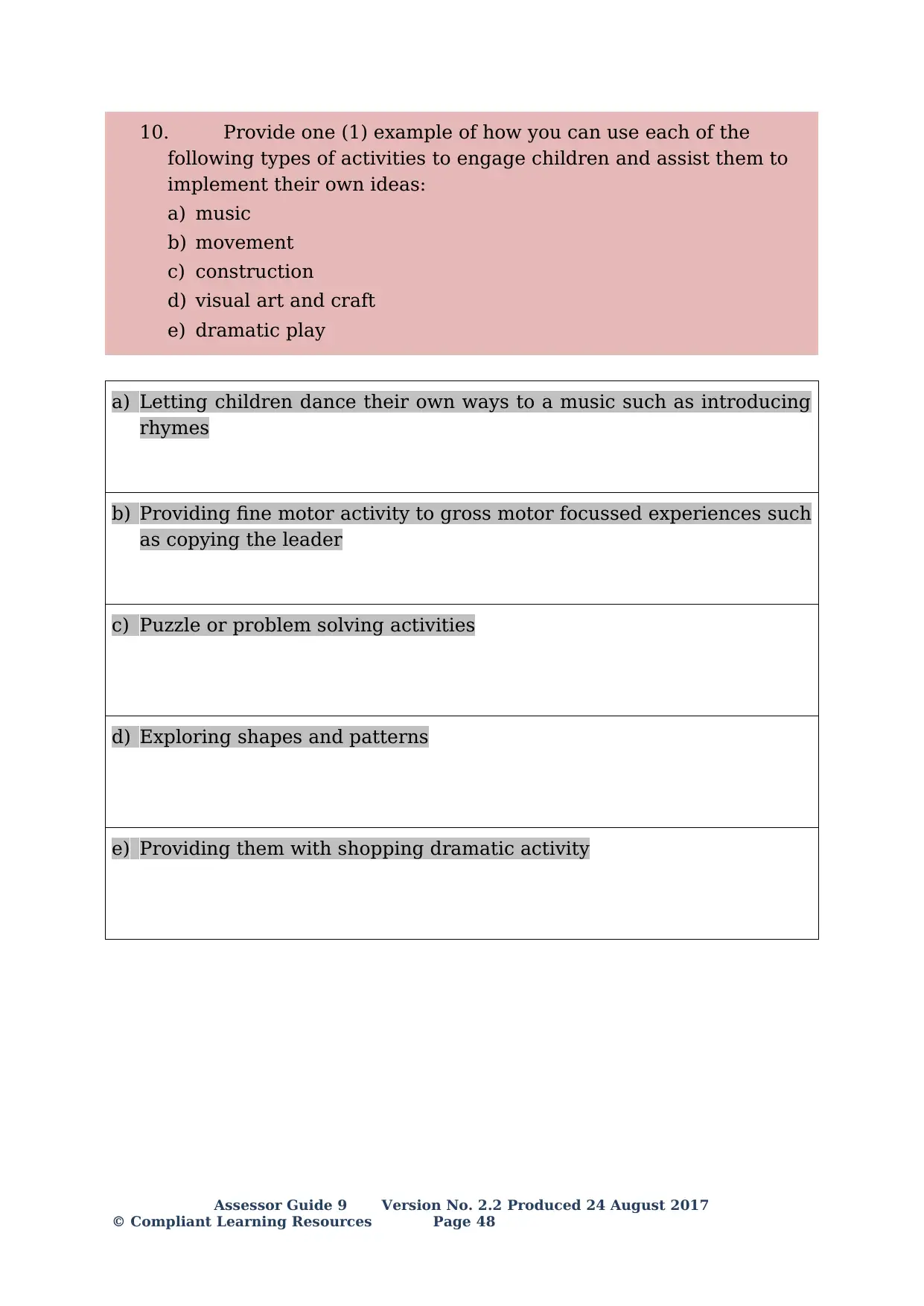
10. Provide one (1) example of how you can use each of the
following types of activities to engage children and assist them to
implement their own ideas:
a) music
b) movement
c) construction
d) visual art and craft
e) dramatic play
a) Letting children dance their own ways to a music such as introducing
rhymes
b) Providing fine motor activity to gross motor focussed experiences such
as copying the leader
c) Puzzle or problem solving activities
d) Exploring shapes and patterns
e) Providing them with shopping dramatic activity
Assessor Guide 9 Version No. 2.2 Produced 24 August 2017
© Compliant Learning Resources Page 48
following types of activities to engage children and assist them to
implement their own ideas:
a) music
b) movement
c) construction
d) visual art and craft
e) dramatic play
a) Letting children dance their own ways to a music such as introducing
rhymes
b) Providing fine motor activity to gross motor focussed experiences such
as copying the leader
c) Puzzle or problem solving activities
d) Exploring shapes and patterns
e) Providing them with shopping dramatic activity
Assessor Guide 9 Version No. 2.2 Produced 24 August 2017
© Compliant Learning Resources Page 48
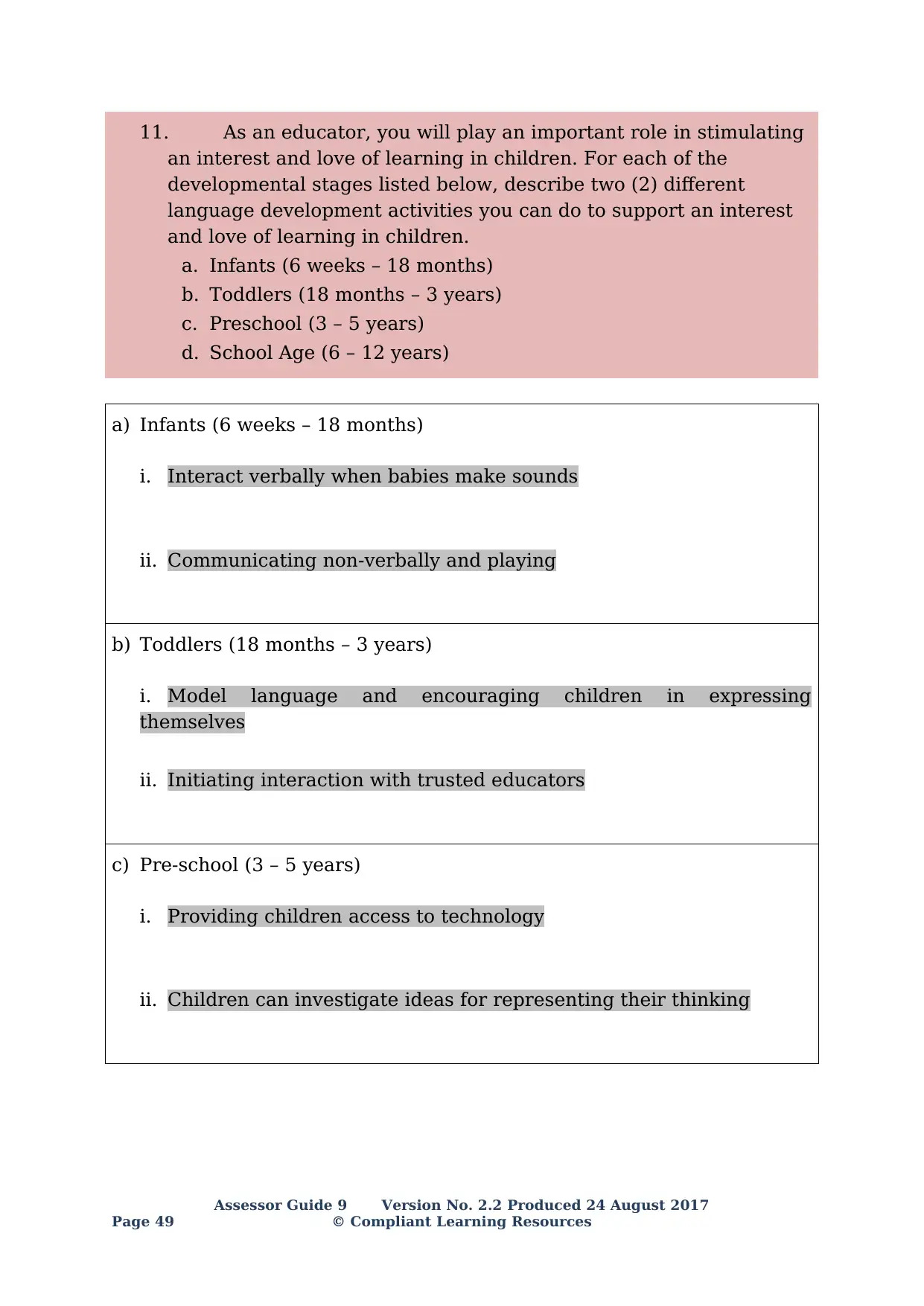
11. As an educator, you will play an important role in stimulating
an interest and love of learning in children. For each of the
developmental stages listed below, describe two (2) different
language development activities you can do to support an interest
and love of learning in children.
a. Infants (6 weeks – 18 months)
b. Toddlers (18 months – 3 years)
c. Preschool (3 – 5 years)
d. School Age (6 – 12 years)
a) Infants (6 weeks – 18 months)
i. Interact verbally when babies make sounds
ii. Communicating non-verbally and playing
b) Toddlers (18 months – 3 years)
i. Model language and encouraging children in expressing
themselves
ii. Initiating interaction with trusted educators
c) Pre-school (3 – 5 years)
i. Providing children access to technology
ii. Children can investigate ideas for representing their thinking
Assessor Guide 9 Version No. 2.2 Produced 24 August 2017
Page 49 © Compliant Learning Resources
an interest and love of learning in children. For each of the
developmental stages listed below, describe two (2) different
language development activities you can do to support an interest
and love of learning in children.
a. Infants (6 weeks – 18 months)
b. Toddlers (18 months – 3 years)
c. Preschool (3 – 5 years)
d. School Age (6 – 12 years)
a) Infants (6 weeks – 18 months)
i. Interact verbally when babies make sounds
ii. Communicating non-verbally and playing
b) Toddlers (18 months – 3 years)
i. Model language and encouraging children in expressing
themselves
ii. Initiating interaction with trusted educators
c) Pre-school (3 – 5 years)
i. Providing children access to technology
ii. Children can investigate ideas for representing their thinking
Assessor Guide 9 Version No. 2.2 Produced 24 August 2017
Page 49 © Compliant Learning Resources
Paraphrase This Document
Need a fresh take? Get an instant paraphrase of this document with our AI Paraphraser

d) School Age (6 – 12 years)
i. Interacting with children for a range of purposes
ii. Children will be made to collaborate with others while expressing
their ideas
12. Your role as an educator requires that you foster holistic
development by establishing learning programs and an environment
that reflects and is responsive to the children’s interests, and achieves
learning outcomes.
a. List three (3) considerations for designing a holistic learning
environment.
b. Describe three (3) strategies for designing and implementing
curriculum in collaboration with children.
a) Three considerations for designing a holistic learning environment:
i. Designing task, experience and activities which are meaningful
for the child
ii. Providing opportunities for open-ended exploration
iii. Warm, consistent relationship by connecting together everything
b) Three strategies for designing and implementing curriculum in
collaboration with children:
i. Educators are aware of children’s interests and understanding by
working on a single idea
ii. Challenging children’s thinking through engagement in thinking
process
iii. Developing a relationship of trust amongst children and adults
Assessor Guide 9 Version No. 2.2 Produced 24 August 2017
© Compliant Learning Resources Page 50
i. Interacting with children for a range of purposes
ii. Children will be made to collaborate with others while expressing
their ideas
12. Your role as an educator requires that you foster holistic
development by establishing learning programs and an environment
that reflects and is responsive to the children’s interests, and achieves
learning outcomes.
a. List three (3) considerations for designing a holistic learning
environment.
b. Describe three (3) strategies for designing and implementing
curriculum in collaboration with children.
a) Three considerations for designing a holistic learning environment:
i. Designing task, experience and activities which are meaningful
for the child
ii. Providing opportunities for open-ended exploration
iii. Warm, consistent relationship by connecting together everything
b) Three strategies for designing and implementing curriculum in
collaboration with children:
i. Educators are aware of children’s interests and understanding by
working on a single idea
ii. Challenging children’s thinking through engagement in thinking
process
iii. Developing a relationship of trust amongst children and adults
Assessor Guide 9 Version No. 2.2 Produced 24 August 2017
© Compliant Learning Resources Page 50
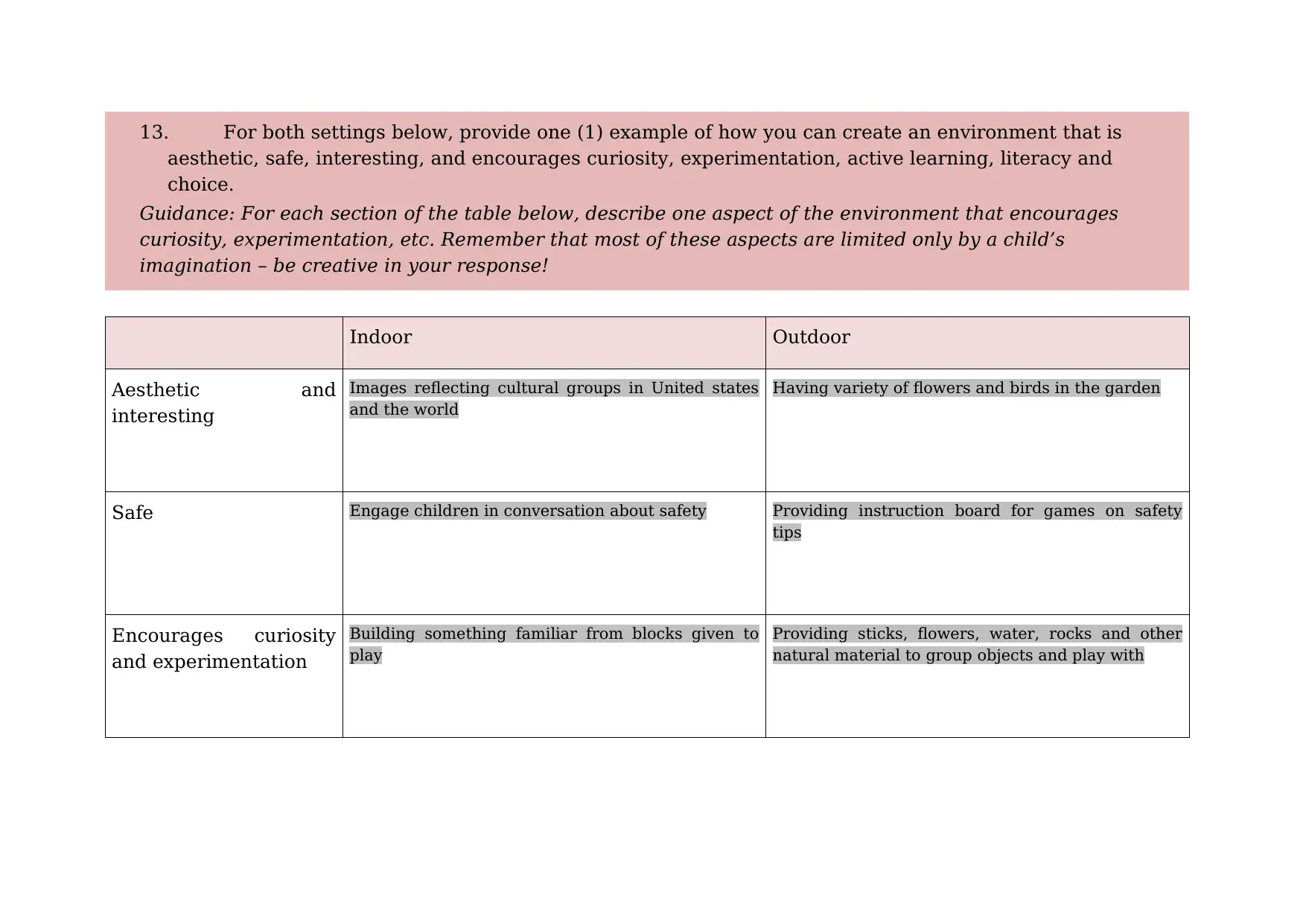
13. For both settings below, provide one (1) example of how you can create an environment that is
aesthetic, safe, interesting, and encourages curiosity, experimentation, active learning, literacy and
choice.
Guidance: For each section of the table below, describe one aspect of the environment that encourages
curiosity, experimentation, etc. Remember that most of these aspects are limited only by a child’s
imagination – be creative in your response!
Indoor Outdoor
Aesthetic and
interesting
Images reflecting cultural groups in United states
and the world
Having variety of flowers and birds in the garden
Safe Engage children in conversation about safety Providing instruction board for games on safety
tips
Encourages curiosity
and experimentation
Building something familiar from blocks given to
play
Providing sticks, flowers, water, rocks and other
natural material to group objects and play with
aesthetic, safe, interesting, and encourages curiosity, experimentation, active learning, literacy and
choice.
Guidance: For each section of the table below, describe one aspect of the environment that encourages
curiosity, experimentation, etc. Remember that most of these aspects are limited only by a child’s
imagination – be creative in your response!
Indoor Outdoor
Aesthetic and
interesting
Images reflecting cultural groups in United states
and the world
Having variety of flowers and birds in the garden
Safe Engage children in conversation about safety Providing instruction board for games on safety
tips
Encourages curiosity
and experimentation
Building something familiar from blocks given to
play
Providing sticks, flowers, water, rocks and other
natural material to group objects and play with
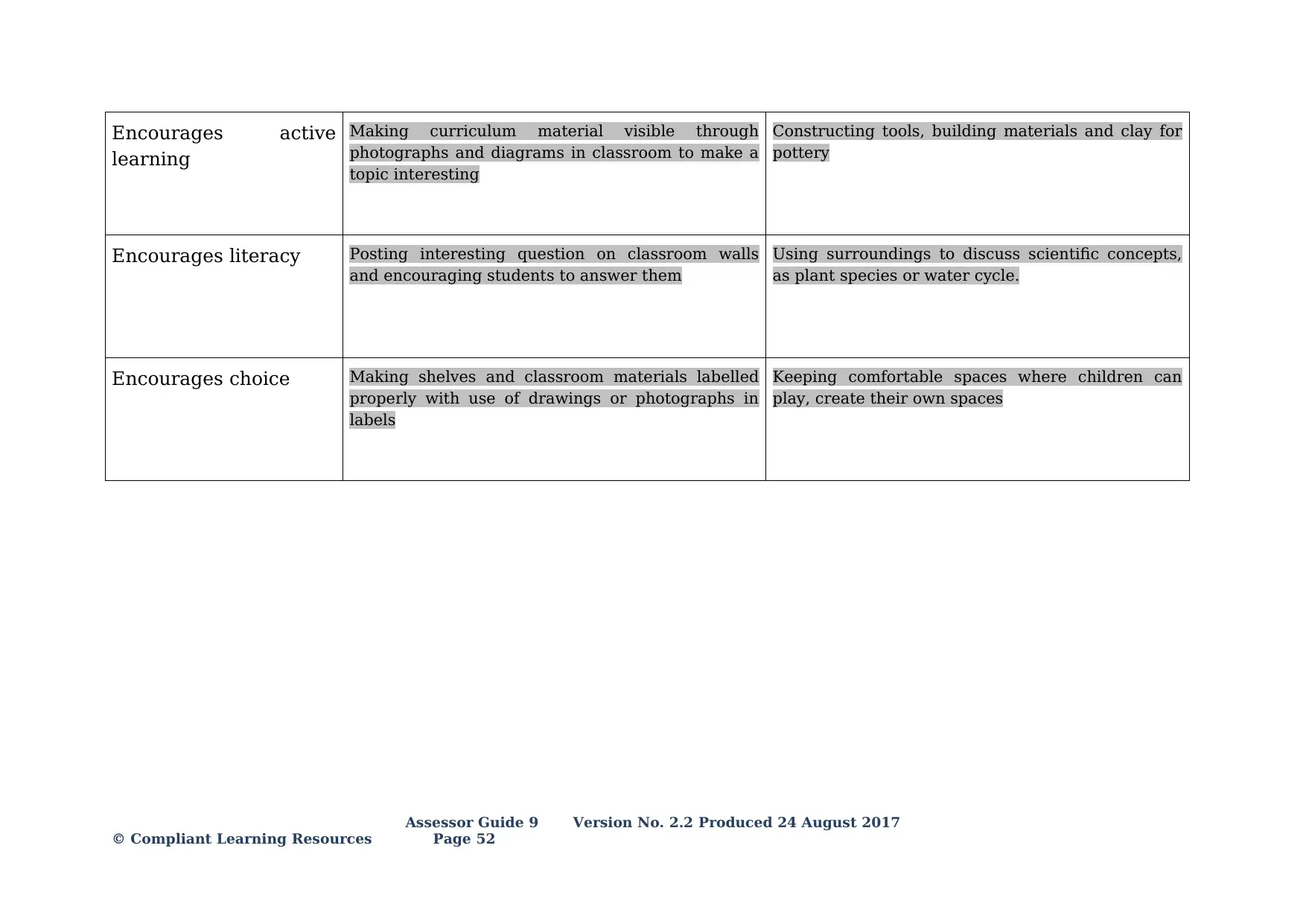
Encourages active
learning
Making curriculum material visible through
photographs and diagrams in classroom to make a
topic interesting
Constructing tools, building materials and clay for
pottery
Encourages literacy Posting interesting question on classroom walls
and encouraging students to answer them
Using surroundings to discuss scientific concepts,
as plant species or water cycle.
Encourages choice Making shelves and classroom materials labelled
properly with use of drawings or photographs in
labels
Keeping comfortable spaces where children can
play, create their own spaces
Assessor Guide 9 Version No. 2.2 Produced 24 August 2017
© Compliant Learning Resources Page 52
learning
Making curriculum material visible through
photographs and diagrams in classroom to make a
topic interesting
Constructing tools, building materials and clay for
pottery
Encourages literacy Posting interesting question on classroom walls
and encouraging students to answer them
Using surroundings to discuss scientific concepts,
as plant species or water cycle.
Encourages choice Making shelves and classroom materials labelled
properly with use of drawings or photographs in
labels
Keeping comfortable spaces where children can
play, create their own spaces
Assessor Guide 9 Version No. 2.2 Produced 24 August 2017
© Compliant Learning Resources Page 52
Secure Best Marks with AI Grader
Need help grading? Try our AI Grader for instant feedback on your assignments.
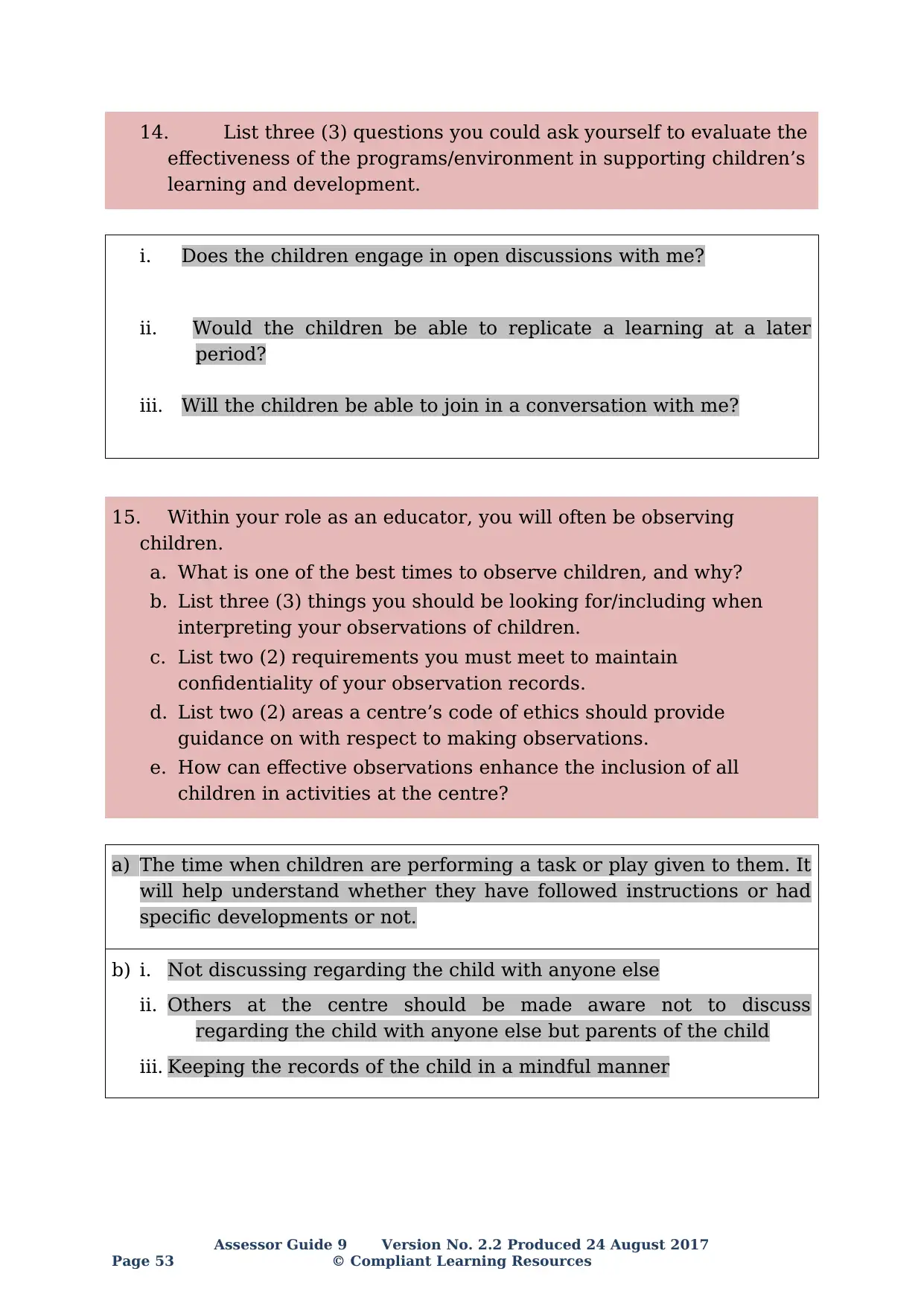
14. List three (3) questions you could ask yourself to evaluate the
effectiveness of the programs/environment in supporting children’s
learning and development.
i. Does the children engage in open discussions with me?
ii. Would the children be able to replicate a learning at a later
period?
iii. Will the children be able to join in a conversation with me?
15. Within your role as an educator, you will often be observing
children.
a. What is one of the best times to observe children, and why?
b. List three (3) things you should be looking for/including when
interpreting your observations of children.
c. List two (2) requirements you must meet to maintain
confidentiality of your observation records.
d. List two (2) areas a centre’s code of ethics should provide
guidance on with respect to making observations.
e. How can effective observations enhance the inclusion of all
children in activities at the centre?
a) The time when children are performing a task or play given to them. It
will help understand whether they have followed instructions or had
specific developments or not.
b) i. Not discussing regarding the child with anyone else
ii. Others at the centre should be made aware not to discuss
regarding the child with anyone else but parents of the child
iii. Keeping the records of the child in a mindful manner
Assessor Guide 9 Version No. 2.2 Produced 24 August 2017
Page 53 © Compliant Learning Resources
effectiveness of the programs/environment in supporting children’s
learning and development.
i. Does the children engage in open discussions with me?
ii. Would the children be able to replicate a learning at a later
period?
iii. Will the children be able to join in a conversation with me?
15. Within your role as an educator, you will often be observing
children.
a. What is one of the best times to observe children, and why?
b. List three (3) things you should be looking for/including when
interpreting your observations of children.
c. List two (2) requirements you must meet to maintain
confidentiality of your observation records.
d. List two (2) areas a centre’s code of ethics should provide
guidance on with respect to making observations.
e. How can effective observations enhance the inclusion of all
children in activities at the centre?
a) The time when children are performing a task or play given to them. It
will help understand whether they have followed instructions or had
specific developments or not.
b) i. Not discussing regarding the child with anyone else
ii. Others at the centre should be made aware not to discuss
regarding the child with anyone else but parents of the child
iii. Keeping the records of the child in a mindful manner
Assessor Guide 9 Version No. 2.2 Produced 24 August 2017
Page 53 © Compliant Learning Resources
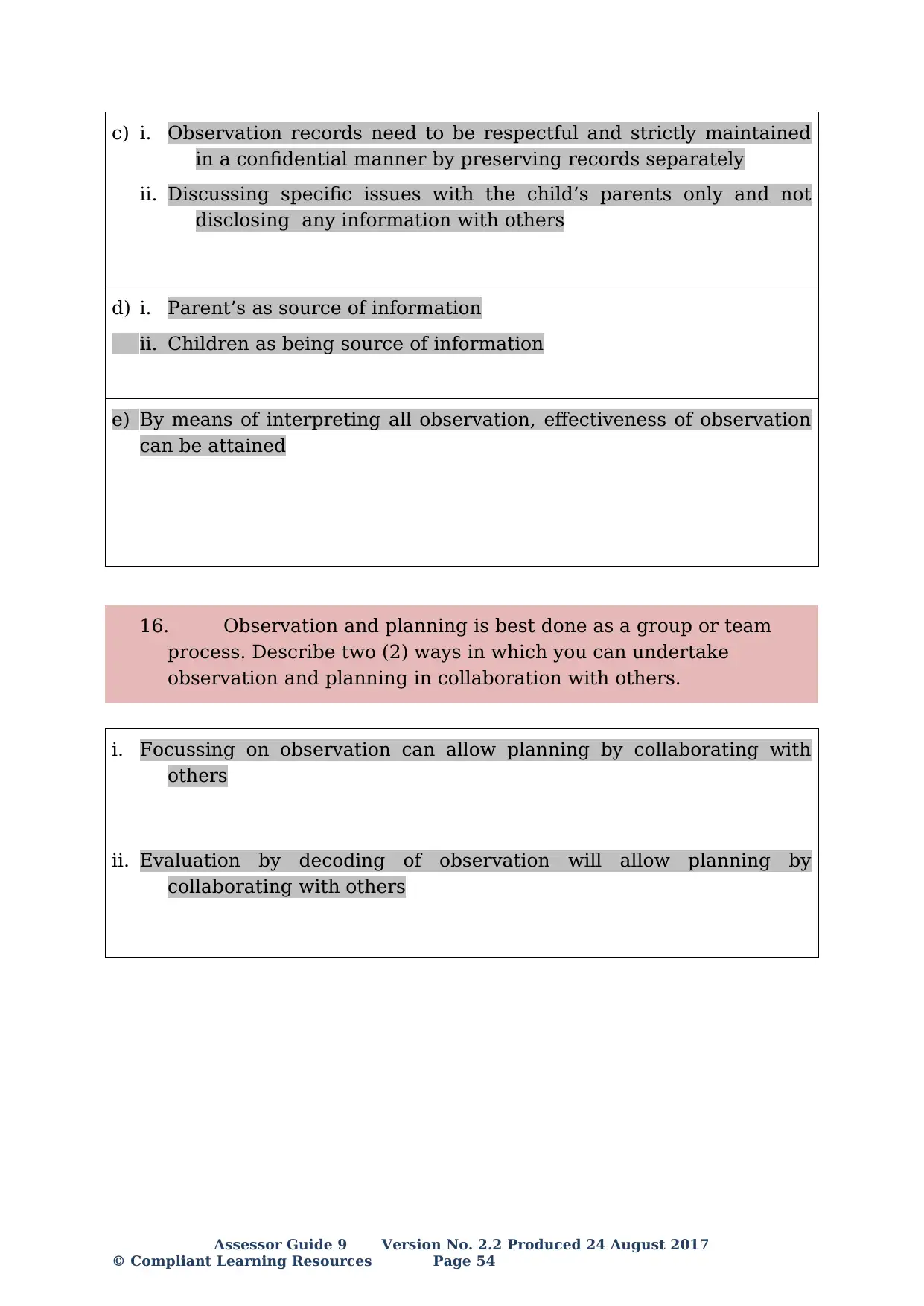
c) i. Observation records need to be respectful and strictly maintained
in a confidential manner by preserving records separately
ii. Discussing specific issues with the child’s parents only and not
disclosing any information with others
d) i. Parent’s as source of information
ii. Children as being source of information
e) By means of interpreting all observation, effectiveness of observation
can be attained
16. Observation and planning is best done as a group or team
process. Describe two (2) ways in which you can undertake
observation and planning in collaboration with others.
i. Focussing on observation can allow planning by collaborating with
others
ii. Evaluation by decoding of observation will allow planning by
collaborating with others
Assessor Guide 9 Version No. 2.2 Produced 24 August 2017
© Compliant Learning Resources Page 54
in a confidential manner by preserving records separately
ii. Discussing specific issues with the child’s parents only and not
disclosing any information with others
d) i. Parent’s as source of information
ii. Children as being source of information
e) By means of interpreting all observation, effectiveness of observation
can be attained
16. Observation and planning is best done as a group or team
process. Describe two (2) ways in which you can undertake
observation and planning in collaboration with others.
i. Focussing on observation can allow planning by collaborating with
others
ii. Evaluation by decoding of observation will allow planning by
collaborating with others
Assessor Guide 9 Version No. 2.2 Produced 24 August 2017
© Compliant Learning Resources Page 54
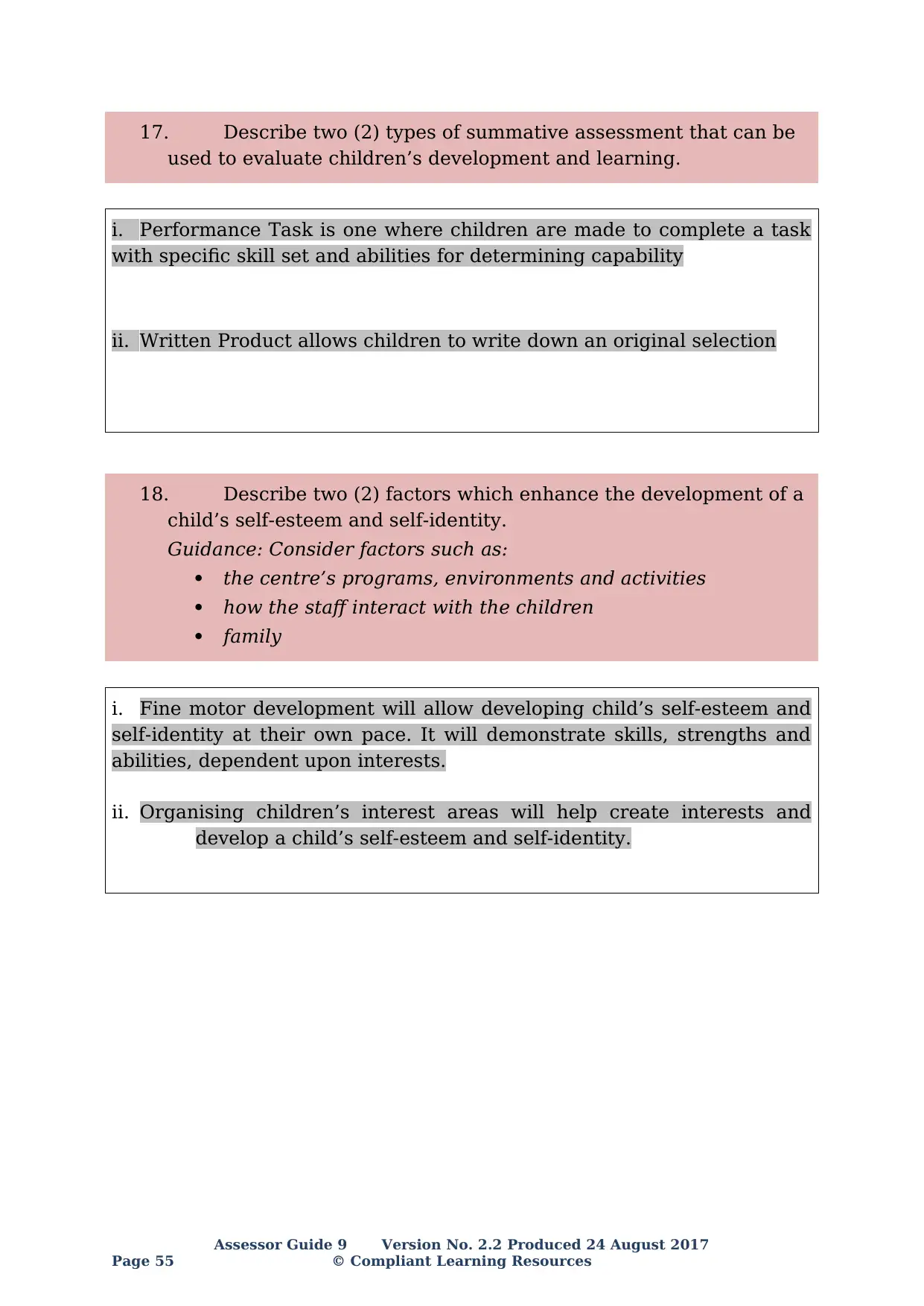
17. Describe two (2) types of summative assessment that can be
used to evaluate children’s development and learning.
i. Performance Task is one where children are made to complete a task
with specific skill set and abilities for determining capability
ii. Written Product allows children to write down an original selection
18. Describe two (2) factors which enhance the development of a
child’s self-esteem and self-identity.
Guidance: Consider factors such as:
the centre’s programs, environments and activities
how the staff interact with the children
family
i. Fine motor development will allow developing child’s self-esteem and
self-identity at their own pace. It will demonstrate skills, strengths and
abilities, dependent upon interests.
ii. Organising children’s interest areas will help create interests and
develop a child’s self-esteem and self-identity.
Assessor Guide 9 Version No. 2.2 Produced 24 August 2017
Page 55 © Compliant Learning Resources
used to evaluate children’s development and learning.
i. Performance Task is one where children are made to complete a task
with specific skill set and abilities for determining capability
ii. Written Product allows children to write down an original selection
18. Describe two (2) factors which enhance the development of a
child’s self-esteem and self-identity.
Guidance: Consider factors such as:
the centre’s programs, environments and activities
how the staff interact with the children
family
i. Fine motor development will allow developing child’s self-esteem and
self-identity at their own pace. It will demonstrate skills, strengths and
abilities, dependent upon interests.
ii. Organising children’s interest areas will help create interests and
develop a child’s self-esteem and self-identity.
Assessor Guide 9 Version No. 2.2 Produced 24 August 2017
Page 55 © Compliant Learning Resources
Paraphrase This Document
Need a fresh take? Get an instant paraphrase of this document with our AI Paraphraser

PROJECT 1 – PLAN, DESIGN, AND IMPLEMENT
TWO CHILDCARE PROGRAMS
This project will guide you in planning,
designing, developing and implementing
three (3) programs for children in the
childcare centre.
Assessment Requirements:
To complete this task, you will need access to:
- A regulated childcare centre
- Three (3) children of varying ages
- Childcare Program: Planning, Design &
Implementation Form (provided via
intranet link)
- A vocational workplace supervisor to
confirm completion of the project in the
workplace
This project is divided into five steps. Each step is outlined with detailed steps
and guidance to help you successfully complete each task. These five steps are
as follows:
- Step 1: Pre-planning assessment
- Step 2: Planning
- Step 3: Design
- Step 4: Implementation
- Step 5: Post-implementation evaluation
Use the form provided in the link below to document successful completion of
this project:
CHC30113 and CHC50115 Skills Workbook Templates and Forms
(Note: If the link is not working, copy and paste the url to your browser:
http://compliantlearningresources.com.au/network/sparkling-stars/units/chcece30113-
certificate-iii-in-early-childhood-education-and-care/ece-course-resources-new/)
Username: learner Password: studyhard
Download: “Subject 9: Childcare Planning, Design, and Implementation Form”
Assessor Guide 9 Version No. 2.2 Produced 24 August 2017
© Compliant Learning Resources Page 56
TWO CHILDCARE PROGRAMS
This project will guide you in planning,
designing, developing and implementing
three (3) programs for children in the
childcare centre.
Assessment Requirements:
To complete this task, you will need access to:
- A regulated childcare centre
- Three (3) children of varying ages
- Childcare Program: Planning, Design &
Implementation Form (provided via
intranet link)
- A vocational workplace supervisor to
confirm completion of the project in the
workplace
This project is divided into five steps. Each step is outlined with detailed steps
and guidance to help you successfully complete each task. These five steps are
as follows:
- Step 1: Pre-planning assessment
- Step 2: Planning
- Step 3: Design
- Step 4: Implementation
- Step 5: Post-implementation evaluation
Use the form provided in the link below to document successful completion of
this project:
CHC30113 and CHC50115 Skills Workbook Templates and Forms
(Note: If the link is not working, copy and paste the url to your browser:
http://compliantlearningresources.com.au/network/sparkling-stars/units/chcece30113-
certificate-iii-in-early-childhood-education-and-care/ece-course-resources-new/)
Username: learner Password: studyhard
Download: “Subject 9: Childcare Planning, Design, and Implementation Form”
Assessor Guide 9 Version No. 2.2 Produced 24 August 2017
© Compliant Learning Resources Page 56

IMPORTANT REMINDER:
You are required to complete the following steps for three (3) children
of varying ages. You are required to complete and submit one Planning,
Design & Implementation Form for each child.
NOTE:
Before you start working on this project, secure necessary permissions
from your vocational workplace supervisor to plan, design and
implement a childcare program/curriculum for three children in the
centre as part of your vocational training. At the end of this project, you
must secure your supervisor’s signature to confirm completion of the
project in the workplace.
Step 1: Pre-planning assessment
Identify the three (3) children you will be working with on this project.
Conduct a brief assessment of the children’s learning, play and care needs to
guide you in planning a childcare program for each of them.
Complete Step 1 in the Planning, Design & Implementation Form.
For your reference and guidance, see example of a completed form (Step 1)
below:
Name of Educator: Justine Price Group: 1 | 2
Step I: Pre-Planning Assessment
Write the names and ages of the children belonging to this group:
# Names Ages
1 Sherry Santos 3
2 Abigail Ciscar 4
3 Scott Rogers 5
Learning, Play and Developmental Needs:
I. List the children’s interests and play preferences:
Child 1 Loves pets and animals
Assessor Guide 9 Version No. 2.2 Produced 24 August 2017
Page 57 © Compliant Learning Resources
EXAMPLE ONLY
You are required to complete the following steps for three (3) children
of varying ages. You are required to complete and submit one Planning,
Design & Implementation Form for each child.
NOTE:
Before you start working on this project, secure necessary permissions
from your vocational workplace supervisor to plan, design and
implement a childcare program/curriculum for three children in the
centre as part of your vocational training. At the end of this project, you
must secure your supervisor’s signature to confirm completion of the
project in the workplace.
Step 1: Pre-planning assessment
Identify the three (3) children you will be working with on this project.
Conduct a brief assessment of the children’s learning, play and care needs to
guide you in planning a childcare program for each of them.
Complete Step 1 in the Planning, Design & Implementation Form.
For your reference and guidance, see example of a completed form (Step 1)
below:
Name of Educator: Justine Price Group: 1 | 2
Step I: Pre-Planning Assessment
Write the names and ages of the children belonging to this group:
# Names Ages
1 Sherry Santos 3
2 Abigail Ciscar 4
3 Scott Rogers 5
Learning, Play and Developmental Needs:
I. List the children’s interests and play preferences:
Child 1 Loves pets and animals
Assessor Guide 9 Version No. 2.2 Produced 24 August 2017
Page 57 © Compliant Learning Resources
EXAMPLE ONLY
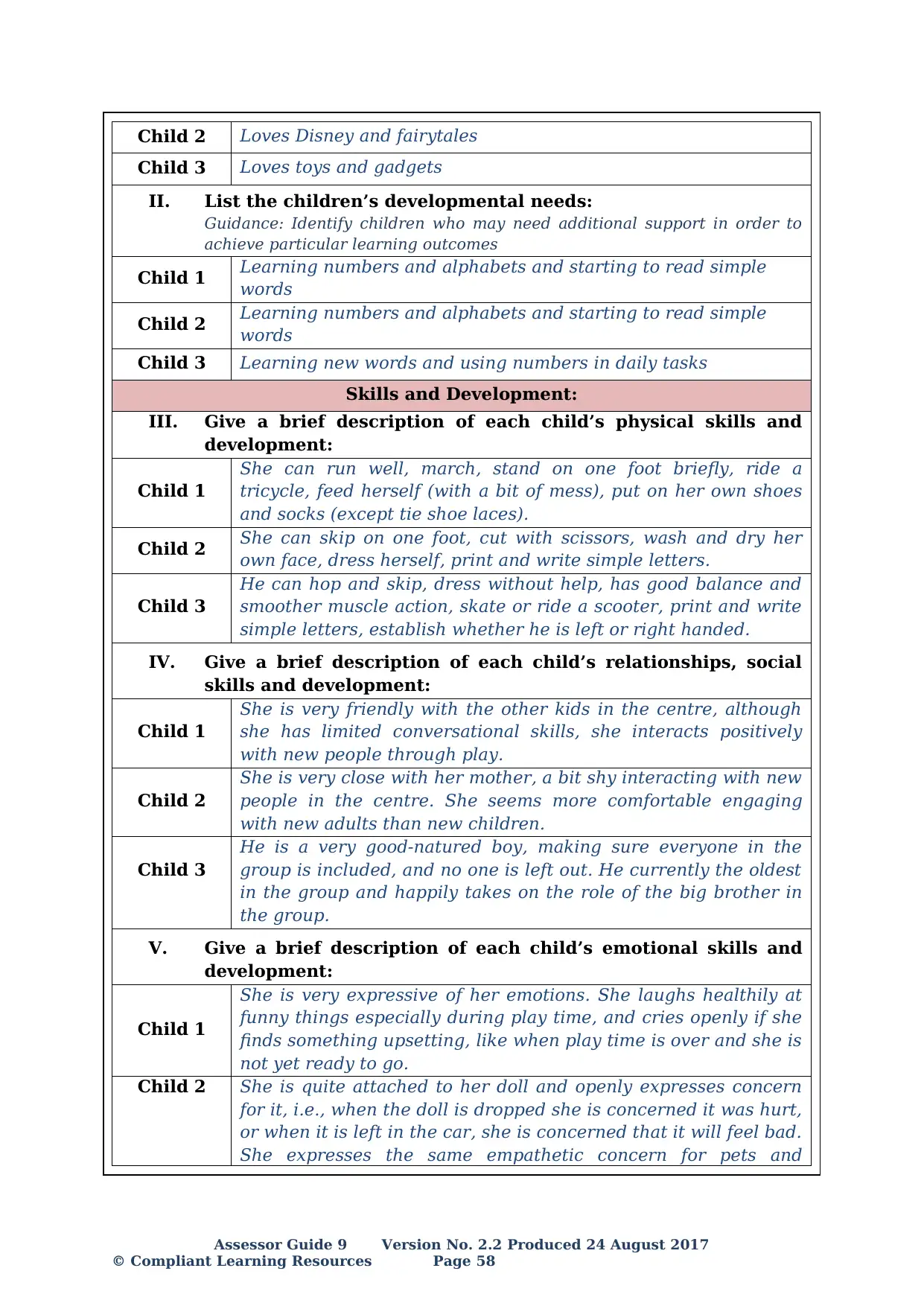
Child 2 Loves Disney and fairytales
Child 3 Loves toys and gadgets
II. List the children’s developmental needs:
Guidance: Identify children who may need additional support in order to
achieve particular learning outcomes
Child 1 Learning numbers and alphabets and starting to read simple
words
Child 2 Learning numbers and alphabets and starting to read simple
words
Child 3 Learning new words and using numbers in daily tasks
Skills and Development:
III. Give a brief description of each child’s physical skills and
development:
Child 1
She can run well, march, stand on one foot briefly, ride a
tricycle, feed herself (with a bit of mess), put on her own shoes
and socks (except tie shoe laces).
Child 2 She can skip on one foot, cut with scissors, wash and dry her
own face, dress herself, print and write simple letters.
Child 3
He can hop and skip, dress without help, has good balance and
smoother muscle action, skate or ride a scooter, print and write
simple letters, establish whether he is left or right handed.
IV. Give a brief description of each child’s relationships, social
skills and development:
Child 1
She is very friendly with the other kids in the centre, although
she has limited conversational skills, she interacts positively
with new people through play.
Child 2
She is very close with her mother, a bit shy interacting with new
people in the centre. She seems more comfortable engaging
with new adults than new children.
Child 3
He is a very good-natured boy, making sure everyone in the
group is included, and no one is left out. He currently the oldest
in the group and happily takes on the role of the big brother in
the group.
V. Give a brief description of each child’s emotional skills and
development:
Child 1
She is very expressive of her emotions. She laughs healthily at
funny things especially during play time, and cries openly if she
finds something upsetting, like when play time is over and she is
not yet ready to go.
Child 2 She is quite attached to her doll and openly expresses concern
for it, i.e., when the doll is dropped she is concerned it was hurt,
or when it is left in the car, she is concerned that it will feel bad.
She expresses the same empathetic concern for pets and
Assessor Guide 9 Version No. 2.2 Produced 24 August 2017
© Compliant Learning Resources Page 58
Child 3 Loves toys and gadgets
II. List the children’s developmental needs:
Guidance: Identify children who may need additional support in order to
achieve particular learning outcomes
Child 1 Learning numbers and alphabets and starting to read simple
words
Child 2 Learning numbers and alphabets and starting to read simple
words
Child 3 Learning new words and using numbers in daily tasks
Skills and Development:
III. Give a brief description of each child’s physical skills and
development:
Child 1
She can run well, march, stand on one foot briefly, ride a
tricycle, feed herself (with a bit of mess), put on her own shoes
and socks (except tie shoe laces).
Child 2 She can skip on one foot, cut with scissors, wash and dry her
own face, dress herself, print and write simple letters.
Child 3
He can hop and skip, dress without help, has good balance and
smoother muscle action, skate or ride a scooter, print and write
simple letters, establish whether he is left or right handed.
IV. Give a brief description of each child’s relationships, social
skills and development:
Child 1
She is very friendly with the other kids in the centre, although
she has limited conversational skills, she interacts positively
with new people through play.
Child 2
She is very close with her mother, a bit shy interacting with new
people in the centre. She seems more comfortable engaging
with new adults than new children.
Child 3
He is a very good-natured boy, making sure everyone in the
group is included, and no one is left out. He currently the oldest
in the group and happily takes on the role of the big brother in
the group.
V. Give a brief description of each child’s emotional skills and
development:
Child 1
She is very expressive of her emotions. She laughs healthily at
funny things especially during play time, and cries openly if she
finds something upsetting, like when play time is over and she is
not yet ready to go.
Child 2 She is quite attached to her doll and openly expresses concern
for it, i.e., when the doll is dropped she is concerned it was hurt,
or when it is left in the car, she is concerned that it will feel bad.
She expresses the same empathetic concern for pets and
Assessor Guide 9 Version No. 2.2 Produced 24 August 2017
© Compliant Learning Resources Page 58
Secure Best Marks with AI Grader
Need help grading? Try our AI Grader for instant feedback on your assignments.
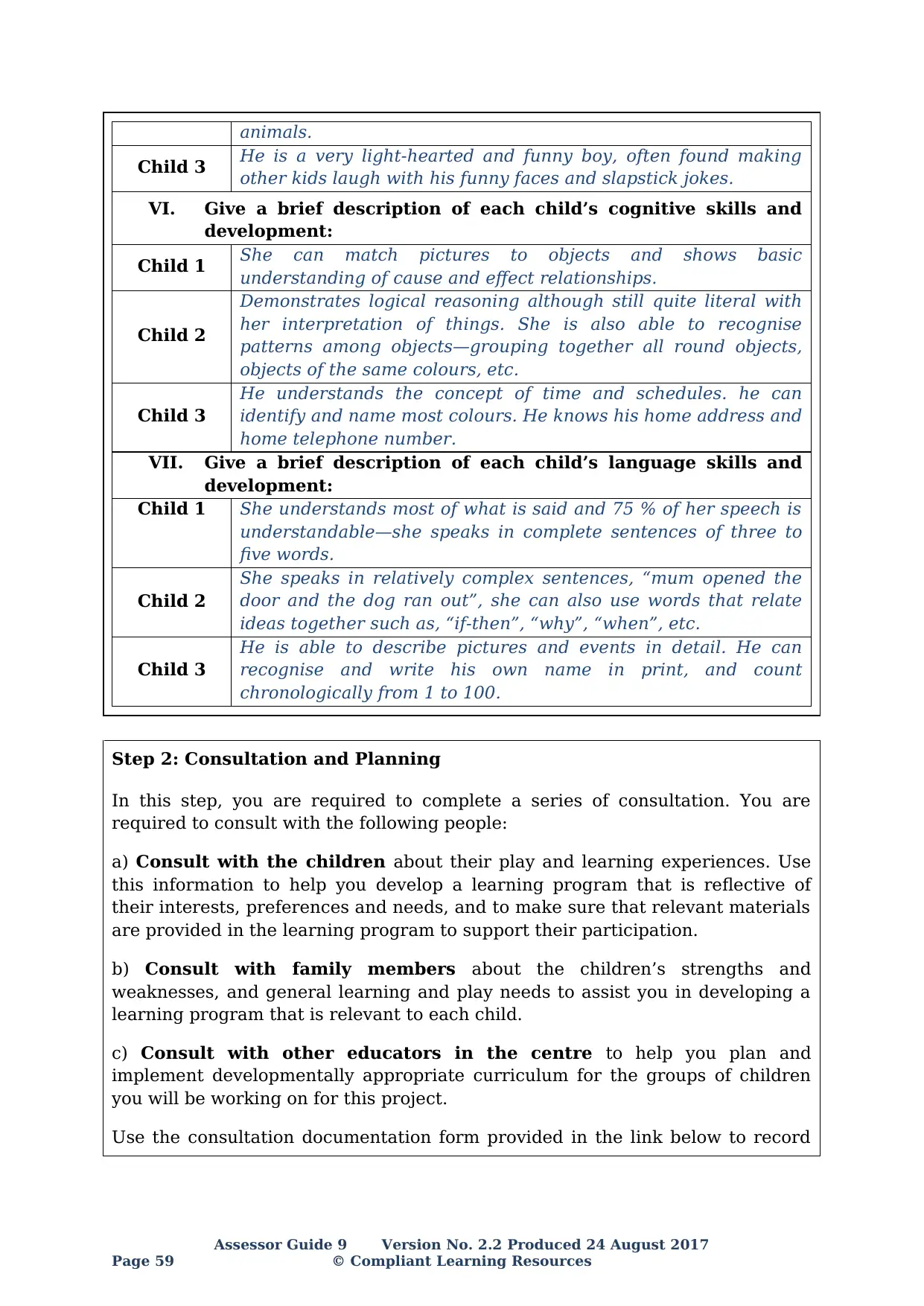
animals.
Child 3 He is a very light-hearted and funny boy, often found making
other kids laugh with his funny faces and slapstick jokes.
VI. Give a brief description of each child’s cognitive skills and
development:
Child 1 She can match pictures to objects and shows basic
understanding of cause and effect relationships.
Child 2
Demonstrates logical reasoning although still quite literal with
her interpretation of things. She is also able to recognise
patterns among objects—grouping together all round objects,
objects of the same colours, etc.
Child 3
He understands the concept of time and schedules. he can
identify and name most colours. He knows his home address and
home telephone number.
VII. Give a brief description of each child’s language skills and
development:
Child 1 She understands most of what is said and 75 % of her speech is
understandable—she speaks in complete sentences of three to
five words.
Child 2
She speaks in relatively complex sentences, “mum opened the
door and the dog ran out”, she can also use words that relate
ideas together such as, “if-then”, “why”, “when”, etc.
Child 3
He is able to describe pictures and events in detail. He can
recognise and write his own name in print, and count
chronologically from 1 to 100.
Step 2: Consultation and Planning
In this step, you are required to complete a series of consultation. You are
required to consult with the following people:
a) Consult with the children about their play and learning experiences. Use
this information to help you develop a learning program that is reflective of
their interests, preferences and needs, and to make sure that relevant materials
are provided in the learning program to support their participation.
b) Consult with family members about the children’s strengths and
weaknesses, and general learning and play needs to assist you in developing a
learning program that is relevant to each child.
c) Consult with other educators in the centre to help you plan and
implement developmentally appropriate curriculum for the groups of children
you will be working on for this project.
Use the consultation documentation form provided in the link below to record
Assessor Guide 9 Version No. 2.2 Produced 24 August 2017
Page 59 © Compliant Learning Resources
Child 3 He is a very light-hearted and funny boy, often found making
other kids laugh with his funny faces and slapstick jokes.
VI. Give a brief description of each child’s cognitive skills and
development:
Child 1 She can match pictures to objects and shows basic
understanding of cause and effect relationships.
Child 2
Demonstrates logical reasoning although still quite literal with
her interpretation of things. She is also able to recognise
patterns among objects—grouping together all round objects,
objects of the same colours, etc.
Child 3
He understands the concept of time and schedules. he can
identify and name most colours. He knows his home address and
home telephone number.
VII. Give a brief description of each child’s language skills and
development:
Child 1 She understands most of what is said and 75 % of her speech is
understandable—she speaks in complete sentences of three to
five words.
Child 2
She speaks in relatively complex sentences, “mum opened the
door and the dog ran out”, she can also use words that relate
ideas together such as, “if-then”, “why”, “when”, etc.
Child 3
He is able to describe pictures and events in detail. He can
recognise and write his own name in print, and count
chronologically from 1 to 100.
Step 2: Consultation and Planning
In this step, you are required to complete a series of consultation. You are
required to consult with the following people:
a) Consult with the children about their play and learning experiences. Use
this information to help you develop a learning program that is reflective of
their interests, preferences and needs, and to make sure that relevant materials
are provided in the learning program to support their participation.
b) Consult with family members about the children’s strengths and
weaknesses, and general learning and play needs to assist you in developing a
learning program that is relevant to each child.
c) Consult with other educators in the centre to help you plan and
implement developmentally appropriate curriculum for the groups of children
you will be working on for this project.
Use the consultation documentation form provided in the link below to record
Assessor Guide 9 Version No. 2.2 Produced 24 August 2017
Page 59 © Compliant Learning Resources
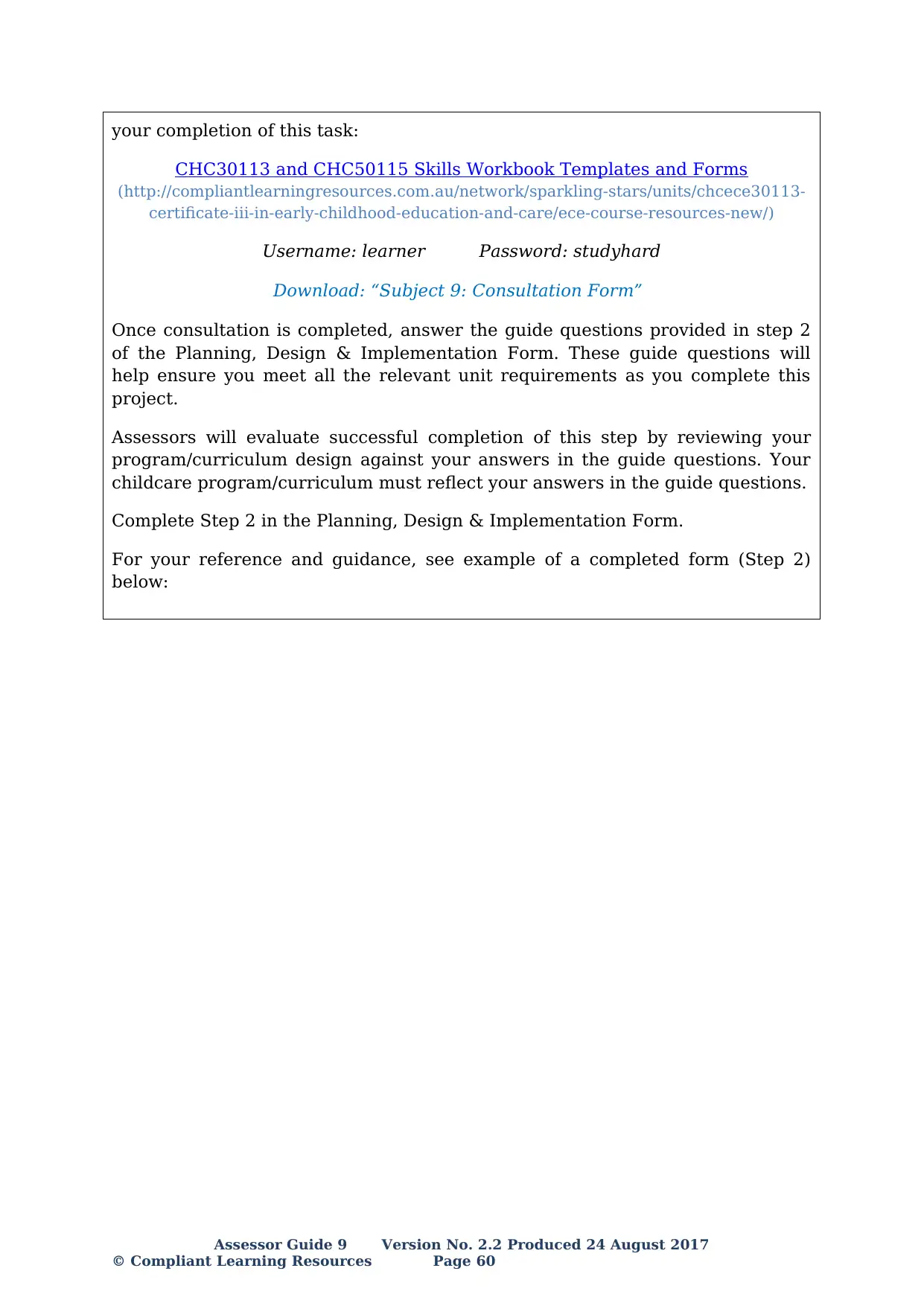
your completion of this task:
CHC30113 and CHC50115 Skills Workbook Templates and Forms
(http://compliantlearningresources.com.au/network/sparkling-stars/units/chcece30113-
certificate-iii-in-early-childhood-education-and-care/ece-course-resources-new/)
Username: learner Password: studyhard
Download: “Subject 9: Consultation Form”
Once consultation is completed, answer the guide questions provided in step 2
of the Planning, Design & Implementation Form. These guide questions will
help ensure you meet all the relevant unit requirements as you complete this
project.
Assessors will evaluate successful completion of this step by reviewing your
program/curriculum design against your answers in the guide questions. Your
childcare program/curriculum must reflect your answers in the guide questions.
Complete Step 2 in the Planning, Design & Implementation Form.
For your reference and guidance, see example of a completed form (Step 2)
below:
Assessor Guide 9 Version No. 2.2 Produced 24 August 2017
© Compliant Learning Resources Page 60
CHC30113 and CHC50115 Skills Workbook Templates and Forms
(http://compliantlearningresources.com.au/network/sparkling-stars/units/chcece30113-
certificate-iii-in-early-childhood-education-and-care/ece-course-resources-new/)
Username: learner Password: studyhard
Download: “Subject 9: Consultation Form”
Once consultation is completed, answer the guide questions provided in step 2
of the Planning, Design & Implementation Form. These guide questions will
help ensure you meet all the relevant unit requirements as you complete this
project.
Assessors will evaluate successful completion of this step by reviewing your
program/curriculum design against your answers in the guide questions. Your
childcare program/curriculum must reflect your answers in the guide questions.
Complete Step 2 in the Planning, Design & Implementation Form.
For your reference and guidance, see example of a completed form (Step 2)
below:
Assessor Guide 9 Version No. 2.2 Produced 24 August 2017
© Compliant Learning Resources Page 60
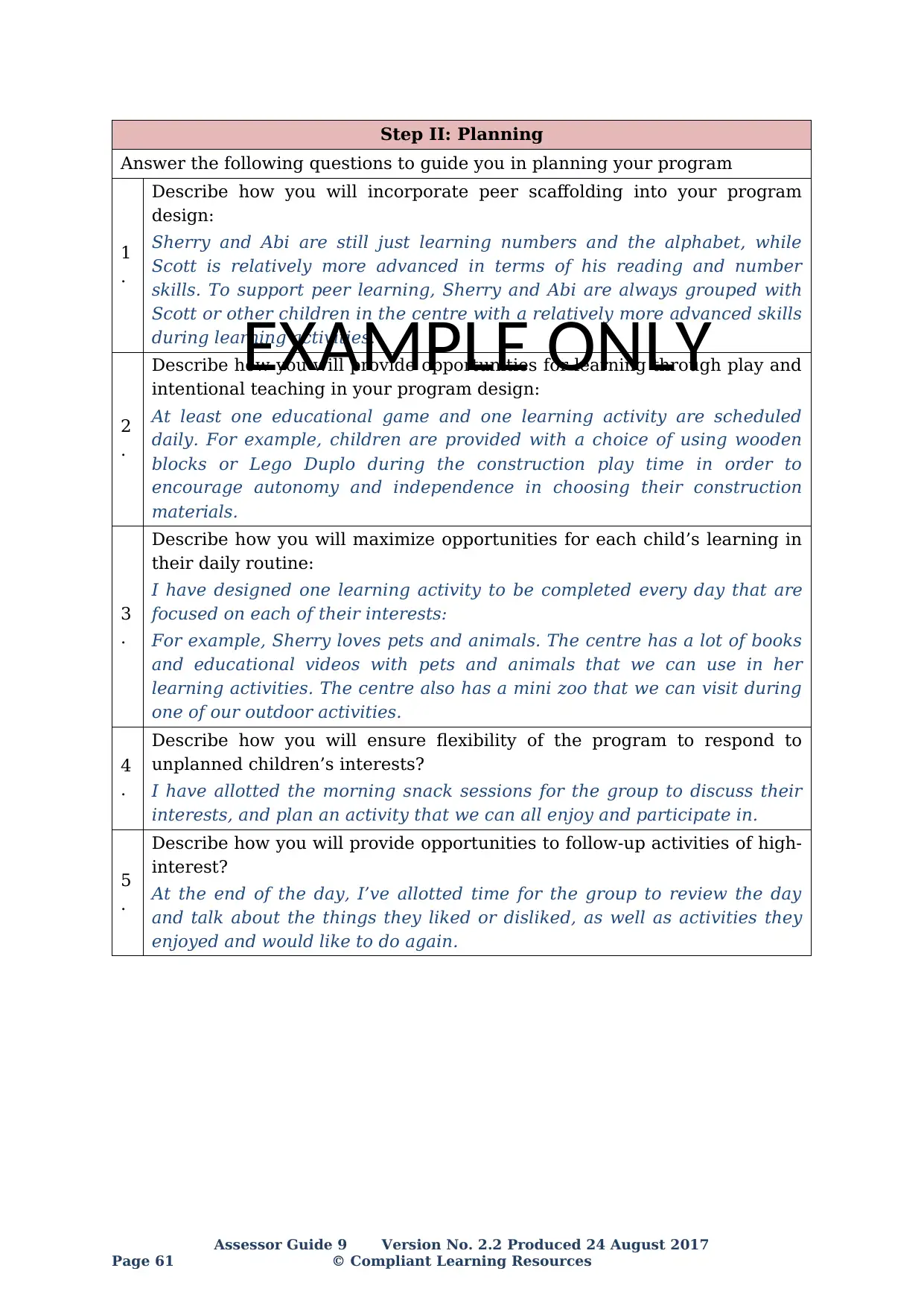
Step II: Planning
Answer the following questions to guide you in planning your program
1
.
Describe how you will incorporate peer scaffolding into your program
design:
Sherry and Abi are still just learning numbers and the alphabet, while
Scott is relatively more advanced in terms of his reading and number
skills. To support peer learning, Sherry and Abi are always grouped with
Scott or other children in the centre with a relatively more advanced skills
during learning activities.
2
.
Describe how you will provide opportunities for learning through play and
intentional teaching in your program design:
At least one educational game and one learning activity are scheduled
daily. For example, children are provided with a choice of using wooden
blocks or Lego Duplo during the construction play time in order to
encourage autonomy and independence in choosing their construction
materials.
3
.
Describe how you will maximize opportunities for each child’s learning in
their daily routine:
I have designed one learning activity to be completed every day that are
focused on each of their interests:
For example, Sherry loves pets and animals. The centre has a lot of books
and educational videos with pets and animals that we can use in her
learning activities. The centre also has a mini zoo that we can visit during
one of our outdoor activities.
4
.
Describe how you will ensure flexibility of the program to respond to
unplanned children’s interests?
I have allotted the morning snack sessions for the group to discuss their
interests, and plan an activity that we can all enjoy and participate in.
5
.
Describe how you will provide opportunities to follow-up activities of high-
interest?
At the end of the day, I’ve allotted time for the group to review the day
and talk about the things they liked or disliked, as well as activities they
enjoyed and would like to do again.
Assessor Guide 9 Version No. 2.2 Produced 24 August 2017
Page 61 © Compliant Learning Resources
EXAMPLE ONLY
Answer the following questions to guide you in planning your program
1
.
Describe how you will incorporate peer scaffolding into your program
design:
Sherry and Abi are still just learning numbers and the alphabet, while
Scott is relatively more advanced in terms of his reading and number
skills. To support peer learning, Sherry and Abi are always grouped with
Scott or other children in the centre with a relatively more advanced skills
during learning activities.
2
.
Describe how you will provide opportunities for learning through play and
intentional teaching in your program design:
At least one educational game and one learning activity are scheduled
daily. For example, children are provided with a choice of using wooden
blocks or Lego Duplo during the construction play time in order to
encourage autonomy and independence in choosing their construction
materials.
3
.
Describe how you will maximize opportunities for each child’s learning in
their daily routine:
I have designed one learning activity to be completed every day that are
focused on each of their interests:
For example, Sherry loves pets and animals. The centre has a lot of books
and educational videos with pets and animals that we can use in her
learning activities. The centre also has a mini zoo that we can visit during
one of our outdoor activities.
4
.
Describe how you will ensure flexibility of the program to respond to
unplanned children’s interests?
I have allotted the morning snack sessions for the group to discuss their
interests, and plan an activity that we can all enjoy and participate in.
5
.
Describe how you will provide opportunities to follow-up activities of high-
interest?
At the end of the day, I’ve allotted time for the group to review the day
and talk about the things they liked or disliked, as well as activities they
enjoyed and would like to do again.
Assessor Guide 9 Version No. 2.2 Produced 24 August 2017
Page 61 © Compliant Learning Resources
EXAMPLE ONLY
Paraphrase This Document
Need a fresh take? Get an instant paraphrase of this document with our AI Paraphraser
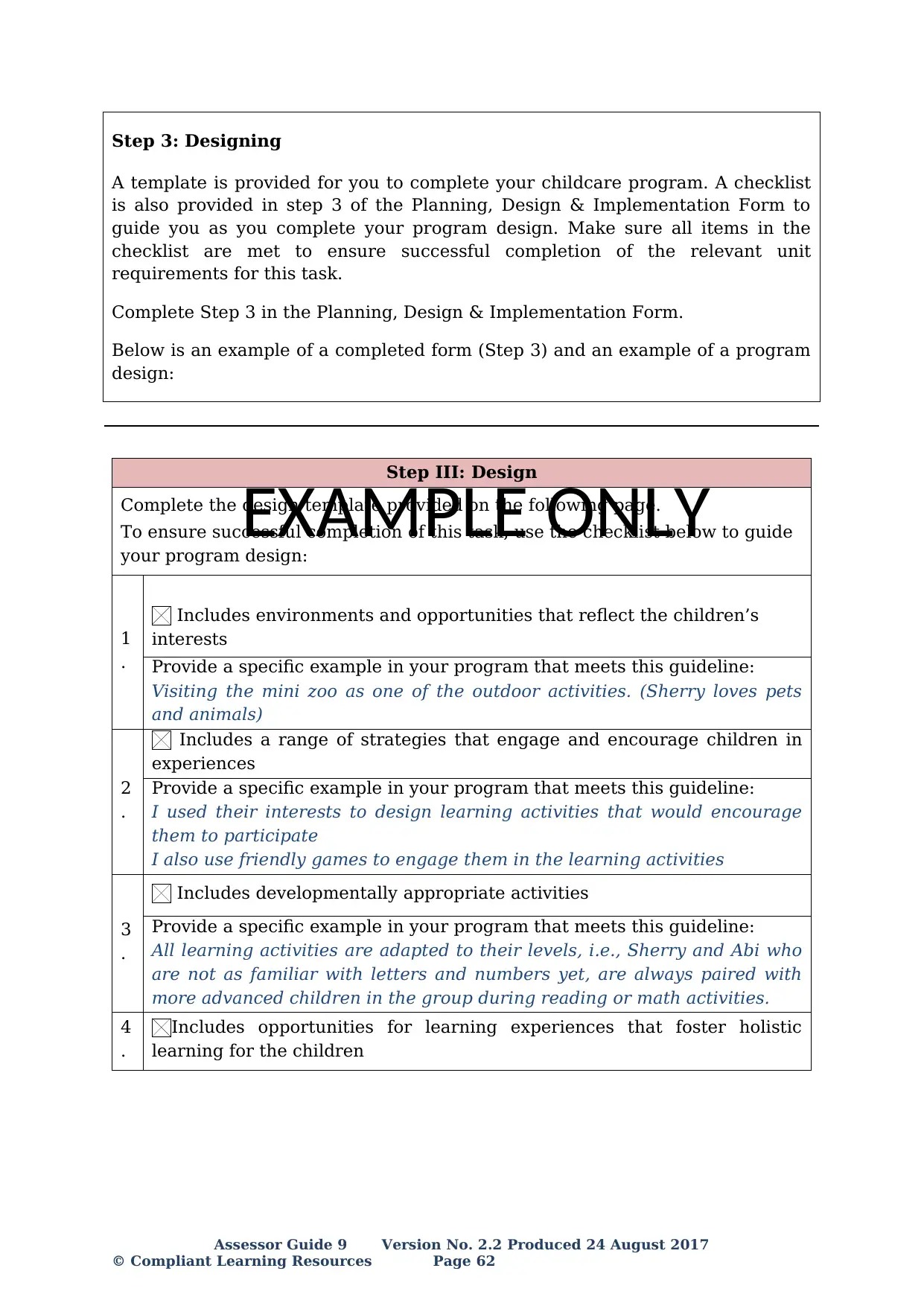
Step 3: Designing
A template is provided for you to complete your childcare program. A checklist
is also provided in step 3 of the Planning, Design & Implementation Form to
guide you as you complete your program design. Make sure all items in the
checklist are met to ensure successful completion of the relevant unit
requirements for this task.
Complete Step 3 in the Planning, Design & Implementation Form.
Below is an example of a completed form (Step 3) and an example of a program
design:
Step III: Design
Complete the design template provided on the following page.
To ensure successful completion of this task, use the checklist below to guide
your program design:
1
.
Includes environments and opportunities that reflect the children’s
interests
Provide a specific example in your program that meets this guideline:
Visiting the mini zoo as one of the outdoor activities. (Sherry loves pets
and animals)
2
.
Includes a range of strategies that engage and encourage children in
experiences
Provide a specific example in your program that meets this guideline:
I used their interests to design learning activities that would encourage
them to participate
I also use friendly games to engage them in the learning activities
3
.
Includes developmentally appropriate activities
Provide a specific example in your program that meets this guideline:
All learning activities are adapted to their levels, i.e., Sherry and Abi who
are not as familiar with letters and numbers yet, are always paired with
more advanced children in the group during reading or math activities.
4
.
Includes opportunities for learning experiences that foster holistic
learning for the children
Assessor Guide 9 Version No. 2.2 Produced 24 August 2017
© Compliant Learning Resources Page 62
EXAMPLE ONLY
A template is provided for you to complete your childcare program. A checklist
is also provided in step 3 of the Planning, Design & Implementation Form to
guide you as you complete your program design. Make sure all items in the
checklist are met to ensure successful completion of the relevant unit
requirements for this task.
Complete Step 3 in the Planning, Design & Implementation Form.
Below is an example of a completed form (Step 3) and an example of a program
design:
Step III: Design
Complete the design template provided on the following page.
To ensure successful completion of this task, use the checklist below to guide
your program design:
1
.
Includes environments and opportunities that reflect the children’s
interests
Provide a specific example in your program that meets this guideline:
Visiting the mini zoo as one of the outdoor activities. (Sherry loves pets
and animals)
2
.
Includes a range of strategies that engage and encourage children in
experiences
Provide a specific example in your program that meets this guideline:
I used their interests to design learning activities that would encourage
them to participate
I also use friendly games to engage them in the learning activities
3
.
Includes developmentally appropriate activities
Provide a specific example in your program that meets this guideline:
All learning activities are adapted to their levels, i.e., Sherry and Abi who
are not as familiar with letters and numbers yet, are always paired with
more advanced children in the group during reading or math activities.
4
.
Includes opportunities for learning experiences that foster holistic
learning for the children
Assessor Guide 9 Version No. 2.2 Produced 24 August 2017
© Compliant Learning Resources Page 62
EXAMPLE ONLY
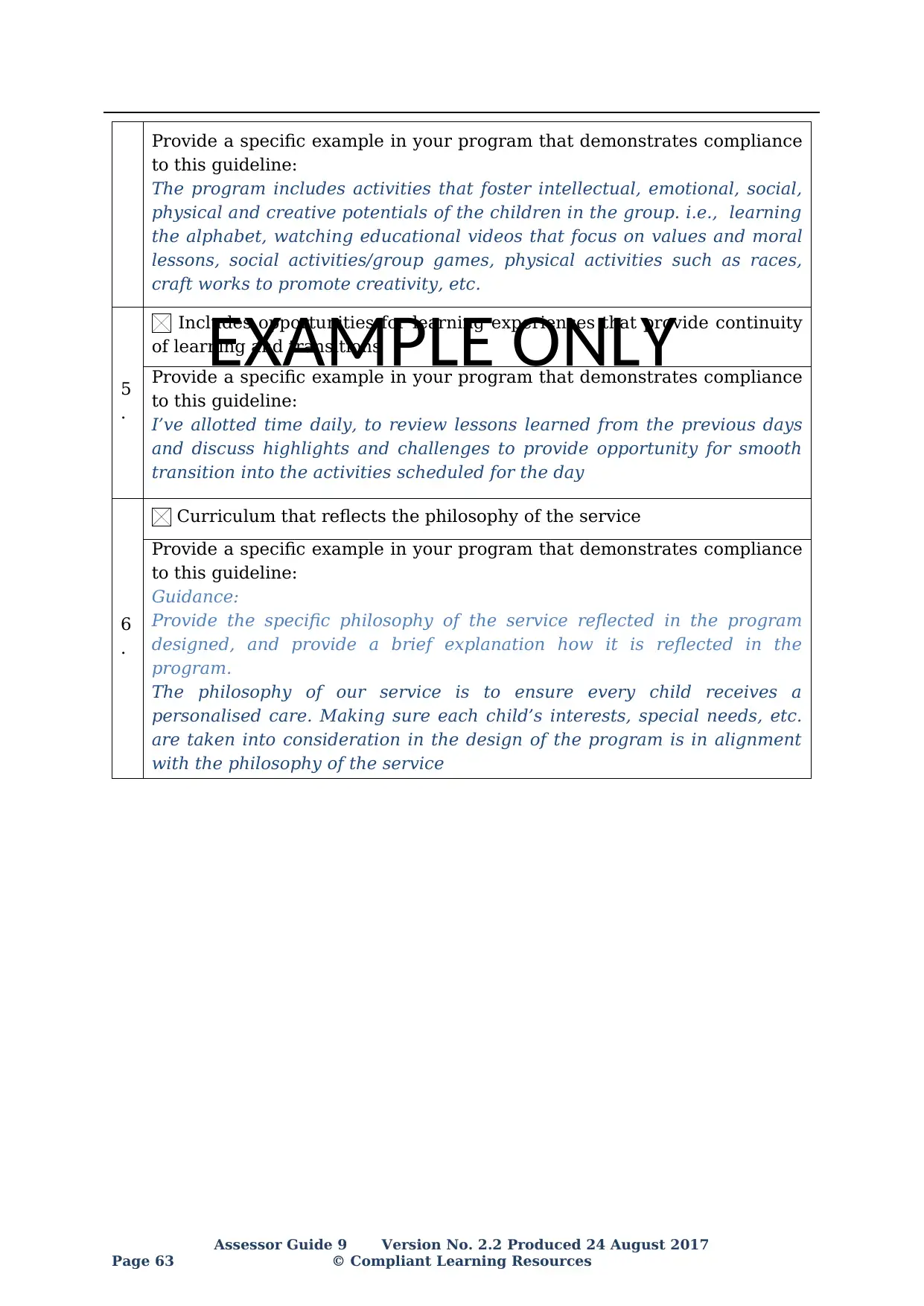
Provide a specific example in your program that demonstrates compliance
to this guideline:
The program includes activities that foster intellectual, emotional, social,
physical and creative potentials of the children in the group. i.e., learning
the alphabet, watching educational videos that focus on values and moral
lessons, social activities/group games, physical activities such as races,
craft works to promote creativity, etc.
5
.
Includes opportunities for learning experiences that provide continuity
of learning and transitions
Provide a specific example in your program that demonstrates compliance
to this guideline:
I’ve allotted time daily, to review lessons learned from the previous days
and discuss highlights and challenges to provide opportunity for smooth
transition into the activities scheduled for the day
6
.
Curriculum that reflects the philosophy of the service
Provide a specific example in your program that demonstrates compliance
to this guideline:
Guidance:
Provide the specific philosophy of the service reflected in the program
designed, and provide a brief explanation how it is reflected in the
program.
The philosophy of our service is to ensure every child receives a
personalised care. Making sure each child’s interests, special needs, etc.
are taken into consideration in the design of the program is in alignment
with the philosophy of the service
Assessor Guide 9 Version No. 2.2 Produced 24 August 2017
Page 63 © Compliant Learning Resources
EXAMPLE ONLY
to this guideline:
The program includes activities that foster intellectual, emotional, social,
physical and creative potentials of the children in the group. i.e., learning
the alphabet, watching educational videos that focus on values and moral
lessons, social activities/group games, physical activities such as races,
craft works to promote creativity, etc.
5
.
Includes opportunities for learning experiences that provide continuity
of learning and transitions
Provide a specific example in your program that demonstrates compliance
to this guideline:
I’ve allotted time daily, to review lessons learned from the previous days
and discuss highlights and challenges to provide opportunity for smooth
transition into the activities scheduled for the day
6
.
Curriculum that reflects the philosophy of the service
Provide a specific example in your program that demonstrates compliance
to this guideline:
Guidance:
Provide the specific philosophy of the service reflected in the program
designed, and provide a brief explanation how it is reflected in the
program.
The philosophy of our service is to ensure every child receives a
personalised care. Making sure each child’s interests, special needs, etc.
are taken into consideration in the design of the program is in alignment
with the philosophy of the service
Assessor Guide 9 Version No. 2.2 Produced 24 August 2017
Page 63 © Compliant Learning Resources
EXAMPLE ONLY
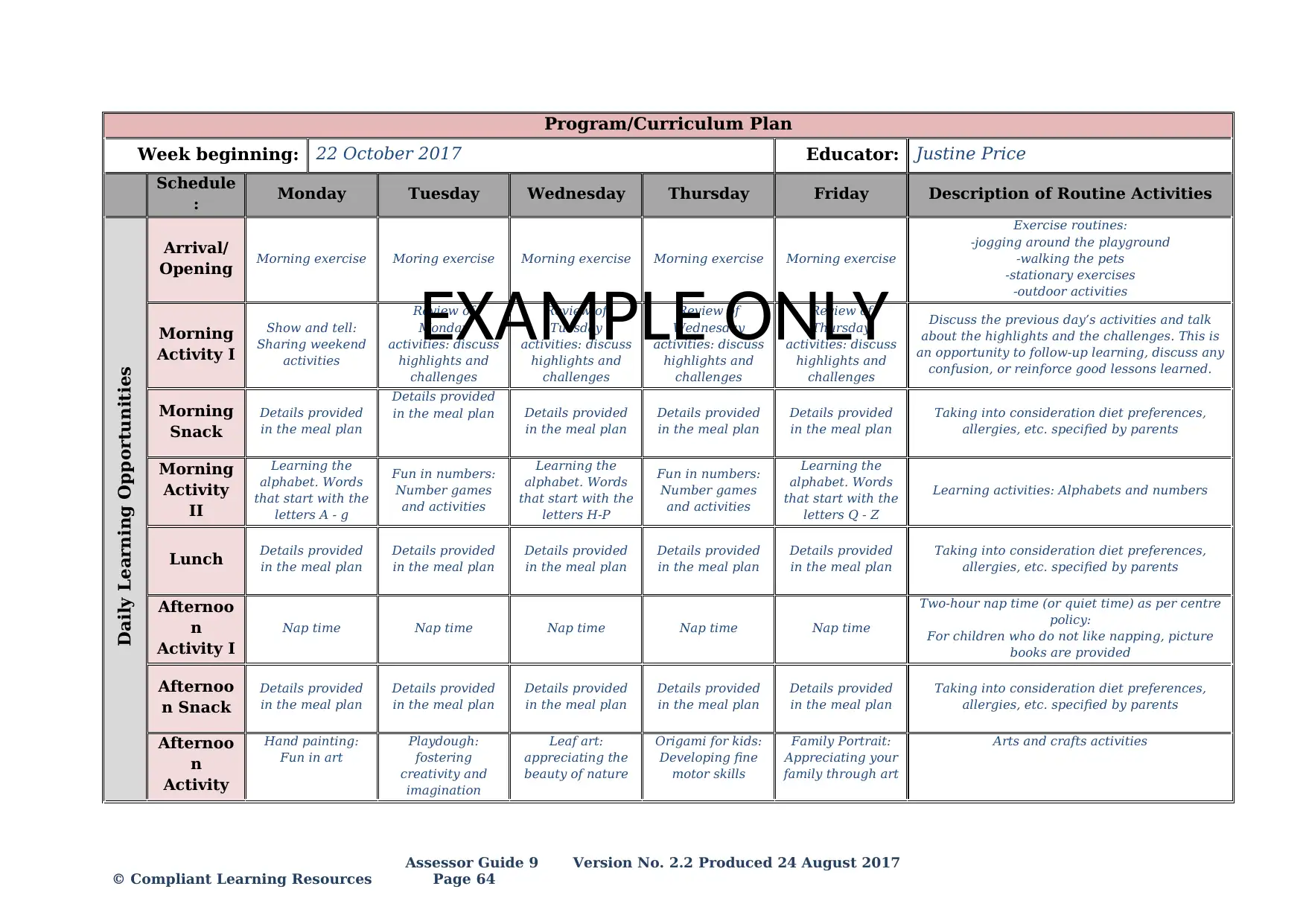
Program/Curriculum Plan
Week beginning: 22 October 2017 Educator: Justine Price
Schedule
: Monday Tuesday Wednesday Thursday Friday Description of Routine Activities
Daily Learning Opportunities
Arrival/
Opening Morning exercise Moring exercise Morning exercise Morning exercise Morning exercise
Exercise routines:
-jogging around the playground
-walking the pets
-stationary exercises
-outdoor activities
Morning
Activity I
Show and tell:
Sharing weekend
activities
Review of
Monday
activities: discuss
highlights and
challenges
Review of
Tuesday
activities: discuss
highlights and
challenges
Review of
Wednesday
activities: discuss
highlights and
challenges
Review of
Thursday
activities: discuss
highlights and
challenges
Discuss the previous day’s activities and talk
about the highlights and the challenges. This is
an opportunity to follow-up learning, discuss any
confusion, or reinforce good lessons learned.
Morning
Snack
Details provided
in the meal plan
Details provided
in the meal plan Details provided
in the meal plan
Details provided
in the meal plan
Details provided
in the meal plan
Taking into consideration diet preferences,
allergies, etc. specified by parents
Morning
Activity
II
Learning the
alphabet. Words
that start with the
letters A - g
Fun in numbers:
Number games
and activities
Learning the
alphabet. Words
that start with the
letters H-P
Fun in numbers:
Number games
and activities
Learning the
alphabet. Words
that start with the
letters Q - Z
Learning activities: Alphabets and numbers
Lunch Details provided
in the meal plan
Details provided
in the meal plan
Details provided
in the meal plan
Details provided
in the meal plan
Details provided
in the meal plan
Taking into consideration diet preferences,
allergies, etc. specified by parents
Afternoo
n
Activity I
Nap time Nap time Nap time Nap time Nap time
Two-hour nap time (or quiet time) as per centre
policy:
For children who do not like napping, picture
books are provided
Afternoo
n Snack
Details provided
in the meal plan
Details provided
in the meal plan
Details provided
in the meal plan
Details provided
in the meal plan
Details provided
in the meal plan
Taking into consideration diet preferences,
allergies, etc. specified by parents
Afternoo
n
Activity
Hand painting:
Fun in art
Playdough:
fostering
creativity and
imagination
Leaf art:
appreciating the
beauty of nature
Origami for kids:
Developing fine
motor skills
Family Portrait:
Appreciating your
family through art
Arts and crafts activities
Assessor Guide 9 Version No. 2.2 Produced 24 August 2017
© Compliant Learning Resources Page 64
EXAMPLE ONLY
Week beginning: 22 October 2017 Educator: Justine Price
Schedule
: Monday Tuesday Wednesday Thursday Friday Description of Routine Activities
Daily Learning Opportunities
Arrival/
Opening Morning exercise Moring exercise Morning exercise Morning exercise Morning exercise
Exercise routines:
-jogging around the playground
-walking the pets
-stationary exercises
-outdoor activities
Morning
Activity I
Show and tell:
Sharing weekend
activities
Review of
Monday
activities: discuss
highlights and
challenges
Review of
Tuesday
activities: discuss
highlights and
challenges
Review of
Wednesday
activities: discuss
highlights and
challenges
Review of
Thursday
activities: discuss
highlights and
challenges
Discuss the previous day’s activities and talk
about the highlights and the challenges. This is
an opportunity to follow-up learning, discuss any
confusion, or reinforce good lessons learned.
Morning
Snack
Details provided
in the meal plan
Details provided
in the meal plan Details provided
in the meal plan
Details provided
in the meal plan
Details provided
in the meal plan
Taking into consideration diet preferences,
allergies, etc. specified by parents
Morning
Activity
II
Learning the
alphabet. Words
that start with the
letters A - g
Fun in numbers:
Number games
and activities
Learning the
alphabet. Words
that start with the
letters H-P
Fun in numbers:
Number games
and activities
Learning the
alphabet. Words
that start with the
letters Q - Z
Learning activities: Alphabets and numbers
Lunch Details provided
in the meal plan
Details provided
in the meal plan
Details provided
in the meal plan
Details provided
in the meal plan
Details provided
in the meal plan
Taking into consideration diet preferences,
allergies, etc. specified by parents
Afternoo
n
Activity I
Nap time Nap time Nap time Nap time Nap time
Two-hour nap time (or quiet time) as per centre
policy:
For children who do not like napping, picture
books are provided
Afternoo
n Snack
Details provided
in the meal plan
Details provided
in the meal plan
Details provided
in the meal plan
Details provided
in the meal plan
Details provided
in the meal plan
Taking into consideration diet preferences,
allergies, etc. specified by parents
Afternoo
n
Activity
Hand painting:
Fun in art
Playdough:
fostering
creativity and
imagination
Leaf art:
appreciating the
beauty of nature
Origami for kids:
Developing fine
motor skills
Family Portrait:
Appreciating your
family through art
Arts and crafts activities
Assessor Guide 9 Version No. 2.2 Produced 24 August 2017
© Compliant Learning Resources Page 64
EXAMPLE ONLY
Secure Best Marks with AI Grader
Need help grading? Try our AI Grader for instant feedback on your assignments.
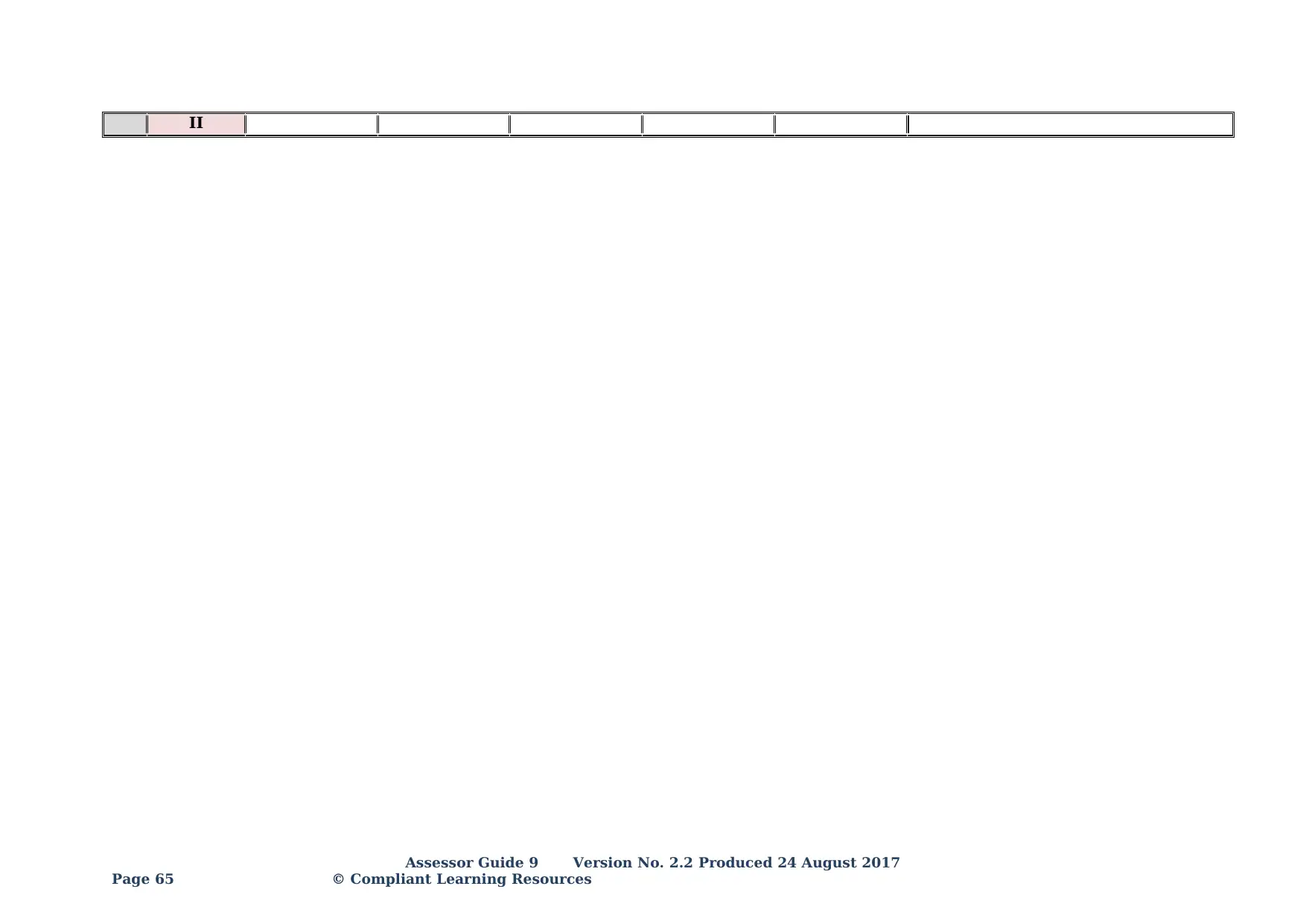
II
Assessor Guide 9 Version No. 2.2 Produced 24 August 2017
Page 65 © Compliant Learning Resources
Assessor Guide 9 Version No. 2.2 Produced 24 August 2017
Page 65 © Compliant Learning Resources

Step 4: Implementation
Implement your program design. Make sure your vocational workplace
supervisor is able to witness and observe you complete this project as you will
be requiring his or her signature to confirm your successful completion of the
said task in the workplace.
To document his or her confirmation, complete step 4 of the Planning, Design &
Implementation Form, and have your supervisor affix his complete name and
signature, as well as the date signed, after you complete the implementation of
your program
Step 5: Post-implementation evaluation
Step 5 will guide you in evaluating the childcare program you have
planned, designed and implemented throughout steps 1 to 4.
Step 5 : Post-Implementation Evaluation – Group 1
1.1 Plan for ways to monitor and assess children’s planned learning
experiences while following the program you designed and implemented.
Provide a brief step-by-step description of the plan you have developed:
1.2 Following the plan you have developed in previous item (1.1), monitor
and assess the children’s learning while following the program you
designed and implemented. Highlight the successes and challenges you
observed:
a) Successes:
b) Challenges:
2. Do the learning environment and materials used in your program support
all aspects of children’s learning? Yes | No
Explain your answer:
3. Do the learning environment and materials promote opportunities for
sustained shared thinking and collaborative learning? Yes | No
Explain your answer:
Assessor Guide 9 Version No. 2.2 Produced 24 August 2017
© Compliant Learning Resources Page 66
Implement your program design. Make sure your vocational workplace
supervisor is able to witness and observe you complete this project as you will
be requiring his or her signature to confirm your successful completion of the
said task in the workplace.
To document his or her confirmation, complete step 4 of the Planning, Design &
Implementation Form, and have your supervisor affix his complete name and
signature, as well as the date signed, after you complete the implementation of
your program
Step 5: Post-implementation evaluation
Step 5 will guide you in evaluating the childcare program you have
planned, designed and implemented throughout steps 1 to 4.
Step 5 : Post-Implementation Evaluation – Group 1
1.1 Plan for ways to monitor and assess children’s planned learning
experiences while following the program you designed and implemented.
Provide a brief step-by-step description of the plan you have developed:
1.2 Following the plan you have developed in previous item (1.1), monitor
and assess the children’s learning while following the program you
designed and implemented. Highlight the successes and challenges you
observed:
a) Successes:
b) Challenges:
2. Do the learning environment and materials used in your program support
all aspects of children’s learning? Yes | No
Explain your answer:
3. Do the learning environment and materials promote opportunities for
sustained shared thinking and collaborative learning? Yes | No
Explain your answer:
Assessor Guide 9 Version No. 2.2 Produced 24 August 2017
© Compliant Learning Resources Page 66
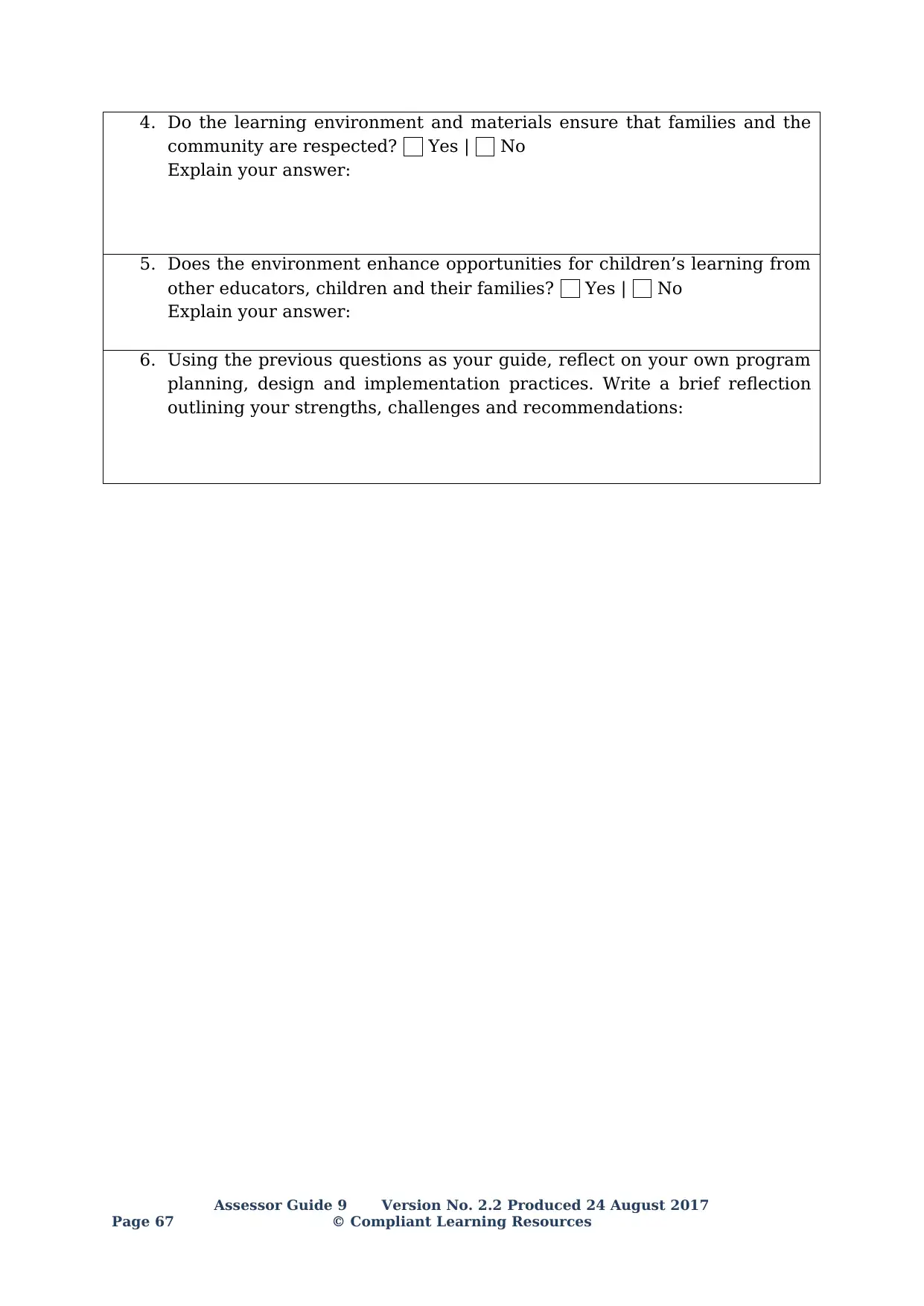
4. Do the learning environment and materials ensure that families and the
community are respected? Yes | No
Explain your answer:
5. Does the environment enhance opportunities for children’s learning from
other educators, children and their families? Yes | No
Explain your answer:
6. Using the previous questions as your guide, reflect on your own program
planning, design and implementation practices. Write a brief reflection
outlining your strengths, challenges and recommendations:
Assessor Guide 9 Version No. 2.2 Produced 24 August 2017
Page 67 © Compliant Learning Resources
community are respected? Yes | No
Explain your answer:
5. Does the environment enhance opportunities for children’s learning from
other educators, children and their families? Yes | No
Explain your answer:
6. Using the previous questions as your guide, reflect on your own program
planning, design and implementation practices. Write a brief reflection
outlining your strengths, challenges and recommendations:
Assessor Guide 9 Version No. 2.2 Produced 24 August 2017
Page 67 © Compliant Learning Resources
Paraphrase This Document
Need a fresh take? Get an instant paraphrase of this document with our AI Paraphraser
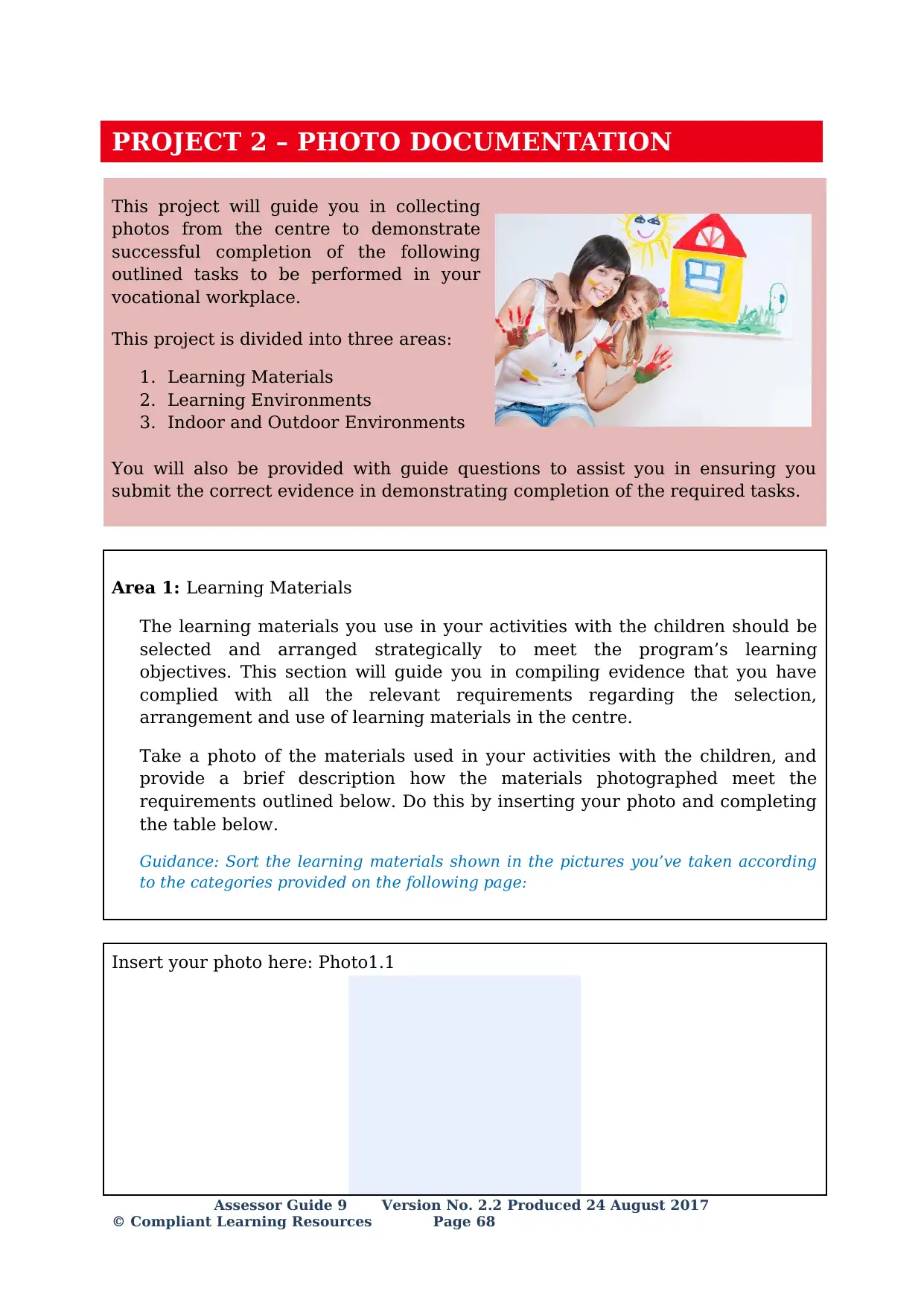
PROJECT 2 – PHOTO DOCUMENTATION
This project will guide you in collecting
photos from the centre to demonstrate
successful completion of the following
outlined tasks to be performed in your
vocational workplace.
This project is divided into three areas:
1. Learning Materials
2. Learning Environments
3. Indoor and Outdoor Environments
You will also be provided with guide questions to assist you in ensuring you
submit the correct evidence in demonstrating completion of the required tasks.
Area 1: Learning Materials
The learning materials you use in your activities with the children should be
selected and arranged strategically to meet the program’s learning
objectives. This section will guide you in compiling evidence that you have
complied with all the relevant requirements regarding the selection,
arrangement and use of learning materials in the centre.
Take a photo of the materials used in your activities with the children, and
provide a brief description how the materials photographed meet the
requirements outlined below. Do this by inserting your photo and completing
the table below.
Guidance: Sort the learning materials shown in the pictures you’ve taken according
to the categories provided on the following page:
Insert your photo here: Photo1.1
Assessor Guide 9 Version No. 2.2 Produced 24 August 2017
© Compliant Learning Resources Page 68
This project will guide you in collecting
photos from the centre to demonstrate
successful completion of the following
outlined tasks to be performed in your
vocational workplace.
This project is divided into three areas:
1. Learning Materials
2. Learning Environments
3. Indoor and Outdoor Environments
You will also be provided with guide questions to assist you in ensuring you
submit the correct evidence in demonstrating completion of the required tasks.
Area 1: Learning Materials
The learning materials you use in your activities with the children should be
selected and arranged strategically to meet the program’s learning
objectives. This section will guide you in compiling evidence that you have
complied with all the relevant requirements regarding the selection,
arrangement and use of learning materials in the centre.
Take a photo of the materials used in your activities with the children, and
provide a brief description how the materials photographed meet the
requirements outlined below. Do this by inserting your photo and completing
the table below.
Guidance: Sort the learning materials shown in the pictures you’ve taken according
to the categories provided on the following page:
Insert your photo here: Photo1.1
Assessor Guide 9 Version No. 2.2 Produced 24 August 2017
© Compliant Learning Resources Page 68

Assessor Guide 9 Version No. 2.2 Produced 24 August 2017
Page 69 © Compliant Learning Resources
Page 69 © Compliant Learning Resources
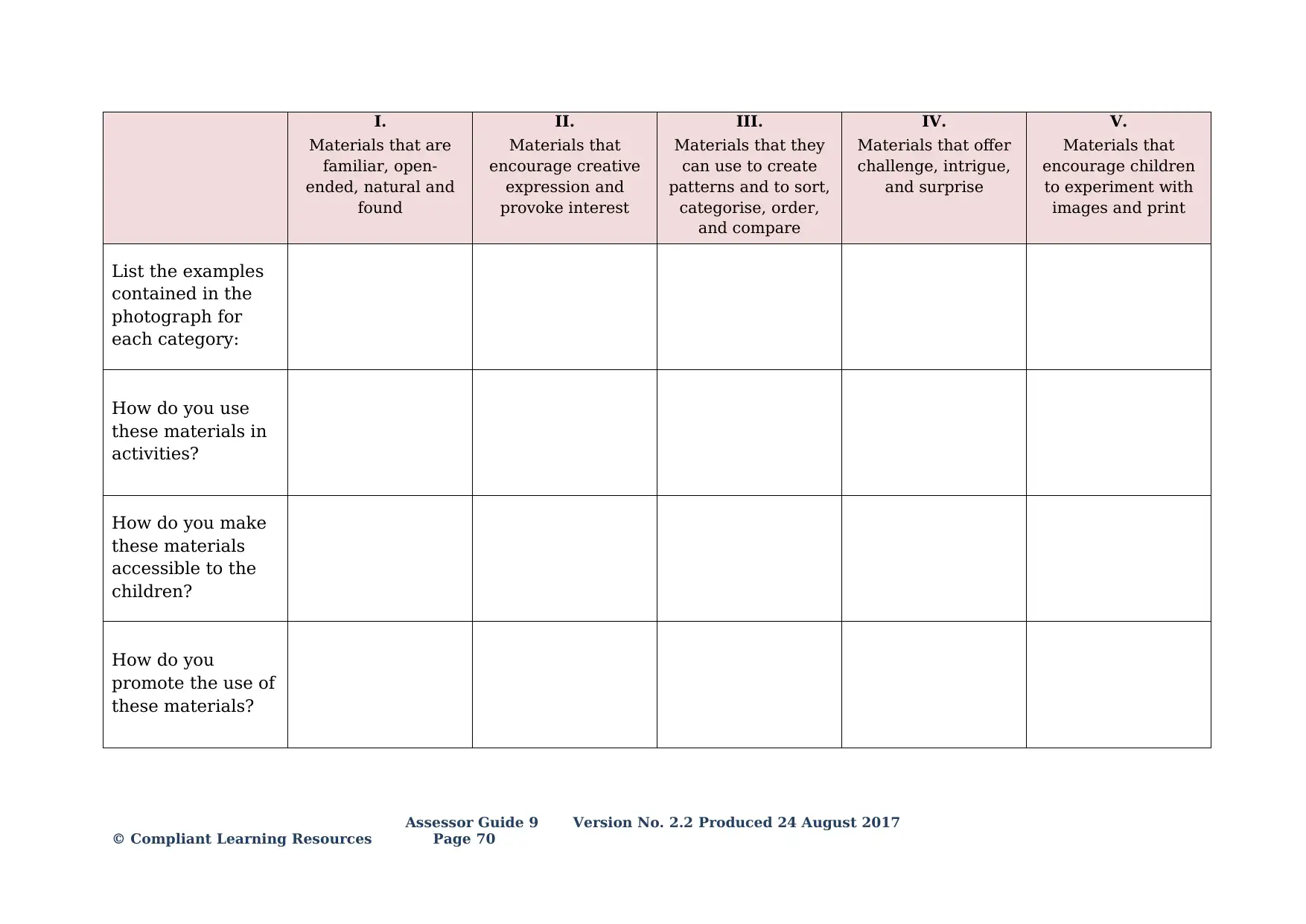
I.
Materials that are
familiar, open-
ended, natural and
found
II.
Materials that
encourage creative
expression and
provoke interest
III.
Materials that they
can use to create
patterns and to sort,
categorise, order,
and compare
IV.
Materials that offer
challenge, intrigue,
and surprise
V.
Materials that
encourage children
to experiment with
images and print
List the examples
contained in the
photograph for
each category:
How do you use
these materials in
activities?
How do you make
these materials
accessible to the
children?
How do you
promote the use of
these materials?
Assessor Guide 9 Version No. 2.2 Produced 24 August 2017
© Compliant Learning Resources Page 70
Materials that are
familiar, open-
ended, natural and
found
II.
Materials that
encourage creative
expression and
provoke interest
III.
Materials that they
can use to create
patterns and to sort,
categorise, order,
and compare
IV.
Materials that offer
challenge, intrigue,
and surprise
V.
Materials that
encourage children
to experiment with
images and print
List the examples
contained in the
photograph for
each category:
How do you use
these materials in
activities?
How do you make
these materials
accessible to the
children?
How do you
promote the use of
these materials?
Assessor Guide 9 Version No. 2.2 Produced 24 August 2017
© Compliant Learning Resources Page 70
Secure Best Marks with AI Grader
Need help grading? Try our AI Grader for instant feedback on your assignments.
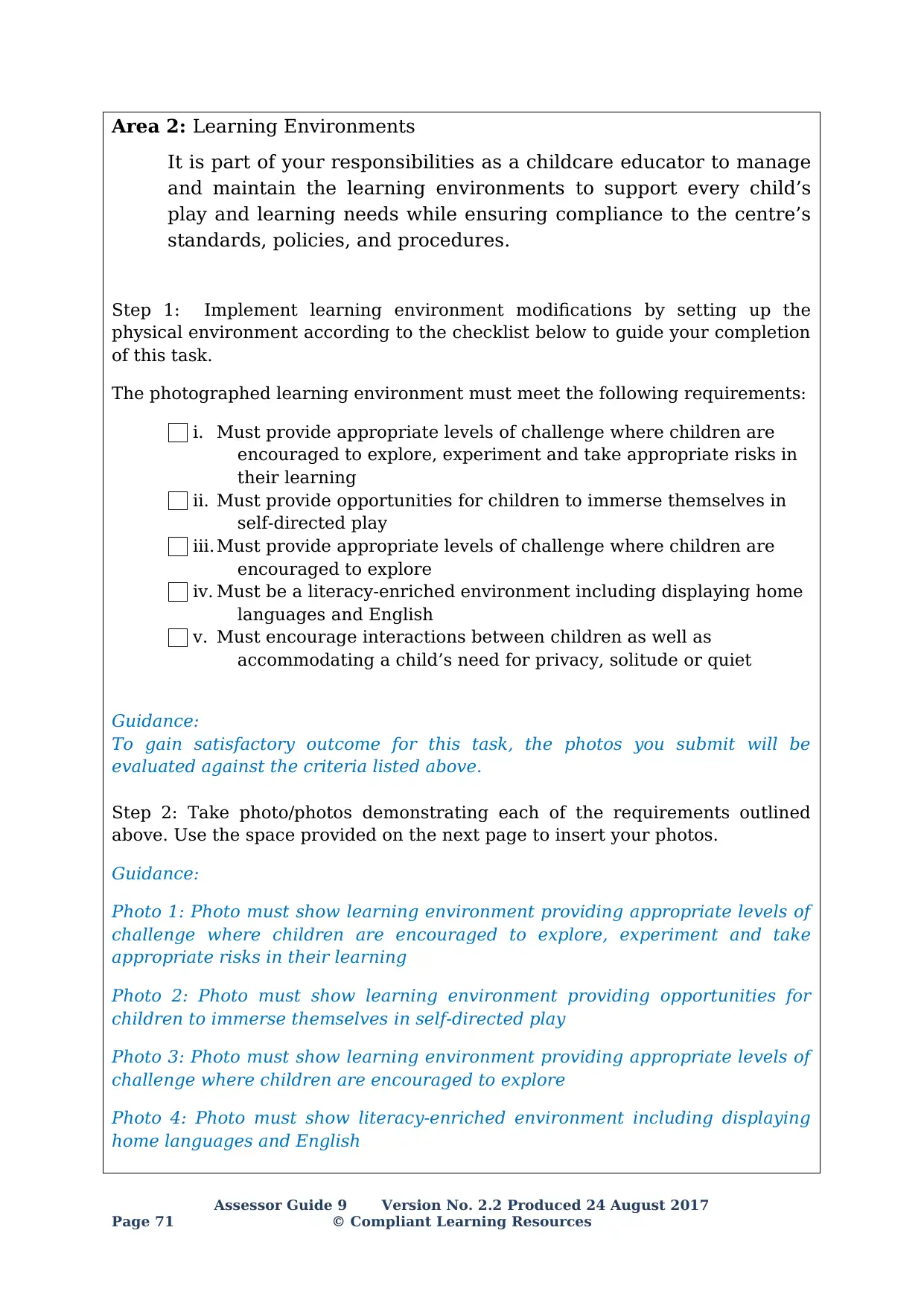
Area 2: Learning Environments
It is part of your responsibilities as a childcare educator to manage
and maintain the learning environments to support every child’s
play and learning needs while ensuring compliance to the centre’s
standards, policies, and procedures.
Step 1: Implement learning environment modifications by setting up the
physical environment according to the checklist below to guide your completion
of this task.
The photographed learning environment must meet the following requirements:
i. Must provide appropriate levels of challenge where children are
encouraged to explore, experiment and take appropriate risks in
their learning
ii. Must provide opportunities for children to immerse themselves in
self-directed play
iii. Must provide appropriate levels of challenge where children are
encouraged to explore
iv. Must be a literacy-enriched environment including displaying home
languages and English
v. Must encourage interactions between children as well as
accommodating a child’s need for privacy, solitude or quiet
Guidance:
To gain satisfactory outcome for this task, the photos you submit will be
evaluated against the criteria listed above.
Step 2: Take photo/photos demonstrating each of the requirements outlined
above. Use the space provided on the next page to insert your photos.
Guidance:
Photo 1: Photo must show learning environment providing appropriate levels of
challenge where children are encouraged to explore, experiment and take
appropriate risks in their learning
Photo 2: Photo must show learning environment providing opportunities for
children to immerse themselves in self-directed play
Photo 3: Photo must show learning environment providing appropriate levels of
challenge where children are encouraged to explore
Photo 4: Photo must show literacy-enriched environment including displaying
home languages and English
Assessor Guide 9 Version No. 2.2 Produced 24 August 2017
Page 71 © Compliant Learning Resources
It is part of your responsibilities as a childcare educator to manage
and maintain the learning environments to support every child’s
play and learning needs while ensuring compliance to the centre’s
standards, policies, and procedures.
Step 1: Implement learning environment modifications by setting up the
physical environment according to the checklist below to guide your completion
of this task.
The photographed learning environment must meet the following requirements:
i. Must provide appropriate levels of challenge where children are
encouraged to explore, experiment and take appropriate risks in
their learning
ii. Must provide opportunities for children to immerse themselves in
self-directed play
iii. Must provide appropriate levels of challenge where children are
encouraged to explore
iv. Must be a literacy-enriched environment including displaying home
languages and English
v. Must encourage interactions between children as well as
accommodating a child’s need for privacy, solitude or quiet
Guidance:
To gain satisfactory outcome for this task, the photos you submit will be
evaluated against the criteria listed above.
Step 2: Take photo/photos demonstrating each of the requirements outlined
above. Use the space provided on the next page to insert your photos.
Guidance:
Photo 1: Photo must show learning environment providing appropriate levels of
challenge where children are encouraged to explore, experiment and take
appropriate risks in their learning
Photo 2: Photo must show learning environment providing opportunities for
children to immerse themselves in self-directed play
Photo 3: Photo must show learning environment providing appropriate levels of
challenge where children are encouraged to explore
Photo 4: Photo must show literacy-enriched environment including displaying
home languages and English
Assessor Guide 9 Version No. 2.2 Produced 24 August 2017
Page 71 © Compliant Learning Resources
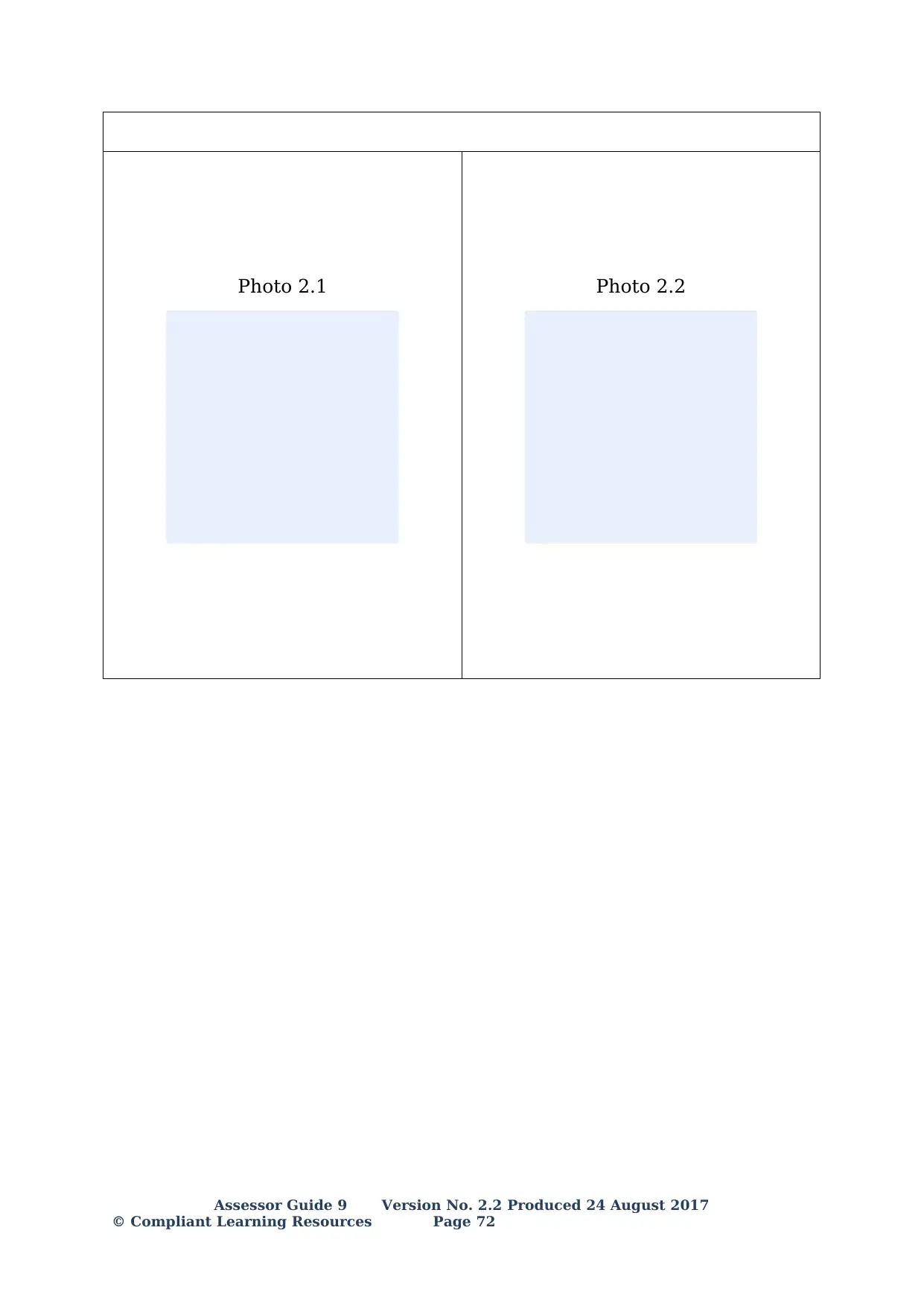
Photo 2.1 Photo 2.2
Assessor Guide 9 Version No. 2.2 Produced 24 August 2017
© Compliant Learning Resources Page 72
Assessor Guide 9 Version No. 2.2 Produced 24 August 2017
© Compliant Learning Resources Page 72

Photo 2.3 Photo 2.4
Assessor Guide 9 Version No. 2.2 Produced 24 August 2017
Page 73 © Compliant Learning Resources
Assessor Guide 9 Version No. 2.2 Produced 24 August 2017
Page 73 © Compliant Learning Resources
Paraphrase This Document
Need a fresh take? Get an instant paraphrase of this document with our AI Paraphraser
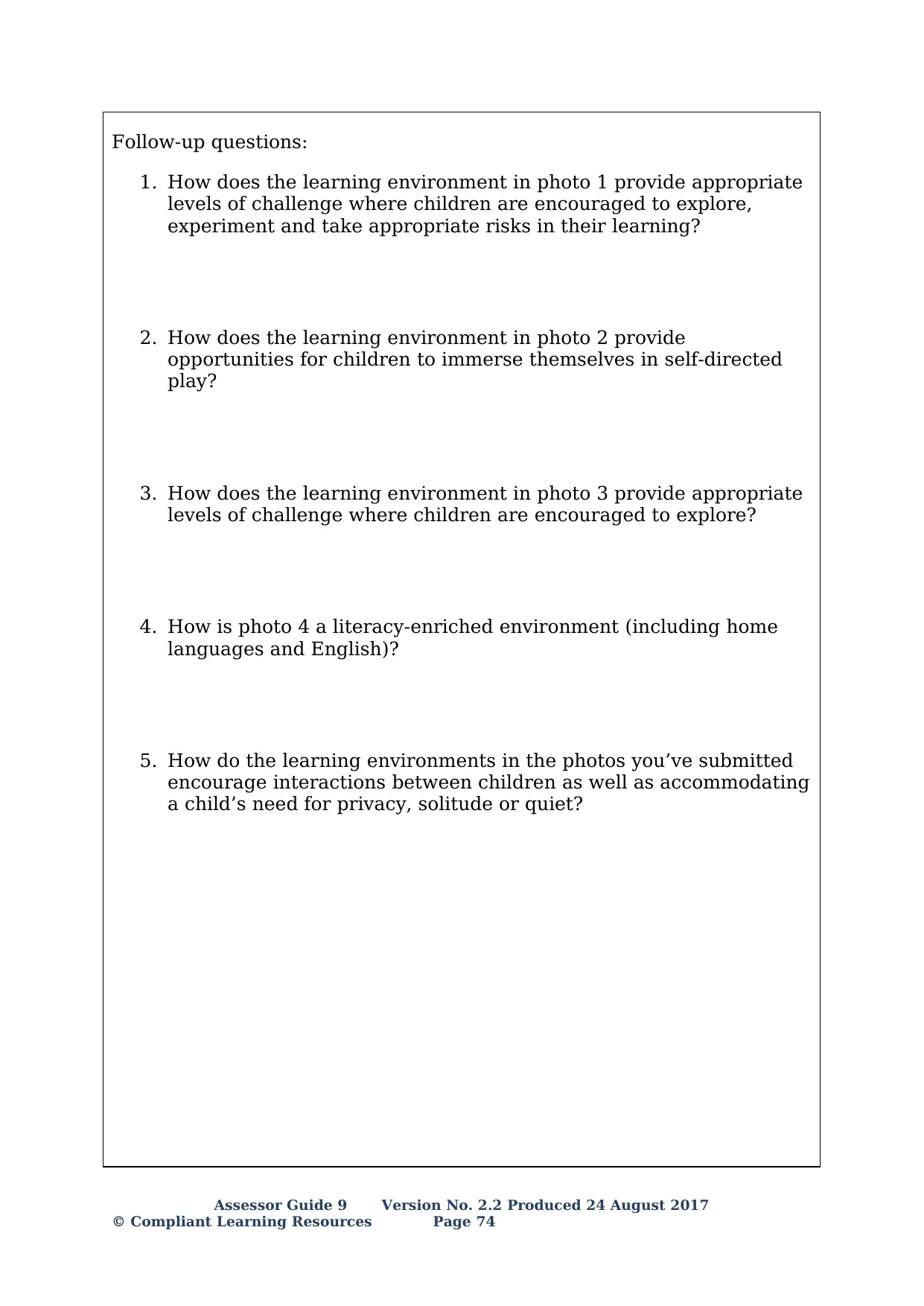
Follow-up questions:
1. How does the learning environment in photo 1 provide appropriate
levels of challenge where children are encouraged to explore,
experiment and take appropriate risks in their learning?
2. How does the learning environment in photo 2 provide
opportunities for children to immerse themselves in self-directed
play?
3. How does the learning environment in photo 3 provide appropriate
levels of challenge where children are encouraged to explore?
4. How is photo 4 a literacy-enriched environment (including home
languages and English)?
5. How do the learning environments in the photos you’ve submitted
encourage interactions between children as well as accommodating
a child’s need for privacy, solitude or quiet?
Assessor Guide 9 Version No. 2.2 Produced 24 August 2017
© Compliant Learning Resources Page 74
1. How does the learning environment in photo 1 provide appropriate
levels of challenge where children are encouraged to explore,
experiment and take appropriate risks in their learning?
2. How does the learning environment in photo 2 provide
opportunities for children to immerse themselves in self-directed
play?
3. How does the learning environment in photo 3 provide appropriate
levels of challenge where children are encouraged to explore?
4. How is photo 4 a literacy-enriched environment (including home
languages and English)?
5. How do the learning environments in the photos you’ve submitted
encourage interactions between children as well as accommodating
a child’s need for privacy, solitude or quiet?
Assessor Guide 9 Version No. 2.2 Produced 24 August 2017
© Compliant Learning Resources Page 74
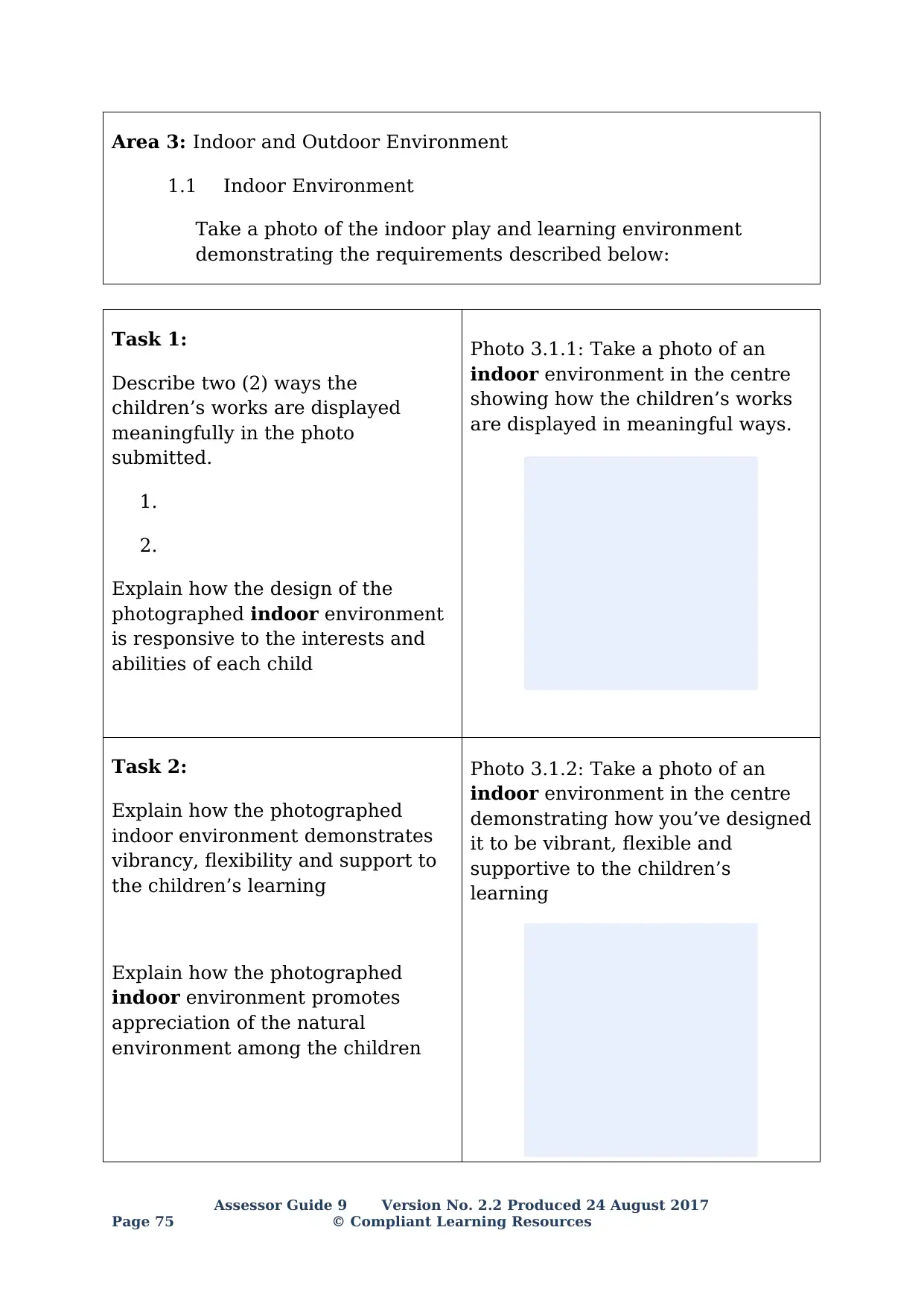
Area 3: Indoor and Outdoor Environment
1.1 Indoor Environment
Take a photo of the indoor play and learning environment
demonstrating the requirements described below:
Task 1:
Describe two (2) ways the
children’s works are displayed
meaningfully in the photo
submitted.
1.
2.
Explain how the design of the
photographed indoor environment
is responsive to the interests and
abilities of each child
Photo 3.1.1: Take a photo of an
indoor environment in the centre
showing how the children’s works
are displayed in meaningful ways.
Task 2:
Explain how the photographed
indoor environment demonstrates
vibrancy, flexibility and support to
the children’s learning
Explain how the photographed
indoor environment promotes
appreciation of the natural
environment among the children
Photo 3.1.2: Take a photo of an
indoor environment in the centre
demonstrating how you’ve designed
it to be vibrant, flexible and
supportive to the children’s
learning
Assessor Guide 9 Version No. 2.2 Produced 24 August 2017
Page 75 © Compliant Learning Resources
1.1 Indoor Environment
Take a photo of the indoor play and learning environment
demonstrating the requirements described below:
Task 1:
Describe two (2) ways the
children’s works are displayed
meaningfully in the photo
submitted.
1.
2.
Explain how the design of the
photographed indoor environment
is responsive to the interests and
abilities of each child
Photo 3.1.1: Take a photo of an
indoor environment in the centre
showing how the children’s works
are displayed in meaningful ways.
Task 2:
Explain how the photographed
indoor environment demonstrates
vibrancy, flexibility and support to
the children’s learning
Explain how the photographed
indoor environment promotes
appreciation of the natural
environment among the children
Photo 3.1.2: Take a photo of an
indoor environment in the centre
demonstrating how you’ve designed
it to be vibrant, flexible and
supportive to the children’s
learning
Assessor Guide 9 Version No. 2.2 Produced 24 August 2017
Page 75 © Compliant Learning Resources
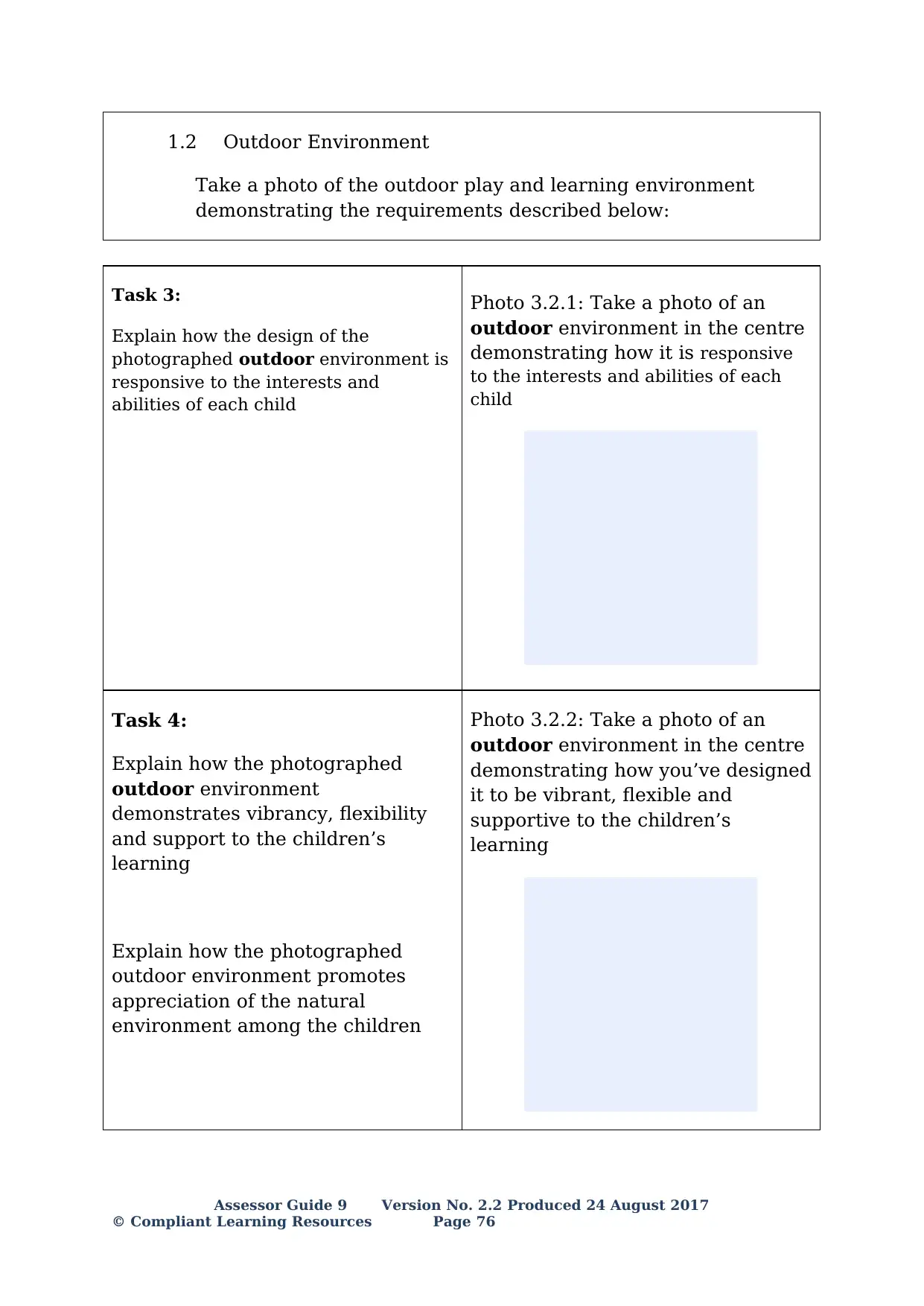
1.2 Outdoor Environment
Take a photo of the outdoor play and learning environment
demonstrating the requirements described below:
Task 3:
Explain how the design of the
photographed outdoor environment is
responsive to the interests and
abilities of each child
Photo 3.2.1: Take a photo of an
outdoor environment in the centre
demonstrating how it is responsive
to the interests and abilities of each
child
Task 4:
Explain how the photographed
outdoor environment
demonstrates vibrancy, flexibility
and support to the children’s
learning
Explain how the photographed
outdoor environment promotes
appreciation of the natural
environment among the children
Photo 3.2.2: Take a photo of an
outdoor environment in the centre
demonstrating how you’ve designed
it to be vibrant, flexible and
supportive to the children’s
learning
Assessor Guide 9 Version No. 2.2 Produced 24 August 2017
© Compliant Learning Resources Page 76
Take a photo of the outdoor play and learning environment
demonstrating the requirements described below:
Task 3:
Explain how the design of the
photographed outdoor environment is
responsive to the interests and
abilities of each child
Photo 3.2.1: Take a photo of an
outdoor environment in the centre
demonstrating how it is responsive
to the interests and abilities of each
child
Task 4:
Explain how the photographed
outdoor environment
demonstrates vibrancy, flexibility
and support to the children’s
learning
Explain how the photographed
outdoor environment promotes
appreciation of the natural
environment among the children
Photo 3.2.2: Take a photo of an
outdoor environment in the centre
demonstrating how you’ve designed
it to be vibrant, flexible and
supportive to the children’s
learning
Assessor Guide 9 Version No. 2.2 Produced 24 August 2017
© Compliant Learning Resources Page 76
Secure Best Marks with AI Grader
Need help grading? Try our AI Grader for instant feedback on your assignments.

WORKBOOK CHECKLIST
When you have completed this assessment workbook, review the
candidate’s assessment against the checklist below:
The candidate has completed all the assessments in the
workbook:
Knowledge Assessment
Project 1
Project 2
IMPORTANT REMINDER
Candidates must achieve a satisfactory result to ALL assessment tasks
to be awarded COMPETENT for the units relevant to this cluster.
To award the candidate competent in the units relevant to this subject,
the candidate must successfully complete all the requirements listed
above according to the prescribed benchmarks.
Assessor Guide 9 Version No. 2.2 Produced 24 August 2017
Page 77 © Compliant Learning Resources
When you have completed this assessment workbook, review the
candidate’s assessment against the checklist below:
The candidate has completed all the assessments in the
workbook:
Knowledge Assessment
Project 1
Project 2
IMPORTANT REMINDER
Candidates must achieve a satisfactory result to ALL assessment tasks
to be awarded COMPETENT for the units relevant to this cluster.
To award the candidate competent in the units relevant to this subject,
the candidate must successfully complete all the requirements listed
above according to the prescribed benchmarks.
Assessor Guide 9 Version No. 2.2 Produced 24 August 2017
Page 77 © Compliant Learning Resources
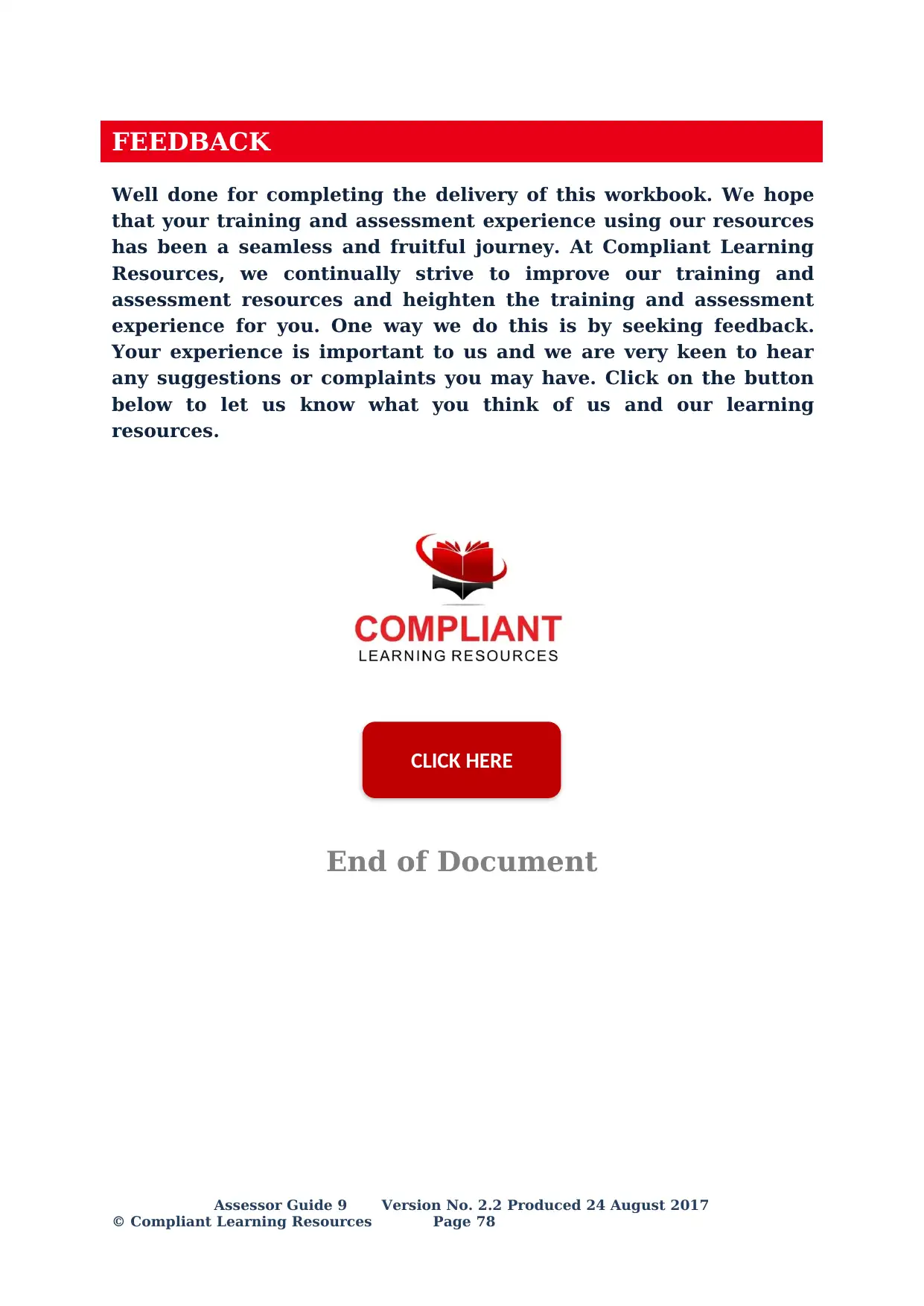
FEEDBACK
Well done for completing the delivery of this workbook. We hope
that your training and assessment experience using our resources
has been a seamless and fruitful journey. At Compliant Learning
Resources, we continually strive to improve our training and
assessment resources and heighten the training and assessment
experience for you. One way we do this is by seeking feedback.
Your experience is important to us and we are very keen to hear
any suggestions or complaints you may have. Click on the button
below to let us know what you think of us and our learning
resources.
End of Document
Assessor Guide 9 Version No. 2.2 Produced 24 August 2017
© Compliant Learning Resources Page 78
CLICK HERE
Well done for completing the delivery of this workbook. We hope
that your training and assessment experience using our resources
has been a seamless and fruitful journey. At Compliant Learning
Resources, we continually strive to improve our training and
assessment resources and heighten the training and assessment
experience for you. One way we do this is by seeking feedback.
Your experience is important to us and we are very keen to hear
any suggestions or complaints you may have. Click on the button
below to let us know what you think of us and our learning
resources.
End of Document
Assessor Guide 9 Version No. 2.2 Produced 24 August 2017
© Compliant Learning Resources Page 78
CLICK HERE
1 out of 78
Related Documents
Your All-in-One AI-Powered Toolkit for Academic Success.
+13062052269
info@desklib.com
Available 24*7 on WhatsApp / Email
![[object Object]](/_next/static/media/star-bottom.7253800d.svg)
Unlock your academic potential
© 2024 | Zucol Services PVT LTD | All rights reserved.





